General Grant’s leadership style was unique because of his military and political experience. His two terms as president covered the last eight years of the Radical Reconstruction period. His military leadership skills propelled him to the highest office of this country, yet history books portray his presidential tenure as a period of ineptitude, marred by scandal and corruption. His military successes were based on his ability to work with and through others, as well as dealing with difficult political situations. Why then, is Grant’s presidential service remembered as being so ineffective?
This question requires analysis in five areas:
1. Grant’s military and political careers
2. what Reconstruction was supposed to accomplish
3. the political, economic,
How Constructive was Grant’s Reconstruction?
this are:
1. the strategy and conducting of war he adopted
2. the handling of volunteer and Regular Army troops.
Many Union generals Lincoln initially relied on adhered to older strategies aimed at attacking cities or conquering land. Grant, however, realized the importance of attacking armies. He also realized that significant differences between Regular Army soldiers and their volunteer counterparts. Volunteers usually had no formal military training, rarely knew what their jobs entailed, and were not attuned to army style discipline. These distinctions required that they be commanded differently from regulars.1
political Union General John McClernand, from corps command during the Vicksburg campaign in 1863
3. Grant’s promotion to Lieutenant General and General-in-Chief of the Armies in March 1864, while his former boss, General Henry W. Halleck was shifted to Chief of Staff.
and social situations Grant inherited as president
4. the actions he took to promote Reconstruction and why
5. were these actions effective and efficient?
A seventeen-year-old Grant began his military career in 1839 at West Point. He served during both the Mexican War and the Civil War. Early mentors including Winfield Scott Hancock and Zachary Taylor enabled Grant to become a seasoned battle veteran and troop commander. Grant applied knowledge he gained from these experiences throughout his military career. Two examples of
Grant also spent time studying the personalities and both the strategic and tactical thinking of his peers and commanders. This allowed him to better understand the motives and likely courses of actions of former officers who were now Confederate Army leaders. Another skill was forging strong command partnerships across military service lines. This enabled him to conduct effective joint land and sea operations. Many military situations he encountered underscored the importance of politics as it related to the military.
Grant faced many political situations. Three of the most wellknown were:
1. his General Order Number 11 dated Dec. 17, 1862, ordering the expulsion of all Jews in his military district for alleged black market operations with the Confederacy
2. the dismissal of the very
In addition to serving as a general and president, Grant also served as Secretary of War and simultaneously as commanding general during the last five months of 1867.2 As frequently happens, successful military leaders are automatically assumed fit for high-level civilian leadership and Grant was no exception. In his memoirs, Grant asserts he never sought political office.

Grant learned many political nuances related to military operations the hard way. His order expelling Jews put both Grant and Lincoln in the precarious position of involving religious and social groups in the military command arena. After Lincoln rescinded the order, Grant obeyed and took what he learned from this experience and applied it to his presidency. Showing no ill will against those of the Jewish faith, Grant appointed several Jews as members of his cabinet.
General McClernand was one of the most politically powerful generals in the Union army. Grant was an academy graduate; McClernand was a volunteer. They never saw eye to eye on
CW N Vol. 46, No. 9 48 Pages, September 2020 $3.50 America’s Monthly Newspaper For Enthusiasts Inside this issue: 24 – American Battlefield Trust 47 – Advertiser Index 16 – Black Powder White Smoke 40 – Book Reviews 14 – Central Virginia BTrust 34 – Emerging Civil War 26 – The Graphic War 28 – Inspection, ARMS! 2 – Letters to the Editor 20 – The Source 18 – The Unfinished Fight 32 – This And That 22 – Through The Lens H Reconstruction . . . . . . . . . . . . see page 8
Gen. Ulysses S. Grant. Signed Constant Mayer. N.Y. 1867. Library of Congress.
by Richard Blumberg
CWN
Published by Historical Publications LLC
520 Folly Road, Suite 25 PMB 379, Charleston, SC 29412
800-777-1862 • Facebook.com/CivilWarNews mail@civilwarnews.com • www.civilwarnews.com
Advertising: 800-777-1862 • ads@civilwarnews.com


Jack W. Melton Jr. C. Peter & Kathryn Jorgensen
Publisher Founding Publishers
Editor: Lawrence E. Babits, Ph.D.
Advertising, Marketing & Assistant Editor: Peggy Melton
Columnists: Craig Barry, Joseph Bilby, Matthew Borowick, Salvatore Cilella, Stephanie Hagiwara, Gould Hagler, Tim Prince, John Sexton, and Michael K. Shaffer
Editorial & Photography Staff: Greg Biggs, Sandy Goss, Michael Kent, Bob Ruegsegger, Gregory L. Wade, Joan Wenner, J.D.
Civil War News (ISSN: 1053-1181) Copyright © 2020 by Historical Publications LLC is published 12 times per year by Historical Publications LLC, 520 Folly Road, Suite 25 PMB 379, Charleston, SC 29412. Monthly. Business and Editorial Offices: 520 Folly Road, Suite 25 PMB 379, Charleston, SC 29412, Accounting and Circulation
Offices: Historical Publications LLC, 520 Folly Road, Suite 25 PMB 379, Charleston, SC 29412. Call 800-777-1862 to subscribe.
Periodicals postage paid at U.S.P.S. 131 W. High St., Jefferson City, MO 65101.
POSTMASTER: Send address changes to: Historical Publications LLC
520 Folly Road Suite 25 PMB 379 Charleston, SC 29412
Display advertising rates and media kit on request.
The Civil War News is for your reading enjoyment. The views and opinions expressed herein are those of its authors, readers and advertisers and they do not necessarily reflect the official policy or position of Historical Publications, LLC, its owners and/or employees.
P
UBLISHERS :
Please send your book(s) for review to:
Civil War News
520 Folly Road, Suite 25 PMB 379 Charleston, SC 29412
Email cover image to bookreviews@civilwarnews.com. Civil War News cannot assure that unsolicited books will be assigned for review. Email bookreviews@civilwarnews.com for eligibility before mailing.
ADVERTISING INFO:
Email us at ads@civilwarnews.com Call 800-777-1862

MOVING?
Contact us to change your address so you don’t miss a single issue. mail@civilwarnews.com • 800-777-1862
SUBSCRIPTION RATES
U.S. Subscription rates are $38.50/year, $66/2
Letters Editor to the
TO THE EDITOR:
Just wanted to send you a quick note to say “thank you” for your recent editorial in the August CWN. You hit the nail right on the head about monuments. I have been furiously writing letters to Congress about the House Bill that calls for removing Confederate monuments on National Park Battlefields. I appreciate you summing up your thoughts; you did a better job than I have on this topic. Emerging Rev War (as you probably saw in the August CWN) put out a short statement on all monuments. The destruction of the Tomb of the Unknown Soldier in Philadelphia was very sad to see, our group feels pretty strongly about protecting these reflections of our past.
Rob Orrison
TO THE EDITOR:
I’m writing to comment on your column in the August issue. It was spot on. I couldn’t agree more. What would be egalitarian in this country would be to erect a monument to someone you wish to honor or memorialize and allow the rest of us to enjoy or appreciate those which some might find “offensive.” This “do everything my way” via so-called social justice is nothing more than outright tyranny, despotism, and in-egalitarianism, particularly so
NEW DIGITAL MAGAZINES:
Digital subscriptions for back issues of Civil War News (Archive 2012 to current issue are available now) and The Artilleryman magazine from Vol. 1, No. 1 to the current issue, will be available soon. The first twenty years of the publication and every issue from Summer 2015 to present, are now available as an online, yearly digital subscription. Over 6,500 pages of artillery information available on your phone, tablet, or computer. By the end of Summer 2020, this project will be entirely up to date, with over 160 issues.
If you are a student of the Civil War, artillery, a historian, researcher, author, or just interested in the hobby, you’ll find plenty of information within this massive archive.
To Subscribe Visit: CivilWarNews.com or ArtillerymanMagazine.com
Back Issues:
To purchase back issues of The Artilleryman magazine please visit our website at www.historicalpubs.com Mike@MKShows.com • www.MKShows.com
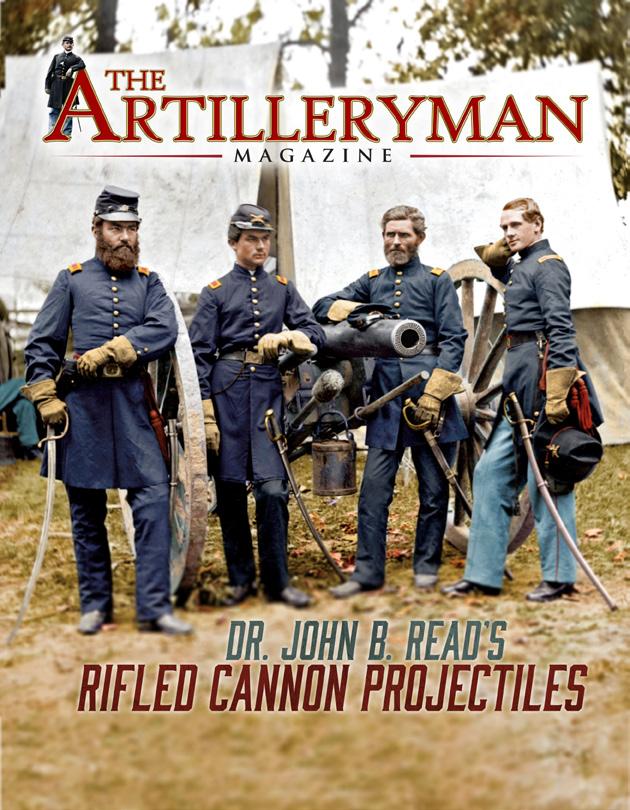

2 CWN September 2020
years, digital only $29.95, add digital to paper subscription for only $10/year more. Subscribe at www.CivilWarNews.com
Letters to the Editor: Please email: mail@civilwarnews.com Civil War News 520 Folly Road, Suite 25 PMB 379 Charleston, SC 29412
Admission Coupon To Any MKShows Event $1 Off 770-630-7296
when many people’s knowledge of our history is so appallingly ignorant.
ol. 41, No 2 Spring 2020 $8.00 Battle of Chickasaw Bayou • Gatling Gun Shoot at Fort Ross • Doctor Gatling’s Gun The Guns Custer Did Not Take to the Little Bighorn • CSS Pee Dee Cannon Conserved; Installed at Florence, S.C. Confederate Imported Enfield Artillery Carbines Subscribe online at CivilWarNews.com
Stuart McClung Hagerstown, Md.






Ulysses S. Grant: Migraine and Drunkenness – A Reconciliation
by M.G. Subhas
Introduction
Allegations of drunkenness followed Ulysses S. Grant from his 1854 posting at Fort Humboldt in the Pacific Northwest to this day. There is a dissonance when considering the allegations of drunkenness since Grant, who is acknowledged to have been honest, plain spoken, and with an indomitable will, had publicly pledged to be temperate (Chernow p. 69).

Was Ulysses Grant living a lie? Is there a perspective that can reconcile this dissonance?
This paper sets out to show that Ulysses Grant was not an alcoholic. Grant suffered from a ‘sick headache’ or what today is called a bilious migraine. Many, if not all, recorded observations of Grant being intoxicated were probably an instance of mistaking the symptoms of a bilious migraine.
Migraine – A Misunderstood Illness
Even today the physiology of migraines is not well understood.
Katherine Foxhall’s Migraine: A History, provides a chronology of the condition from the Middle Ages to the early 21st century. The description of migraines during the mid-nineteenth century helps us evaluate the social and physiological perspectives during Ulysses Grant’s lifetime. Given our current understanding of migraines, we can evaluate and reassess the historical record of Grant’s condition through
witness statements.
In the mid-nineteenth century, “sick headache” and “bilious headache” were terms commonly used to describe what later would be called a migraine, the French version of the more ancient hemicrania.
“Migraine is a spectrum disease,” Foxhall writes, “usually manifesting as an episodic or chronic primary headache disorder, characterized by attacks that can last from a few hours to up to three days….Before and during a migraine attack, many people encounter various symptoms, such as, tiredness, emotional disturbance, poor concentration, sensitivity to light or sound, blurred vision, nausea and yawning. On average, migraine sufferers experience one to two attacks a month…” (Foxhall, p. 5).
Sick headaches then, as with migraines today, were observed in many more women than men. This led to several diagnosticians positing causes of the condition being due to female issues, such as weak constitution, nerves, mental weakness and instability, hysteria, menstruation, etc.
Several pills and tonics were advertised and sold during the nineteenth century claiming to remedy a very wide variety of deficiencies including headaches. Many pills contained opium or cocaine along with an array of other herbs and chemicals. They were essentially household remedies targeting a condition that is still not understood and which does not have an effective cure. Symptoms can be lessened in intensity and duration after the advent of an attack,
but the attacks themselves cannot be prevented.
Johns Hopkins Medicine maintains a practice focused on migraine. Their description is along the lines of Foxhall’s cited earlier. These modern-day physicians conclude that: At their worst, they are typically associated with sensitivity to light, noise and/or smells. Nausea is one of the most common symptoms and it worsens with activity, which often results in patient disability. In many respects, migraines are much like alcohol-related hangovers.
Ulysses Grant – Living With The Burden Of Migraine
Ulysses Grant, from an early age, had a chronic condition. “[Grant] was growing up fat and strong, even though the fever and ‘ague’ [chills] that haunted the West struck him severely for long spells now and again” (Lewis, p. 31, citing Sanderson, Memoirs). Note the reference to ‘now and again’ frequency and the duration of ‘long spells.’
Jesse Root Grant was Ulysses’ father. “Two of Jesse Grant’s brothers had died of consumption and Jesse was worried over the severe spells of fever and ague that occasionally struck Ulysses. Ulysses’ life in the open air by day, would, it was hoped, counteract any weakness in the lungs” (Lewis, p. 35). Again, the reference to severe spells and occasional frequency suggests that Ulysses experienced these symptoms more often and differently than other children, including
e.g. Cousin Johnny or Grant’s other playmates. Since migraines were not really understood in the mid-nineteenth century, it is possible that what was prevalent, i.e. ague, was imputed to Ulysses’ condition.
Julia, Grant’s adoring wife, stated succinctly in her memoirs. “The General used to have dreadful headaches about once in three or four weeks and on those occasions would return from his office saying to me: ‘Oh! Do not ask me to speak. I have a dreadful headache.’ I would seat him in his armchair, darken the room, call for a hot foot-bath with mustard, and, after bathing his feet, I would persuade him to take one of my little pills, when he would lie down and sleep, and always in an hour or two he would awake well and ready” (Grant, p. 162).
Julia clearly remembered her husband’s periodic attacks of headaches and her brief but complete mention of Ulysses’ headaches is reflected in Katherine Foxhall’s description.
What is particularly interesting is Julia’s mention of “my little pills” indicating that she kept with her one type of such easily accessed and ready-to-consume ‘women’s’ pills. Whatever the intended effect of the pills, Ulysses Grant seems to have recovered from his attacks after Julia’s ministrations. Though, in her memoirs, she chides him for being “ungracious enough to laugh and say: ‘You did not cure me. Why, I got well myself, did I not?’”
Foxhall mentions Ulysses Grant and Sigmund Freud in a list of famous people with migraines. Citing an 1885 letter from Freud to his wife blaming an attack of migraine on the tartar sauce he had with lunch, he “took some cocaine, watched the migraine vanish at once,” and went on writing.
Dr. Jack D. Welsh, in his Medical Histories of Union Generals, mentions a much-recounted episode. “On April 7, 1865, he had a severe headache. He was told to bathe his feet in hot water and mustard and to
apply mustard plasters to his wrists and the back of his neck. However, the treatment produced little relief” (Welsh, p. 139).
In his memoirs Grant mentions the unexpected cure he experienced when he received notice that Robert E. Lee had accepted Grant’s suggestion of a meeting to discuss terms of surrender. Grant, acknowledging that he “was suffering very severely with a sick headache…spent the night in bathing my feet in hot water and mustard, and putting mustard plasters on my wrists and the back part of my neck, hoping to be cured by morning,” wrote “... but the instant I saw the contents of the note I was cured” (Grant, Personal Memoirs, p. 625-627).
The record seems clear that Ulysses Grant suffered from migraines, maybe even from an early age when they were potentially misdiagnosed as fever and ague. When the migraines came on, Ulysses suffered from headache, odd sensations, indigestion, and nausea, obvious intense personal suffering. His migraines, as Foxhall writes, suffered from a legitimacy deficit likely due to the gendered images, metaphors, and stereotypes, i.e. affecting people who are weak, feminized, oversensitive, and unable to cope ….Ulysses Grant carried this disease, trying his best to keep it private and seeking solitary confines whenever he could—while at the same time leading a very public war effort and later presidency.
Looking Through The Migraine Lens – Reinterpretation
Jesse Grant exempted his son Ulysses from working in the tannery. Yet, Johnny Grant, Ulysses’ cousin worked in the tannery when he was just nine years old. Jesse Grant’s fears of hereditary illnesses and the differentiated nature, i.e. frequency and severity, of the fever and ague likely were reasons Ulysses was released from tannery work. Smell and physical activity are cited as triggers for migraines, both were
4 CWN September 2020 Civil War Catalog
a large assortment of Civil War and Indian War autographs, accoutrements, memorabilia, medals, insignia, buttons, GAR, documents, photos, & books. Please visit our fully illustrated online catalog at www.mikebrackin.com Free copy mail catalog Mike Brackin PO Box 652, Winterville, NC 28590 • 252-565-8810
Featuring
Lieut. Gen’l Grant and Staff. Library of Congress.
present in abundance in a tannery. Luckily for Ulysses, “his father placed him in charge of the wagon and, therefore, working with horses and kindling a lifelong love of the noble animal” (Lewis, Captain Sam Grant, p. 35).






In 1849 Ulysses Grant was stationed in Detroit. Biographer William C. Church obtained the recollections of Colonel James E. Pitman, one of Grant’s close friends while in Detroit. Pitman said, “I used to go to the same Methodist church where Dr. George Taylor was the pastor. I think Dr. Taylor helped Grant a great deal. It was said that he had a long talk with Grant at that time and told him that he could not safely use liquor in any form and Grant acknowledged this and took the pledge and thereafter used no liquor at all in Detroit. I will say that I saw Grant drink, but never saw him intoxicated. He was a gentleman in his habits and instincts. He took his fun or dissipation, you might say, in racing horses. In those days Detroit was a frontier town and all used whiskey freely. Grant drank no more than the rest of the officers, he was not noticeable either way, either for leaving it alone or taking it.” (William Conant Church Papers, Library of Congress—archived at granthomepage.com/ intpitman.htm)
After reviewing Pitman’s Detroit recollections, could it be that Grant approached Pastor Taylor about, as Katherine Fox describes, the “nervous weakness” and “bad habits” to which his sick headaches were, at that time, most likely attributed. Was Grant seeking a moral remedy from a pastor for the much-ridiculed bilious migraine? The refocus on the episode, using the migraine lens, suggests that Grant was seeking help for a condition he had from an early age and about which he did not want to talk openly, i.e. his frequent debilitating headaches. Dr. Taylor’s prescription, more from a moral perspective than medical, is also then coherent with the then current understanding of it being a weakness, especially Taylor’s use of the word “safely.”
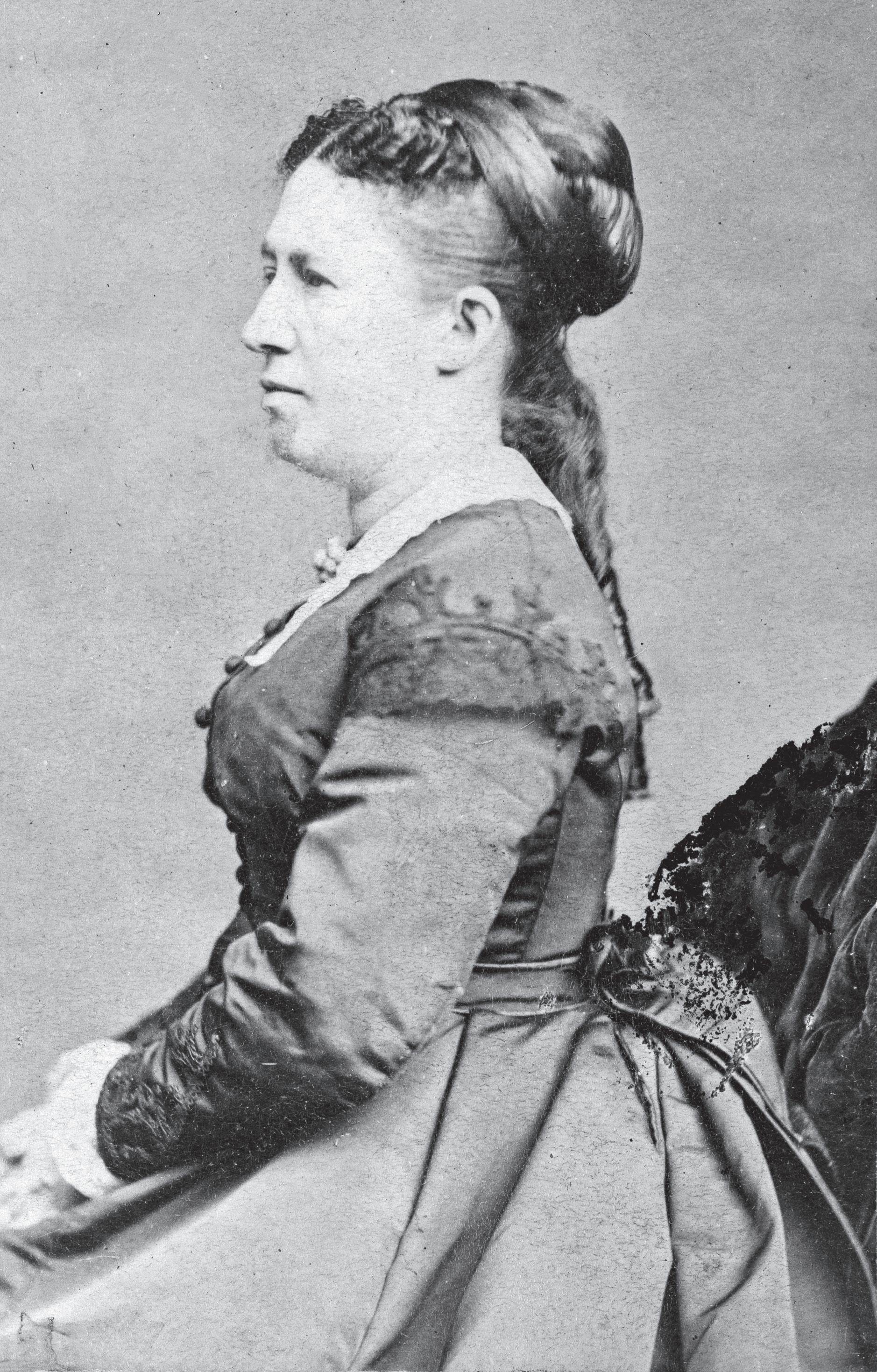


John Rawlins was Grant’s closest aide-de-camp. His statements on Grant that referred to drinking and temperance are much cited in the many Grant biographies. Rawlins had a father who was a hard-drinking man (Chernow p. 149). Observing his father, Rawlins developed a strong dislike of alcohol and, recoiling from his father’s alcoholism, is likely to have bought into the then-prevalent theory of weak constitution and bad behavior being the cause of migraine. His admonition of
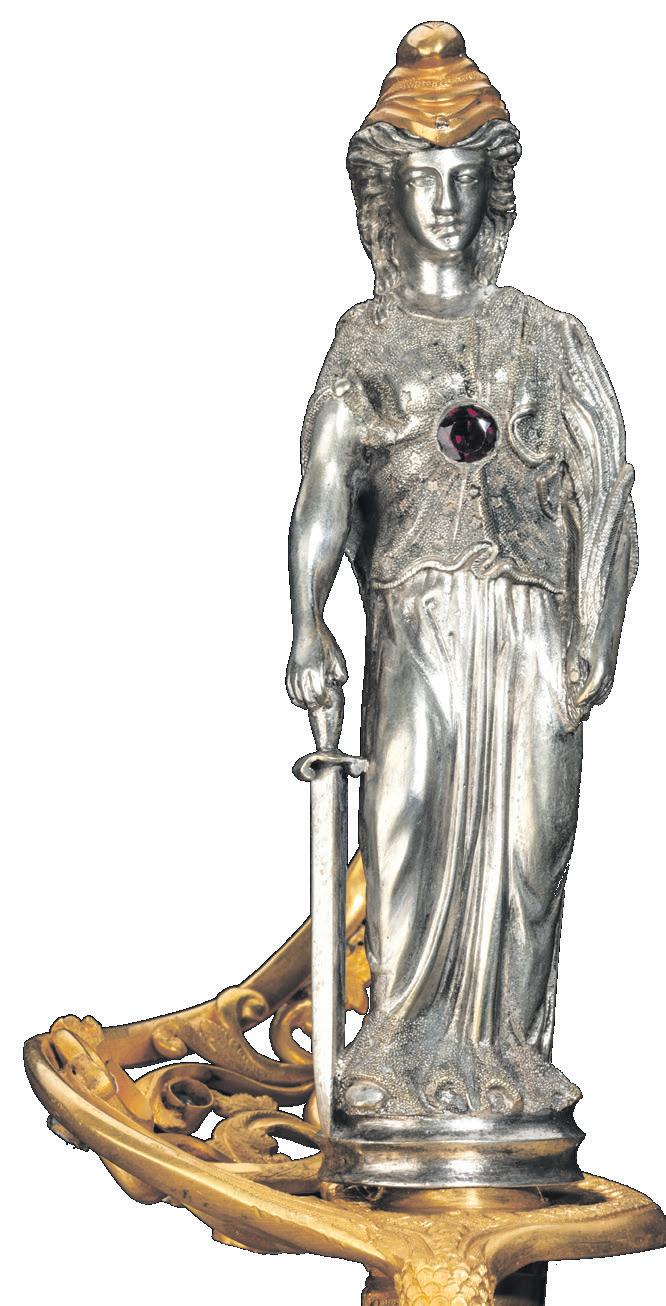
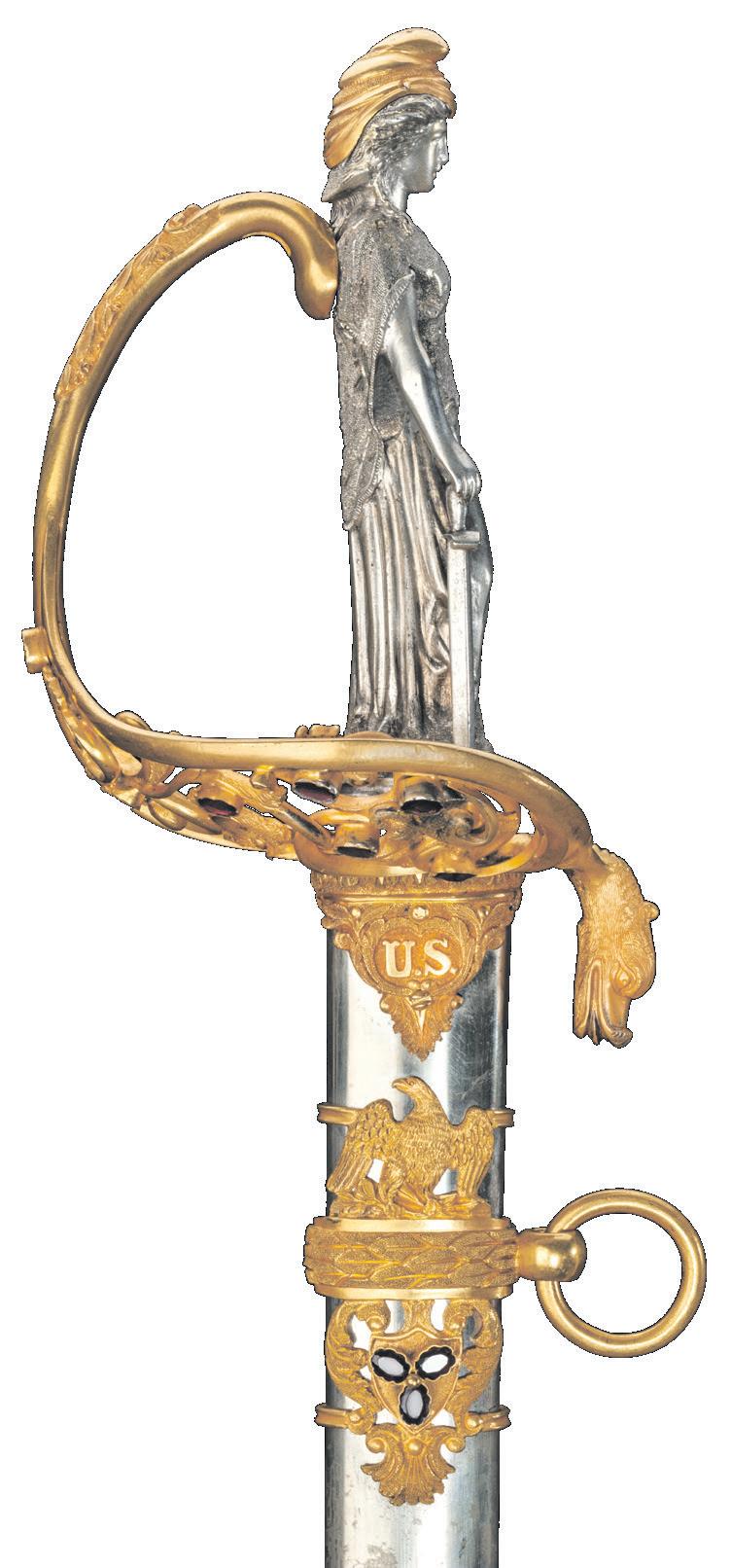
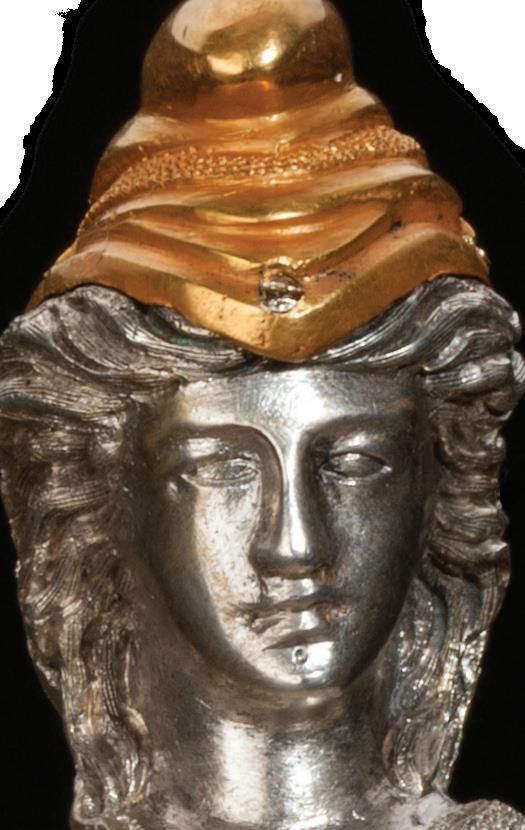
Grant to stay strong and not succumb to ‘bad habits” plaintively echoes the early nineteenth-century ‘nervous weakness/bad habits’ theory. This interpretation reconciles Rawlins’ note to Elihu Washburne on December 30, 1861, “I would say unequivocally and emphatically that the statement that General Grant is drinking very hard is utterly untrue and could have originated only in malice” (Chernow, p. 165).











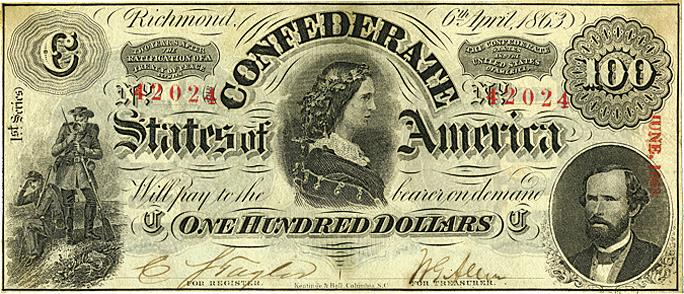
Grant’s resignation from the army while serving at Fort Humboldt was the seminal incident that brought the issue of drunkenness to a head, and drunkenness was said to be the motivation for Grant’s decision to resign. Grant’s friend and West Point roommate Rufus Ingalls said, “… without his family, and with little to occupy his attention, [Grant] fell into dissipated habits, and was found, one day, too much under the influence of liquor to properly perform his duties” (White, p. 120). Ingalls related that Buchanan demanded Grant either resign or stand trial. Note that Grant was ‘found’ inebriated, i.e. no one claims to have seen him drinking. This is not the statement of a witness to drinking but an observation of inebriation. Grant could not mount a defense other than ‘I did not drink’ because there was no legitimacy to sick headaches as a disease and


5 September 2020 CWN Subscribe online at CivilWarNews.com Greg Ton • P.O. Box 9 • Franklin, TN 37065 901-487-5944 • GTon1@aol.com Greg Ton Buying and Selling the Finest Confederate, Obsolete and Southern States Currency Since 1978 GregTonCurrency.com Buying and Selling The Finest in Americana 11311 S. Indian River Dr. • Fort Pierce, Florida 34982 770-329-4985 • gwjuno@aol.com George Weller Juno
Julia Dent Grant, Grant’s wife. Library of Congress.
they were considered a bad habit, a term Ingalls uses, and a female weakness.
Lewis Cass Hunt, Buchanan’s adjutant, observed that Grant “used to go on long sprees till his whole nature would rebel and then he would be sick” (Chernow, p. 84). General (William Farrar) Baldy Smith at Cold Harbor echoed Hunt when he said “General Grant has gone away drunk.” He rode off “in a most disgusting state after having vomited all over his horse’s neck and shoulders” (Chernow, p. 422). Again, this description, while presuming intoxication is also consistent with a sick headache/bilious migraine.
These descriptions by Ingalls, Hunt, and Smith, relying as they do on observed conditions (‘he was found/seen, sick, vomited’) suggest that migraine was the more likely affliction mischaracterized as intoxication. Combining this with the suggestion of “dissipation,” suggesting weak or ‘feminine’ nervous symptoms, it is no surprise that Grant did not want to face a trial where his ‘weakness’ and fitness to serve would be challenged while he had no authoritative support for his migrainous condition to draw on as a defense.
In another observed incident, Henry Hodges, speaking of an expedition being marshaled under the direction George McClellan out of Fort Vancouver says: “Grant got on one of his little sprees, which annoyed and offended McClellan exceedingly, and in my opinion he never quite forgave Grant for it” (Chernow, p. 81). Though suffering from a severe cold, Chernow concludes, Grant delivered two hundred
horses and other supplies on time, but he had made a powerful enemy who would associate him with an alcoholic binge.
Chernow’s little post-script of a ‘severe cold’ is again a symptom of a migraine. As Johns Hopkins Medicine says: Migraine pain can be felt in the face, where it may be mistaken for sinus headache—or in the neck, where it may be mistaken for arthritis or muscle spasm. Complicating the diagnosis of migraine is that the headaches may be accompanied by other “sinuslike” symptoms, including watering eyes, nasal congestion and a sense of facial pressure. (op. cit. hopkinsmedicine.org) Hodges’ reference to ‘one of his little sprees’ indicates periodic frequency and presumption of alcoholism while being consistent with Julia’s note on the frequency and manifestation of Grant’s sick headaches.
Grant, on the day of Lee’s surrender at Appomattox, described his headache as a nervous prostration, “On the night before Lee’s surrender,” said General Grant, “I had a wretched headache—headaches to which I have been subject—nervous prostration, intense personal suffering. But suffer or not, I had to keep moving” (Young, p. 455). An article in the Boston Medical and Surgical Journal from January 1884, defines a person with nervous prostration as “…suffers odd sensations in his head, his digestion is disordered; he is weak; wakefulness, mental depression and a thousand and one new sensations of strange character and fearful portent are superadded’
(Vol. CX, No. 3, January 17, 1884, p. 53).
Grant – A Man Of Honesty, Integrity And Temperance
Character witnesses abound for Grant’s honesty, integrity, and temperance, which render the rumors of drunkenness to be more fable than fact. Chernow, while labeling Ulysses Grant as ‘utterly incapable of guile,’ cites a classmate during Grant’s early adolescence: “He was an exception as a boy for truth, honesty, and fairness” (Chernow, p. 16).
Dabney Maury, a United States Military Academy graduate who Grant took under his wing during the Mexican War, says, “Grant was a thoroughly kind and manly young fellow, with no bad habits …” (Lewis, p. 183). This statement is from a time when, according to Lewis, “drinking was very much in evidence among the army in Mexico.”
General Henry Halleck, Grant’s superior headquartered in St. Louis, assigned Lieutenant James Birdseye McPherson, who finished first in his class at West Point, to Grant’s staff along with orders to Grant to ‘take & hold Fort Henry.’ McPherson confided to Dr. John Brinton, staff physician, that Halleck asked McPherson to obtain ‘special information’ on reports that “he [Grant] is drinking terribly, and in every way is inefficient” (White p. 185-186). Brinton told McPherson that “the reports were unfounded, that I knew were false,” but encouraged him to see for himself. McPherson did see with his own eyes and saw in Grant a “disciplined, respected commander” (White, p. 186). The use of ‘disciplined’ by a military man is noteworthy and is
defined in the Merriam Webster dictionary as ‘orderly or prescribed conduct or pattern of behavior.’ James McPherson went on to serve under Grant from the early victory at Fort Henry until his death outside Atlanta during July 1864.
Adjutant General Lorenzo Thomas, who was given the responsibility of recruiting former slaves into the army, implicitly exonerates Grant of charges of being a drunkard. “It is currently stated that when Adjutant General Thomas visited the Department of the Tennessee, early in April 1863, he carried…an order from the President to displace and remove General Grant from his command if the facts [drinking] proved to be as they were reported at the national capital …. General Thomas, on his arrival at Milliken’s Bend, found matters far different than were represented at Washington …. He therefore elected not to remove the note from his pocket” (Larke, 1864, p. 312).
Mrs. Mary Livermore, the woman’s suffragist, and temperance activist, was working with the Sanitary Commission, and visited Grant at Young’s Point, La., while vicious reports of Grant’s negligence and imbecility (hints of drunkenness) were bandied about in the press. Mrs. Livermore “gave the lie to the universal calumnies then current.” Mrs. Livermore insisted that the General “was not a drunkard” and possessed a “clear eye, clean chin, firm flesh and steady nerves” (Miers, p. 97), each a negation of the caricature of a drunk.
Charles Anderson Dana, a journalist, accepted Secretary of War Edwin Stanton’s offer of being an Assistant Secretary. An early assignment from Stanton was for Dana “to give such information as would enable Mr. Lincoln and [himself] to settle their minds as to Grant ….” while ostensibly auditing paymasters. Dana, whose role as a spy was an open secret, describes “Grant was an uncommon fellow—the most modest, the most disinterested, and the most honest man I ever knew, with a temper that nothing could disturb, and a judgment that was judicial in its comprehensiveness and wisdom” (Brands, p. 229). Dana’s report to Stanton ended with, “I have to report that the paymasters have finished their work and gone, and henceforth any shrewd person can see I am not attending to their transactions” (Miers, p. 153). A winkwink, nod-nod exoneration of Grant from the charge of drunkenness was stated within the official scope of Dana’s mission.

Elihu Washburne, congressman and strong advocate of Ulysses Grant, spoke in Congress after vicious news reports of Grant’s drunkenness following the bloody battle at Shiloh, saying of Grant, “He is an example of courage, honor, fortitude, activity, temperance and modesty” (Chernow, p. 210).
Also, at the same time, Benjamin Johnson called on Grant in his tent and Grant asked him what people said about the battle. “I told him they said he was drunk. He fired up a little and asked me if I thought he was drunk now. I said I knew he was not. He replied, ‘Well, I was just as drunk then as I am now, no more nor less.’” This is a statement from a ‘most honest’ man who is ‘utterly incapable of guile.’
Hamilton Fish served as Secretary of State during both terms of Grant’s presidency. During the 1872 presidential campaign Grant’s opponents used accusations and innuendo to diminish Grant’s candidacy. Responding to an inquirer about Grant’s drunkenness, Hamilton Fish says, “The very close personal association which I have had with him for many years justifies me in saying that the imputation of drunkenness is utterly and wantonly false” (White, p. 534).
These attestations from Grant’s early life through his military and political careers speak of a simple, guileless man of honesty, integrity, and courage. This is the father who admonished his children that, ‘Lying is the foundation of all crimes and follies’ (Chernow, p. 97). This honest and iron-willed man also took a pledge of temperance.
Conclusion – Grant’s Migraine Illness Was Misdiagnosed
Ron Chernow, calling it a chronic disease, comes tantalizingly close to the right diagnosis of a migraine but veers sharply to alcoholism. His contention that “Grant was an alcoholic with an astonishingly consistent pattern of drinking, recognized by friend and foe alike; a solitary binge drinker who would not touch a drop of alcohol, then succumb at three- or four-month intervals usually on the road. As a rule, he underwent a radical personality change and could not stop himself once he started to imbibe” (Chernow, xxiii) (italics added for emphasis).
Chernow’s list of symptoms is consistent with those of a migraine sufferer. The regular periodic attacks are attested to by
6 CWN September 2020
Bird’s-eye view of Grant’s Tomb, New York. Circa 1915. Library of Congress.
Julia Grant. That these were usually on the road and not while Julia was present speaks more to the care that Julia gave Grant including her “little pills.” The sensitivity to light that Grant felt is mentioned by Julia and this is likely why Grant took himself off to solitary confines where he could be inactive while in the throes of a sick headache. No one likes to be a spectacle of sickness and vomit. Grant’s mention of mental prostration and Foxhall’s description of intense personality changes are reflected in Chernow’s list of symptoms.
So, yes Grant had a life-long migraine disease. Many who knew him personally, some intimately, attest to his honesty. That is good enough to look for an alternative explanation. The migraine lens, with more recently clarified history, clearly establishes that the resemblance to a hang-over can lead to a mistaken diagnosis. Many observed incidents of drunkenness, when reinterpreted through the lens of a migraine, are likely a mistaken case of migraine. Ultimately, acknowledged as a guileless man, Grant’s own admission is that he was temperate.
The author accepts the testimony of General Lorenzo Thomas, General James McPherson, Doctor John Brinton, Charles Anderson Dana, Mrs. Mary Livermore, and Dr. Jack Welsh that Ulysses S. Grant was honest, suffered from migraines and was not an alcoholic.

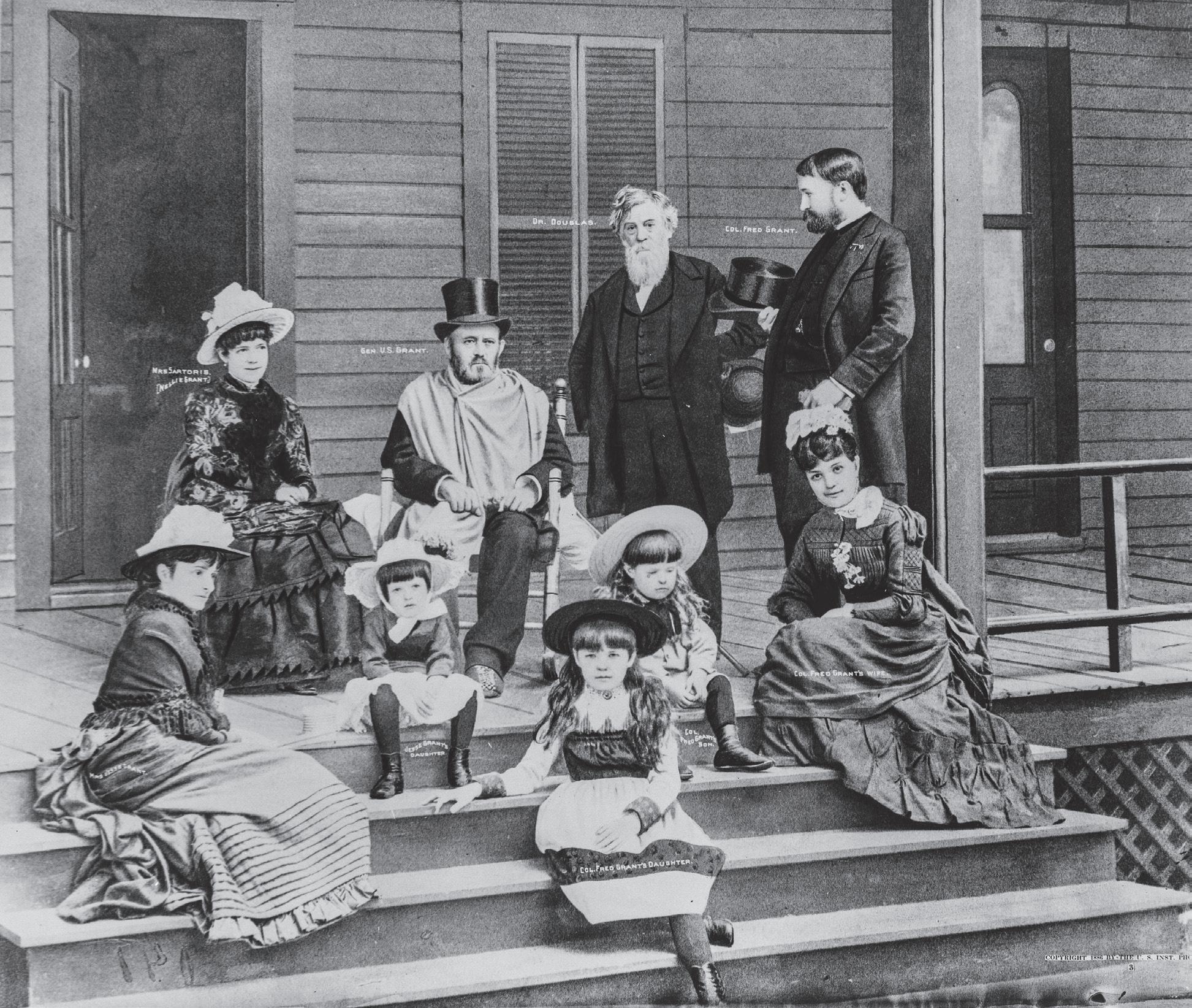

Bibliography:

• Brands, H. W., The Man Who Saved the Union: Ulysses Grant in War and Peace. United States: Anchor Books, 2013.
• Chernow, Ron, Grant. New York, Penguin Press, 2017.
• Foxhall, Katherine, Migraine: A History. Baltimore, Johns Hopkins University Press. 2019.
• Grant, Julia, The Personal Memoirs of Julia Dent Grant (Mrs. Ulysses S. Grant), New York, Putnam, 1975.
• Grant, Ulysses S. (Ulysses Simpson), Personal Memoirs of U.S. Grant, Selected Letters 1839–1865. New York, N.Y.: Library of America, 1990.
• Larke, Julian K., General Grant and his Campaign., New York, J.C. Derby & N.C. Miller, 1864.
• Lewis, Lloyd, Captain Sam Grant, Little, Brown, 1950.
• Miers, Earl Schenck, The Web of Victory: Grant at Vicksburg. New York, Alfred A. Knopf, 1955.
• White, Ronald C., American Ulysses: A Life of Ulysses S. Gran., New York, Random House, 2017.
• Welsh, Jack D.M.D., Medical Histories of Union Generals. Kent, Ohio, The Kent State University Press. 2005.

• Young, John Russell, Around the World with General Grant. Baltimore, Johns Hopkins University Press, 2002.
M.G. Subhas, after retiring from a career in finance, has volunteered at the General Grant National Monument in New York City logging more than 500 hours over the course of two-plus years. Subhas is featured on the Facebook page of the site under the ‘Volunteer Voices’ segment in a video discussing some of the symbols used to adorn the monument. During the course of his activity at Grant’s Tomb, Subhas has had the opportunity to hear Mr. Ron Chernow, Mr. Ron White, Mr. Frank Scaturo—all biographers of Ulysses Grant. Subhas resides in New York City with his wife.
7 September 2020 CWN Subscribe online at CivilWarNews.com – MAKER –LEATHER WORKS (845) 339-4916 or email sales@dellsleatherworks.com WWW. DELLSLEATHERWORKS.COM The 2020 Civil War Dealers Directory is out. To view or download a free copy: www.civilwardealers.com/dealers.htm
Ulysses S. Grant, members of his family, and Dr. Douglas on porch. Circa 1886. Library of Congress.
anything. General McClernand had his own agenda for fame and fortune, and simply regarded Grant as an obstacle in his path. As a result, Grant removed McClernand from command during the Vicksburg campaign.
Although Grant did not ask for it, he also did not refuse his appointment as General-in-Chief. The promotion established him as the master military and political strategist of the war, while moving Halleck to a position better suited to his talents as the master political administrator of the war. These three examples show Grant’s ability to politically maneuver and bargain as needed. In 1868, the Civil War hero and novice politician became the “inevitable nominee of the Republican Party.”3
Grant’s military career that helped him develop many attributes made him an effective President. He developed strong communication skills. He knew how to delegate effectively, making subordinate commanders responsible for executing orders, while he held himself accountable for the overall operation. Grant had a strong focus and was not easily swayed. His tenacity despite several failures at Vicksburg was one major reason he was regarded as a military prophet. He also knew how to work with a variety of people to get a job done. However, Grant also had three significant flaws:
1. he was known to have a temper
2. he drank too heavily at
times [editor’s note: for a different interpretation of “drunkenness,” see the M.G. Subhas article on page 4]

3. he was also too trusting.
Grant won the elections of 1868 and 1872, making him the eighteenth President. Ironically, the same skills that served him so well in the military caused some of his problems in the White House. Historians agree Grant’s trust and loyalty to his friends blinded him from seeing their true colors. Although several cabinet appointments went to individuals he knew through his military service, there were also some that went to men he hardly knew.4 Some individuals in this latter group were involved in unscrupulous business practices and fraud as they took advantage of the unsettled, often desperate times following the Civil War.
One example was Grant’s association with insider dealing in the Credit Mobilier Corporation financing of the Union Pacific railroad by his first Vice President, Schuyler Colfax.5 Bruce Catton summed it up best in U.S. Grant and the American Military Tradition, when he stated, “Grant made an irretrievable mistake by not consulting Republican leaders or even the men he appointed.” Catton also asserted that Grant was a political innocent catapulted into the presidency as a reward for a brilliant military career. Grant could literally do no wrong. If he asked for something, it was usually accomplished without question or reservation. Unfortunately, this situation almost guaranteed disastrous
results.
Grant’s two terms as president came during one of the more pivotal times of American history. During his eight years as president, Grant faced numerous problems including:
• a prior president who faced impeachment proceedings
• an uncooperative Congress
• reconstructing and reintegrating the Southern states into the Union
• dealing with the economic depression of 1873.
When Grant first entered office, he did not state any goals regarding Radical Reconstruction, possibly because he did not have any strong opinions. However, it is more likely he wanted to act carefully. His impeached predecessor, Andrew Johnson, was ineffective, because he opposed the Republican controlled Congress on how to administer Reconstruction programs and policies. His biggest problem was that the United States Constitution provided no guidance on secession or how to reinstate seceded states. This left Grant with four major issues open to interpretation:

1. readmission of Southern states
2. treatment of ex-Confederates
3. the civil rights of free Blacks
4. the make-up of new state governments in the South. Each issue was significant in its own right.
In many cases, Congress, the president, and general public could not agree on any uniform or consistent terms allowing the southern states to reenter the
union. Some people were conciliatory like President Lincoln; others at the opposite end of the spectrum wanted each and every Southerner to “pay” for what they did to this country.
These same groups also disagreed on how to handle the former Confederates who had borne arms against the Union government they were now trying to re-enter. Many Northerners felt these soldiers could not be trusted. The Confederates still had weapons and might have a willingness to continue waging war in their hometown areas.

The biggest problem was handling more than four million former slaves who were now free, but incapable of taking care of themselves.6 It is interesting to note that President Lyndon B. Johnson, serving his term almost one hundred years after Grant, is well known for his record on race relations, a problem that never was completely addressed during Reconstruction. The racial issues Grant faced were met with greater resistance, yet he is not remembered for that.7 The complex problems dealing with emancipated blacks were difficult, if not impossible, for anyone to overcome. Reconstruction supposedly brought universal freedom for all men, filling in gaps where the Emancipation Proclamation fell short.8 Equal voting rights and protection under the law only lasted as long as the United States Army enforced it.
“Freedom” is a confusing word. Many freed blacks had no real freedom. They owned no land, had little or no education, and had little hope of achieving true freedom, because they had no
concept of what freedom meant. The paradox of Reconstruction lay in trying to help people who either wanted no help or did not know what kind of help they wanted. To some Freedom meant:
• reuniting separated families
• ending physical punishment and abuse
• beginning an education process
• establishing churches to freely practice their own religious beliefs
• owning and working land

• forming social clubs and/ or entering the political arena.9
Owning land was one of the most important measures of freedom, because it demonstrated economic independence and a potential livelihood for the family.10
The most interesting issue associated with the U.S. Constitution and secession was establishing new state governments in the Southern states. Both the legislative and executive branches claimed reintegrating the state governments as their role and responsibility, but neither could agree on how to implement it. The general public was also deadlocked.
As a result, four separate Reconstruction programs emerged:
1. Presidential Reconstruction
2. the Fifty Percent Plan
3. the Johnson Initiative
4. Radical Reconstruction.11 Each emphasized different plans and policies.
Presidential reconstruction is what President Lincoln desired. Lincoln’s view was that since a state had no right to leave the Union, they never really left and

8 CWN September 2020
. . . . . . . . . . . from page 1
H Reconstruction
President Grant enjoying a cigar. “All Smoke” Harper’s Weekly, May 11, 1872.
he could control their reinstatement. Lincoln’s plan, created in 1863, required ten percent of each state’s voters to pledge their allegiance to the Union for that state to be readmitted. This plan was really aimed at subverting the southern war effort, and was only implemented in those states then (1863) under military occupation: Louisiana, Arkansas, and Tennessee.12 Since Lincoln discussed this plan with both Grant and Sherman and they concurred, it is likely Grant would have implemented a program similar to this.
The second program, the Fifty Percent plan, was a congressional response to Lincoln’s plan, and was authored by Senator Benjamin Wade and Representative Henry Davis. This was a harsher program passed by Congress July 2, 1864.
It required:
1. an oath of allegiance by a majority of each state’s adult white men
2. new state governments formed and operated only by those who had never carried arms against the Union
3. a permanent loss of voting rights by Confederate civil and military leaders.13
The Wade-Davis Bill clearly sent a message that Congress was not about to hand over Reconstruction policy to the President. Rather than challenging it, Lincoln executed a “pocket-veto” by failing to sign it into
• repudiated Confederate debts


• ratified the Thirteenth Amendment, abolishing slavery.
This option was not available to high-ranking Confederate officials or wealthy planters.15 Only by presidential order could members of these two classes be pardoned. Johnson was a selfmade man who hated the wealthy southern planters and what he saw as the corrupt northeastern aristocracy. His animosity was strong enough that he wanted to see the planters and aristocrats brought down to earth, but he did not care to see colored men elevated in their place.16 Johnson, a slave-owner, was a champion of the poor whites and very likely a racist, since it is documented that he held little if any regard for the rights of freed blacks.17
assassinated, the political, economic, and social situation Grant inherited began to unfold. This is the third evaluation criterion used in determining how effective Grant’s reconstruction policies were.
There were mixed reactions among the general public as to how to implement reconstruction policies and how far it should go. The biggest political situation Grant faced was his own political party. The Republican Party represented a variety of several different things at the same time. It was the party that:
• won the war
• saved the Union
• freed the Negro
• stood for high tariffs
• provided protection for expanding industry
• gave “big business” what it wanted.
Republican majority of both houses saw Johnson as a major impediment to the Reconstruction process. Misunderstandings, miscommunications, and conflicting personal agendas lasted until President Johnson’s impeachment proceedings led to Grant’s election. These divisions caused a split in the party, that included a new group called Radical Republicans, which Grant affiliated himself with. The Radicals espoused the abolitionist ideals within the Republican Party.21 This group came to power in March 1867, and imposed a military based reconstruction dividing the South into five districts, each commanded by a general.
law before the Congressional session adjourned.14
The third program came as a result of Lincoln’s assassination. The Johnson initiative, also known as the “Restoration” plan, began in May 1865 and offered amnesty to all Southerners: • revoked their Ordinances of Secession
Congress responded to the Johnson initiative by stating that Reconstruction was a legislative prerogative and not an executive branch mandate. Congress proposed, in turn, “Radical Reconstruction,” based on the premise that “when the southern states seceded, they did it so well, they committed suicide.”18 They no longer existed as states and would not unless and until the Federal government made them anew.
Of these four programs, Lincoln’s was the most conciliatory and probably would have reconstructed the South the quickest. However, when Lincoln was
This situation was important for two reasons. First, Grant was such a popular hero that he was the center of attention regardless of what was going on. Also, his own political beliefs were caught in the middle of the argument about which branch would administer the reconstruction program.19
During Andrew Johnson’s administration, several events caused a fraying of relations between Johnson and Congress. Johnson was a Democrat prior to joining Lincoln’s Republican Party ticket.20 The friction between the president and Congress escalated to such a degree, the
Economically, the North and the South were ruined by the ravages of the Civil War. Many Southern farmlands lay in ruins unfit for most crops. Although the North still had various forms of commerce, it was saddled with the burden of trying to unify the whole nation economically.
America was just entering a period known as the “Gilded Age.” This period lasted thirty-five years following the war. During that time, America experienced:
• a massive urbanization movement
• significant technological improvements
• the growth of big business
• “get rich quick” schemes. The economic shift created the potential for fraud, waste, and corruption.
Social and cultural issues
9 September 2020 CWN
General Grant during the war. Brady-Handy photograph collection, Library of Congress.
frequently flowed from political and economic issues. Such was the case in the late 1860s. Many freed blacks felt displaced, unwanted, and treated as second-class citizens. The birth of the “Lost Cause” movement emerged in part as a strong rallying cry for the South. Many Southerners were more focused on re-writing history rather than reconstructing their broken region. William C. Davis explored this phenomenon in his book The Cause Lost: Myths and Realities of the Confederacy. Many Southerners felt God was still punishing them for sins they had committed relative to the slavery issue.
The fourth evaluation criteria, the actions Grant took to promote Reconstruction and his justification for these actions is the next focus. When Grant began his initial term, he believed the most important issue was Reconstruction. He internalized this belief stating “that the sacred heart of the program lay in the effort to protect the Negro in his new freedom.”22 According to Bruce Catton in U.S. Grant and the American Military Tradition, Grant believed “that the Negro would infallibly be trodden back down into second-class citizenship or worse unless the strong
arm of the Federal government intervened to protect them.” In his first inaugural address on March 4, 1869, Grant indicated he had no professional political experience, but his initial Southern policy would be one of conciliation.23
When Grant became president, Congress had no need to fear a presidential impediment to Reconstruction, but the Southern white counterrevolution remained very strong. In response, Grant sought a spirit of magnanimity similar to that exhibited in his Appomattox surrender terms. However, he was not willing to lose any gains made as a result of the end of the Civil War, especially at the expense of suppressing black citizen’s rights.24
In his first year as president, Grant made one of the most profound statements of any president up through his time, and far beyond. He is credited as the first president to “acknowledge the existence of racism as a fundamental problem facing the nation.”25 Frank Scaturro asserted in President Grant Reconsidered, that Grant made the following quote: “The present difficulty, in bringing all parts of the United States to a happy unity and love of country grows out of the prejudice to color. The prejudice is
a senseless one, but it exists.” Scaturro goes on to say Grant’s primary aim was for equal rights and not segregation.
In 1871, near the midpoint of Grant’s first term, all the seceded states met the required Congressional stipulations and had rejoined the Union. As a result of military and political activities, state Republican organizations won control of several of these newly established reconstruction governments.26 Blacks figured prominently in leadership positions of these newly formed state governments.27 This increased black participation frightened many Southern whites who did everything they could to intimidate the blacks. The intimidation and repeated attempts by the Southern whites to undermine the Fourteenth and Fifteenth Amendments helped Grant see that the central problem with any reconstruction policy was enforcement.28 The Fourteenth Amendment, passed in June 1866, established national citizenship for persons born or naturalized in the United States; prohibited states from depriving citizens of their civil rights or equal protection under the law; and reduced state representation in the House of Representatives by the percentage of adult male citizens
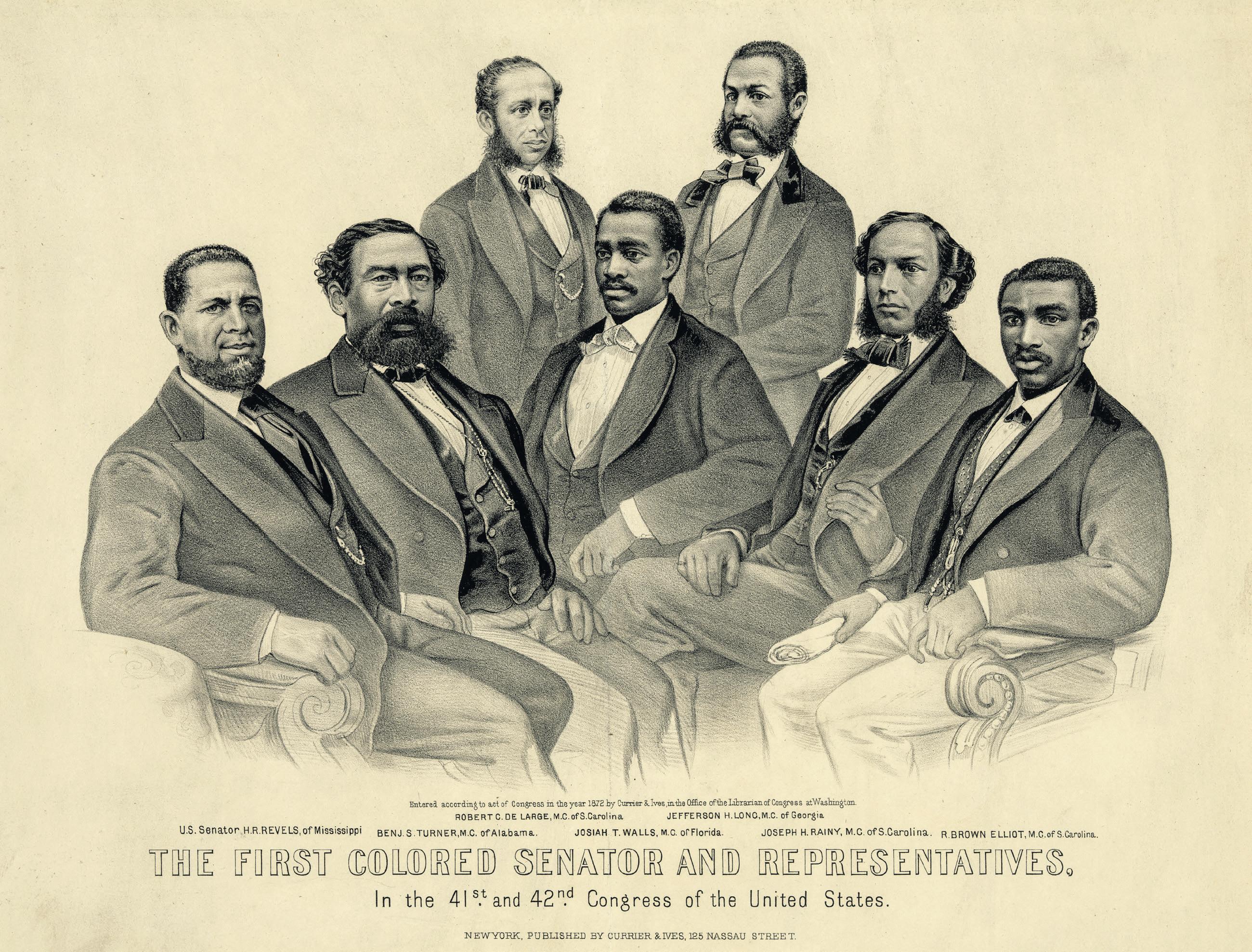
denied the right to vote.29 The Fifteenth Amendment, passed in February 1869, forbade denying citizens the right to vote on the grounds of race, color, or “previous conditions of servitude.”30
The Ku Klux Klan, an organization based in Tennessee, became a paramilitary force under the guidance of Confederate General Nathan Bedford Forrest.31 From 1865 to 1871, this organization operated in support of the aims and beliefs of the Democratic Party, by burning churches and schools; and murdering and whipping Republican politicians.32 We can look to Stetson Kennedy’s After Appomattox: How the South Won the War which presents a good picture of why Grant had difficulties enforcing his policies. Kennedy graphically related the stories of some 5,000 lynching and flogging incidents against blacks as the justification Grant used to convince Congress of the need to enlarge his enforcement powers.
In response to the intimidation tactics, President Grant passed the Ku Klux Klan Act in April 1871. This act authorized the use of federal prosecutions and military force to suppress conspiracies that deprived citizens the right to vote and enjoy the equal protection of the law.33
Specifically, it empowered the president to try cases of conspiracy, fraud, bribery, and intimidation against state voting officials to Federal courts.34 Even today, these statutes remain as some of the most far-reaching and widely litigated provisions upon which a person can realize or vindicate their constitutional rights.35
The Ku Klux Klan Act was one of five Enforcement Acts Congress passed between 1870 and 1872 to quell the increasingly dangerous intimidation practices used. In effect the Ku Klux Klan Act gave Grant two tools related to managing state related disorders:
1. the use of military force
2. the writ of habeas corpus, a requirement to appear before a judge or court as a result of alleged violations of someone’s personal liberties.
The act succeeded at curbing some intimidation. However, it also reminded Southern Republicans, how dependent they were on Federal Troops enforcing the laws. As a result, various government agents gathered and presented evidence that led to arrests, Federal Grand Jury indictment, and convictions of more than 3,000 Klansmen.36
Not all of Grant’s first term was dedicated to helping freed blacks. Frank Scaturro summarized Grant’s involvement with other activities from 1869–1873 in President Grant Reconsidered. In his first inaugural address, Grant advocated freedom from sectional prejudice; the resumption of specie or coin-based payments; restoration of national credit; healthy national commerce; reforms to the nation’s policy toward American Indians; and ratification of the Fifteenth Amendment.
Inaugural Promises Fulfilled
The following activities of Grant’s first term provide a benchmark for evaluating how close Grant came to fulfilling the promises of his first inaugural address:
• Public Credit Act (March 18, 1869) – payment of government obligations in gold.
• “Black Friday” (Sept. 24, 1869) – a financial panic erupted when Jay Gould and Jim Fisk tried to corner the gold market, but ended when Grant ordered the sale of government gold to stabilize the market.
• Celebration Proclamation (March 30, 1870) – issued to celebrate the ratification of the Fifteenth Amendment.
10 CWN September 2020
“The First Colored Senator and Representatives. In the 41st and 42nd Congress of the United States” by Currier and Ives, 1872. Library of Congress.
• First Enforcement Act (May 31, 1870) – first of several acts through 1872, protecting the voting rights of blacks.
• Neutrality Declaration (June 13, 1870) – Grant made a declaration of neutrality despite strong pressure for U.S. military involvement in the Cuban rebellion.
• Department of Justice (June 22, 1870) – newly created department under the Attorney General, marking a major consolidation of the federal government’s power to enforce civil rights.
• Civil Service Commission (March 3, 1871) – created the first Civil Service Commission in U.S. history.
• Indian Appropriation Act (March 3, 1871) – nullified Indian treaties and required government to recognize Indian welfare as individuals instead of tribal entities.
• Prosecution of the Ku Klux Klan (1871–1872) Nine South Carolina counties suspended the writ of habeas corpus on Oct. 17, 1871, in one of the boldest displays of peacetime presidential power. After troops were sent in, the Ku Klux Klan was effectively destroyed by the end of
1872.
• Nation’s First National Park (March 1, 1872) –Established Yellowstone as the nation’s first national park. This was the genesis of the National Park Service.
• Amnesty Act (May 22, 1872) – restored civil rights to all Southerners except certain named former Confederate leaders.
• Coinage Act (Feb. 12, 1873)
– made gold the only monetary standard.
As the list above shows, Grant did not do too badly for a novice politician in an extremely difficult period of American history.
Unfortunately, Grant’s second term did not start off as well. During the election season, the Credit Mobilier scandal occurred. Unbeknownst to Grant, several congressmen took bribes during construction of the Union Pacific Railroad in exchange for their votes in getting certain pieces of legislation passed. This scandal and the rise of the Democratic Party made it tough for Grant to focus on what he promised in his second inaugural address on March 4, 1873. In this address he continued advocating civil rights legislation for former slaves; the gold standard; domestic and international commerce; industrial
development, and continued reforms in Indian policies.
Scaturro also described activities outlined in Grant’s second inaugural address. Although his second term was marked with political and economic turbulence, Grant stood firm in his conviction to help Black Americans. Grant made the following remark during his address showing how deeply he felt about this issue.
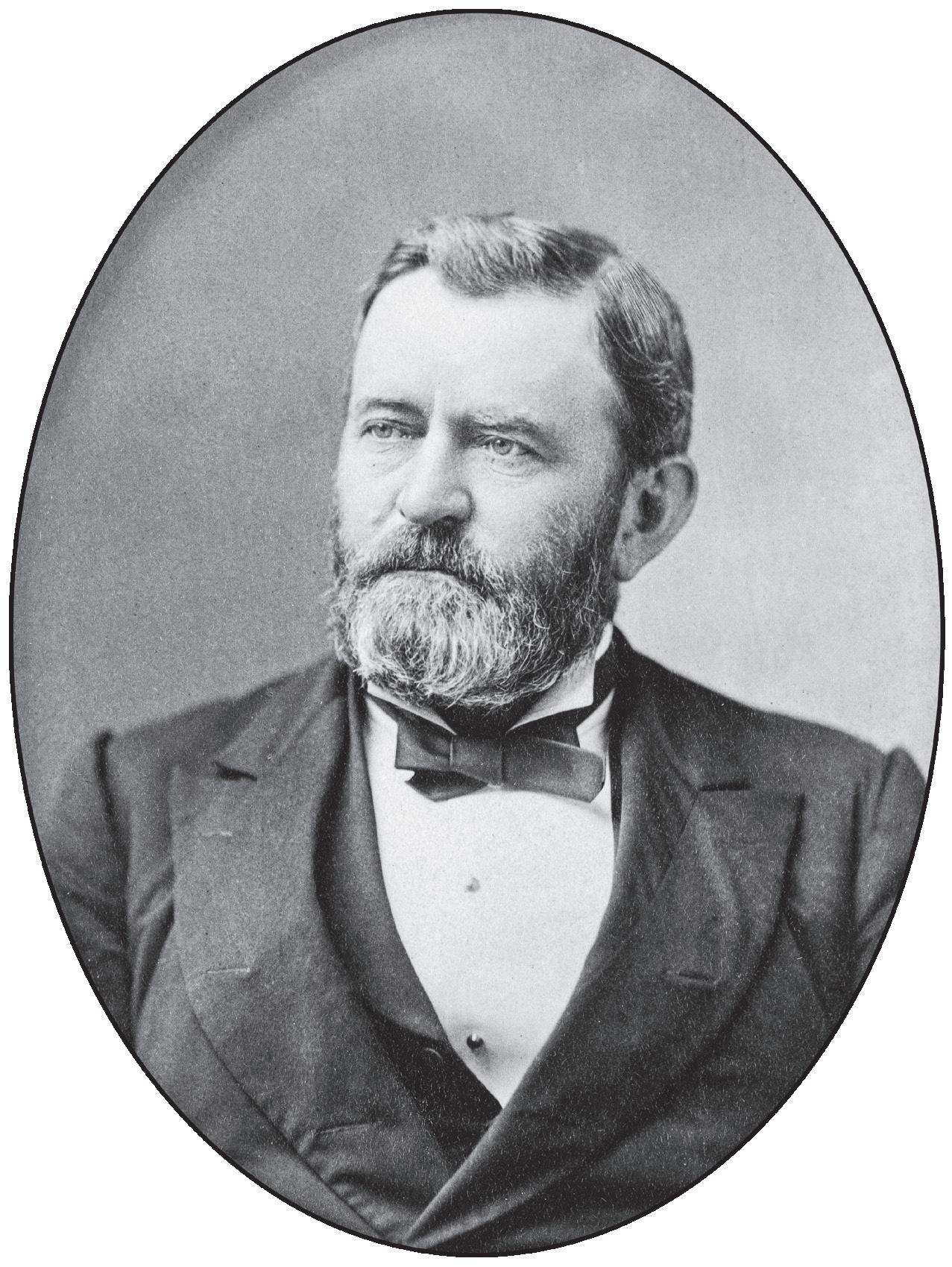
“Social equality is not a subject to be legislated upon, nor shall I ask that anything be done to advance the social status of the colored man, except to give him a fair chance to develop what there is good in him; give him access to schools; and when he travels let him feel assured that his conduct will regulate the treatment and fare he receives.”37 A brief list of Grant’s second term activities sheds light on some obstacles he dealt with:
• Dispersion of Disorderly Bands – (May 22, 1873)
Louisiana’s small Black Majority required Grant’s military support for the fragile Republican government to continue. By this time, Grant’s popularity was plummeting, because the race issue was so intense.
• Panic of 1873 (September 18, 1873) – Jay Cooke and
Company Banking House closed its doors. Many other banks/businesses followed suit, causing a depression that lasted four years and created
increased pressure for currency inflation. However, since Grant stood firmly for sound money, he vetoed an inflation of currency bill.
11
2020 CWN
September
Ulysses S. Grant, circa 1880. Library of Congress.
• Virginius Dispute (November 28, 1873) A Spanish gunboat captured a merchant ship, flying the American flag and was commanded by U.S. citizen, Captain John Fry. Spain was convinced the vessel and crew were aiding Cuban rebels. Fry, sixteen passengers, and thirty-six crew members were executed. Despite intense pressure to declare war on Spain, Grant successfully arbitrated the issue and received an indemnity and apology from the Spanish government.
• Inflation Currency Bill
Veto (April 22, 1874) – One of Grant’s 94 vetoes, more than the total number of vetoes by all his predecessors combined. It paved the way to continue specie payments, despite being very unpopular.
• Dispersal of disorderly gatherings in Mississippi
(Dec. 21, 1874) – Federal troops restored order and removed a fraudulently installed Democratic sheriff following the mass murder of blacks in Vicksburg.
• Specie Resumption Act (January 14, 1875) –Stabilized the currency by reducing the number of paper greenbacks in circulation and resumed gold coinage payments starting Jan. 1, 1879.
• Civil Rights Act (March 1, 1875) – prohibited racial segregation in public accommodations, transportation systems, and jury selection. Although ruled unconstitutional in 1883, it was the most sweeping civil rights legislation written until 1964. It was very unpopular with various groups and was lamented by many as a move that hurt the Republican Party.
• “Whiskey Ring” (May 1,
1875) – 350 indictments were secured against whiskey distillers who defrauded the Federal government for years.
• Dispersion of South Carolina “Rifle Clubs” (Oct. 17, 1876) – On this date, Grant ordered these rifle clubs to disperse.
• Election of 1876 (Nov. 1876) – Louisiana, South Carolina, Florida, and Oregon all submitted two sets of election results, one by Democrats and one by Republicans, bringing the election into dispute. During this time South Carolina and Louisiana, both having a slight black majority, held gubernatorial elections. Although the elections were contested, Republican candidates were inaugurated and Grant sustained both of them until the end of his term.
• Presidential Electoral Crisis of 1876–1877 –Grant’s response, the Compromise of 1877, made Democrats agree to recognize Republican Rutherford B. Hayes as president in exchange for assurances that Hayes would end Federal intervention in the South. This list provides ample justification why many Democrats and Southern Whites grew weary of what appeared to be endless military tactics used to enforce Reconstruction policies. The irony is that, when possible, Grant limited using federal troops and let each state’s militia resolve the own problems to prevent a very unpopular military intervention.38
Despite his intentions, Grant became involved in state related business on several occasions. One issue was the contested elections occurring throughout the South between 1872 and 1875. Grant was involved in four elections.39 Louisiana was one of the worst, primarily because this state had a slim black majority in the popular vote. One state where Grant did not intervene was Texas. The Texas Republican Party passed the state election laws and willingly campaigned under them. Their only protests arose when they lost, as a result of a Democratic majority. Grant’s decision not to intervene underscored his policy of intervention in a southern state. According to Scaturro, Grant’s policy was “neither shrilly partisan nor incoherent and confusing.” Texas was a typical example of how Democratic tendencies were shaped in a predominately white state. Grant simply allowed the law to run its own course without being impeded by the actions of disgruntled Republican Party loyalists.40 At the end of Grant’s presidency, political and economic turmoil still existed; however, it was vastly different from when he initially entered office. Several factors causing the new political and economic challenges set the stage for twentieth century America. One of the biggest changes was a shift in power in Congress. During the war years and until 1874, Republicans enjoyed a majority in Congress, however, in 1874, halfway through Grant’s second term; Democrats won a majority in the House of Representatives.41 A major economic shift also occurred. During most of Grant’s second term, the country was in a depression, resulting from the “Panic of 1873.” Compounding this problem was moving into the heart of the “Gilded Age,” an era that lasted about thirty-five years after the Civil War. In 1877, this
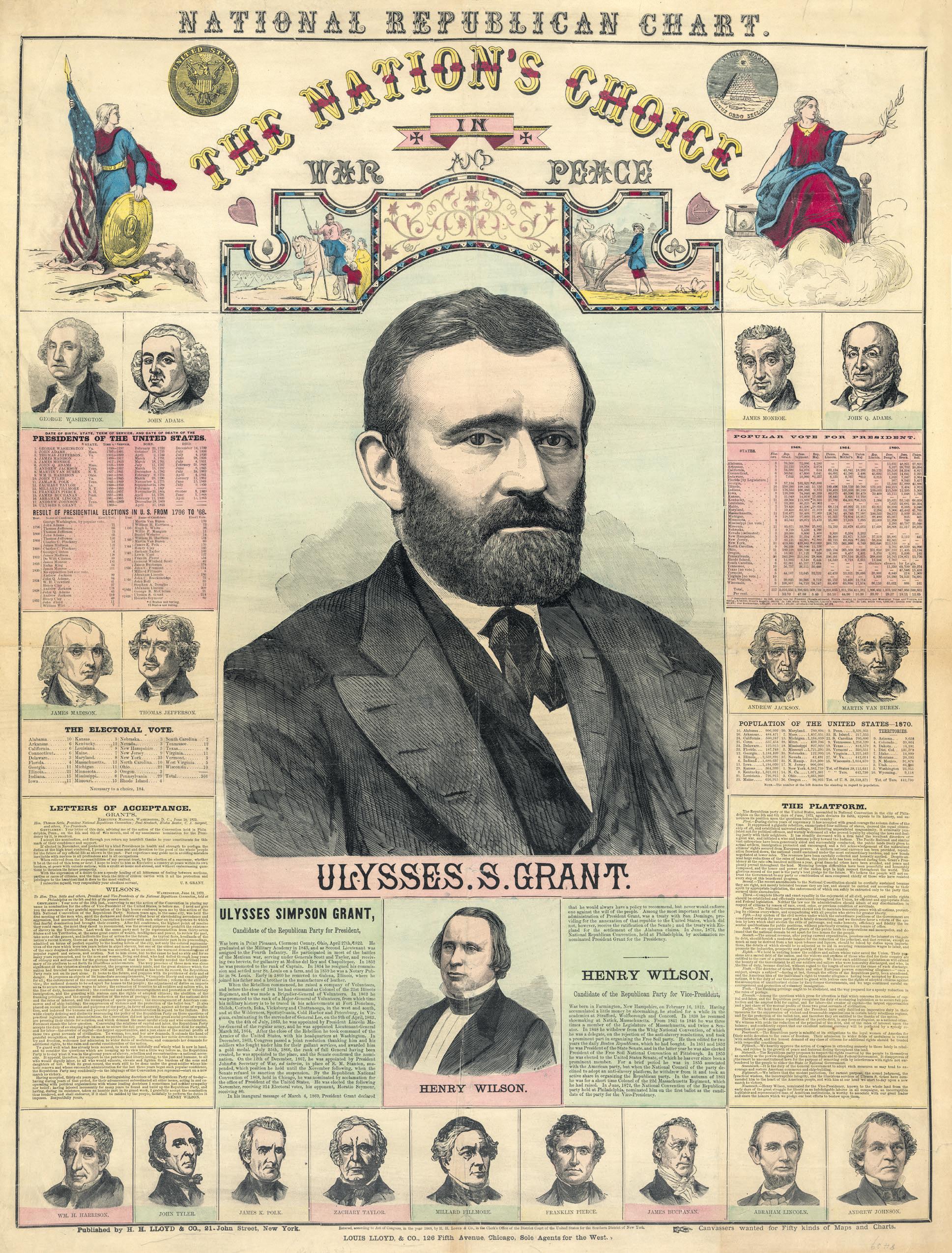
period of history was already one-third over. Technological advances, increased competition, and consumer awareness brought many new things to the business world and commerce. Some were good things like entrepreneurship; others were bad such as greed and fraud. Any evaluation of Grant’s Presidency must focus on whether his actions were effective and efficient based on the options available in the late 1800s. Effective means the actions he took were correct based on the situation. Efficient means that the right actions were executed in the most logical and expeditious manner possible.
Grant’s effectiveness or ineffectiveness is rooted in the content of his two inaugural addresses. He made his intentions quite clear in both inaugural addresses as to what he intended to do. He was very effective in his first term, because he accomplished all the items he addressed. He quickly determined he had a significant racial problem, not just the issue of freed slaves. He took steps to secure freedom from sectional prejudices in voting and in curbing, where possible, actions of the white counterrevolution and the Ku Klux Klan. He championed rights for many Native Americans. Economically he resumed specie payments and helped restore a fragile national credit program. Although no great businessman, he tried to employ the advice of his Republican Party peers to promote a healthier national commerce. His second term was not as effective, primarily because the media focused on the scandals and corruption that came to light. He still advocated securing civil rights for Blacks and Indians, stabilizing the economy, and promoting commerce and industry.
Efficiency is hard to measure simply because any country coming out of the ravages of a fouryear war has tremendous obstacles to overcome to become stable. During both terms, Grant used military force and the writ of habeas corpus quite extensively. These were drastic measures, for desperate times. Grant faced three distinct disadvantages from the moment he entered office:
1. a lack of political savvy and maturity for so high a position
2. a two-fold racial problem
3. a fickle Congress and general public.
The first disadvantage was like a junior officer trying to orchestrate and lead the entire Vicksburg campaign. To overcome the second disadvantage, Grant weighed the possibility of retaliatory action against whites
12 CWN September 2020
“The Republican Chart. The Nation’s Choice in War and Peace Ulysses S. Grant.” M.T. Boyd engraver. 1872. Library of Congress.
denying the rights of newly freed blacks. The third disadvantage was especially prevalent during his second term. As race relations intensified, and control of the House of Representatives shifted, Grant relied on continued use of military power despite it being very unpopular with Congress and the general public. These obstacles made any changes slow and incremental, giving the impression that Grant’s efforts were not efficient. However, a majority of his actions were efficient. They resulted in civil service and civil rights reform; suffrage for Blacks; the establishment of a future national parks system; a moderately stable economy; and increased growth and commerce. Unfortunately, his biggest downfall was a trusting nature and lack of business acumen. Additionally, Grant held the traditional army officer’s view that Congress was the boss.42 We can only speculate whether Grant made all the correct decisions. Grant could not reasonably have foretold all the nuances associated with the Gilded Age. If Grant was so bad, then there really should not have been much corruption in later presidencies, yet there was. Grant made some very hard, decidedly unpopular, decisions no matter which way he turned. In that respect, he is no different from modern presidents. It is unfair to evaluate Grant’s terms on what we know now. Grant made many correct choices. He used his military experience to help ensure that what was won during the war was not lost afterward. Unfortunately, when his second term ended in 1877, so did Reconstruction. Within months after Rutherford B. Hayes was inaugurated, he made good on his promise to quit intervening in the South. All the heart and hard work Grant expended into Reconstructing the South would wither away, or would it? The racial issues created long before the Civil War exploded soon after, but were contained under Grant but it would be some eighty years after Grant left office before the civil rights issues received the attention again that it deserved. Grant’s Reconstruction program was constructive. Grant was human. He was put into a position of having more power than he adequately knew what to do with. Like all of us, he used his experience, character, personality, strengths, and weaknesses every day that he served. He was an extraordinary military genius who, though promoted beyond his political capabilities, performed admirably. He truly deserves to be recognized as a good president and a military mastermind.
Bibliography
Primary Sources:
• Grant, Ulysses Simpson, Personal Memoirs of U.S. Grant. New York: Dover Publications, 1995.
• Oliver, Philip and Guild Press of Indiana, The Civil War CDRom: The War of the Rebellion (A Compilation of the Official Records of the Union and Confederate Armies. Carmel: Guild Press of Indiana, 1996.
Secondary Sources:

• Ables, Gisela R., Howard Bodner, Chris Drake, Harry Goss, Susan Hult, J. Kent McGaughy, Charles Robinson, and Joella Robinson, eds. (Houston Community College), “A Special Covenant…” Perspectives on American History. New York: American Heritage Custom Publishing, 1999.
• Boothe, F. Norton, Ulysses S. Grant (Great American Generals Series). New York: Gallery Books, 1990.
• Catton, Bruce, U.S. Grant and the American Military Tradition. Boston: Little, Brown and Company, 1954.
• ________. Grant Moves South, Boston: Little, Brown and Company, Inc., 1960
• Hart, B.H. Liddell, Sherman: Soldier, Realist, American. New York: Da Capo Press, 1993.
• Henretta, James A., David Brody, Susan Ware, and Marilynn S. Johnson, America’s History. Boston: Bedford/St. Martin’s, 2000.
America, Inc., 1998), p. 63.
7. Ibid., p. 64.
8. Gisela R. Ables, et al., eds., “A Special Covenant …” Perspective on American History, (New York: American Heritage Custom Publishing, 1999), p. 381.
9. James A. Henretta, et al,, America’s History, 4th edition, (Boston: Bedford/St. Martin’s, 2000), p. 481.
10. Ibid.
11. Ibid., pp. 477-479.

12. Ibid., p. 477.
13. Ibid., p. 478
14. Ibid.
15. Ibid.
16. Catton, U.S. Grant and the Military Tradition, p. 143.
17. Henretta, et all, p. 478.
18. Catton, U.S. Grant and the Military Tradition, p. 145.
19. Ibid., p. 147.
20. Henretta, et al., p. 479.
21. Ibid., p. 485.
22. Scaturro, p. 66.
23. Ibid., p. 68.


24. Ibid.
25. Ibid., p. 69.
26. Henretta, et al., p. 489.
27. Ibid.
28. Scaturro, p. 70.
29. Henretta, et al., p. 487.
30. Ibid.
31. Ibid., p. 494.
32. Ibid.
33. Ibid.
34. Scaturro, pp. 70-71.
35. Ibid.
36. Henretta, et al., p. 495.
37. Scaturro, p. 92.
38. Ibid., p. 79.
39. Ibid., p. 80.
40. Ibid., p. 82.
41. Henretta, et al., p. 502.
42. Catton, U.S. Grant and the American Military Tradition, p. 152.
CHARLESTON IN THE WAR
CHARLESTON IN THE WAR
100 Signi cant Civil War Photographs: Charleston in the War features newly restored images of scenes in the famed city, taken 1860–1865.
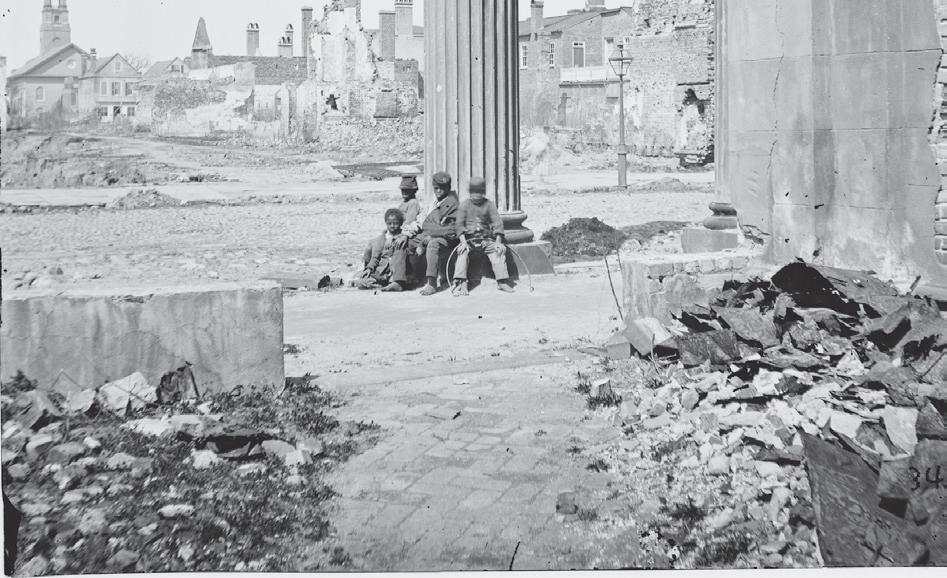

• Kennedy, Stetson, After Appomattox: How The South Won the War. Tampa: University Press of Florida, 1995.
e cameramen include the better-known, such as George N. Barnard and George S. Cook, as well as some lesser-known ones: Samuel Cooley, Charles Quinby, the partners Haas & Peale, Osborn & Durbec.
100 Signi cant Civil War Photographs: Charleston in the War features newly restored images of scenes in the famed city, taken 1860–1865. The cameramen include the better-known, such as George N. Barnard and George S. Cook, as well as some lesser-known ones: Samuel Cooley, Charles Quinby, the partners Haas & Peale, Osborn & Durbec.
• Morris, Roy Jr., Sheridan: The Life & Wars of General Phil Sheridan. New York: Vintage Civil War Library Vintage Books, 1993.
Text by Stephen Davis and Jack Melton accompanies each featured photograph, describing the pictured scenes and the history surrounding them. e selected images depict a variety of settings: that portion of Charleston known as e Battery, the “Burnt District” (the area of the city destroyed by the Great Fire of December 1861), the Charleston Arsenal, and the many churches that allow Charlestonians to call theirs “the Holy City.” Special sections of this book are devoted to the huge Blakely guns imported from England by the Confederates and close-ups of Barnard’s views.
• Scaturro, Frank J., President Grant Reconsidered. Lanham, MD: University Press of America, Inc., 1998
e history of Civil War Charleston goes back to e Defense of Charleston Harbor (1890) by John Johnson, Confederate major of engineers, and to Reminiscences of Forts Sumter and Moultrie in 1860-’61 (1876) by Capt. Abner Doubleday, Federal second-in-command. Since then Charlestonians have contributed to the history of their city, notably Robert N. Rosen and Richard W. Hatcher III. e historical text surrounding 100 Signi cant Photographs draws on these and other works. A unique feature is its reliance upon the writings of actual participants, such as Augustine T. Smythe (1842–1914) and Emma Edwards Holmes (1838–1910).
Text by Stephen Davis and Jack Melton accompanies each featured photograph, describing the pictured scenes and the history surrounding them. The selected images depict a variety of settings: that portion of Charleston known as The Battery, the “Burnt District” (the area of the city destroyed by the Great Fire of December 1861), the Charleston Arsenal, and the many churches that allow Charlestonians to call theirs “the Holy City.” Special sections of this book are devoted to the huge Blakely guns imported from England by the Confederates and close-ups of Barnard’s views.
• Woodward, W.E., Meet General Grant. The Literary Guild of America, Horace Liveright, Inc., 1928.
As a contribution to this literature, 100 Signi cant Civil War
Photographs: Charleston in the War o ers rewards for all readers, from the casual novice to the serious student.
Endnotes:
1. Bruce Catton, Grant Moves South, (Boston: Little, Brown and Company, Inc., 1960), p. 8.
2. Catton, U.S. Grant and the Military Tradition, p. 152.
3. F. Norton Boothe, Ulysses S. Grant (Great American Generals Series), (New York: Gallery Books, 1990), p. 69.
4. Ibid., p. 70.
5. Ibid.
6. Frank J. Scaturro, President Grant Reconsidered, (Lanham, MD: University Press of
The history of Civil War Charleston goes back to The Defense of Charleston Harbor (1890) by John Johnson, Confederate major of engineers, and to Reminiscences of Forts Sumter and Moultrie in 1860-’61 (1876) by Capt. Abner Doubleday, Federal second-in-command. Since then Charlestonians have contributed to the history of their city, notably Robert N. Rosen and Richard W. Hatcher III. The historical text surrounding 100 Signi cant Photographs draws on these and other works. A unique feature is its reliance upon the writings of actual participants, such as Augustine T. Smythe (1842–1914) and Emma Edwards Holmes (1838–1910).
As a contribution to this literature, 100 Signi cant Civil War Photographs: Charleston in the War o ers rewards for all readers, from the casual novice to the serious student.
160 pages, Over 100 Photos, Maps, Index, Bibliography, Softcover.
ISBN: 978-1-61850-167-7
$19.95 + 3.50
S&H
Order online at www.HistoricalPubs.com or
Richard Blumberg is a retired Army Reserve Colonel, who received his MA in Military History (Civil War Studies) from American Military University. He is Past President of the Houston, Texas Civil War Roundtable. He has served as Book Reviewer with CWN since 2003.

This is his second published article in Civil War News. He served as a presenter to the 2000 Conference on Women in the Civil War. He is scheduled to teach a community college online class in Civil War Logistics in October 2020.

13 September 2020 CWN Publishers/Authors Send your book(s) for review to: Civil War News 520 Folly Road, Suite 25 PMB 379 Charleston, SC 29412 bookreviews@civilwarnews.com
DAVIS & MELTON 100 SIGNIFICANT CIVIL WAR PHOTOGRAPHS CHARLESTON IN THE WAR
Stephen Davis JACK W. MELTON JR.
call
800-777-1862
“My Home, My Battlefield, My Passion”
by Tom Van Winkle
Entering the thick forest of the Wilderness, I carefully negotiate the underbrush as the sharp tree limbs seem to intentionally assault my face and arms. It is over ninety degrees, and the Virginia humidity seems even higher as my clothes become sodden with perspiration. I eventually see the light of a clearing and finally make it to the edge of the water.
This could easily be a narrative from any soldier during the 1864 battle of the Wilderness, but it is not. It is what I experience most days in my own backyard.
You see, my wife and I live on the Wilderness battlefield.
When your employer one day says to you, how would you like to relocate to Virginia and you can pick anywhere you want, opportunities for an armchair military historian become bountiful.
In 1994, my wife Lisa and I relocated from central New Jersey, which is rich with Revolutionary War resources, to Virginia, and settled in Spotsylvania County. We purchased a ready-built home on a partially cleared acre of land. The home also happens to be on a well-known water source that was once commonly known as Wilderness Run, prominent in both the Chancellorsville and Wilderness battles. The Run was dammed decades ago to create three lakes for our current subdivision. Several years ago, the
subdivision drained these lakes to repair the dams. I was surprised to see that the lake in our backyard still had the original cut of the Run, and it was bordering our own shoreline.
It was not long before we decided to purchase the heavily wooded lots on each side of our home. These are pristine undisturbed parts of the Wilderness Battlefield. It looks somewhat different now, the trees are much taller than they were one hundred and fifty-six years ago when they were only regrowth after being cut for making coal to power Virginia Governor Spotswood’s iron furnaces established about 1716. The underbrush is also not quite as thick. Still, if you tried to walk a straight line of ten people in one end of the forest they would never emerge in that straight line. Imagine the armies in 1864 trying to keep any sort of organization fighting in these woods, especially when the forest erupted in flames from the intense musket blasts.
I am extremely interested in the entire Civil War, particularly the Overland Campaign and its battles. Being within walking distance of the Orange Plank and Brock roads as well as Saunders Field and all the battlefield in between, I am most fascinated with
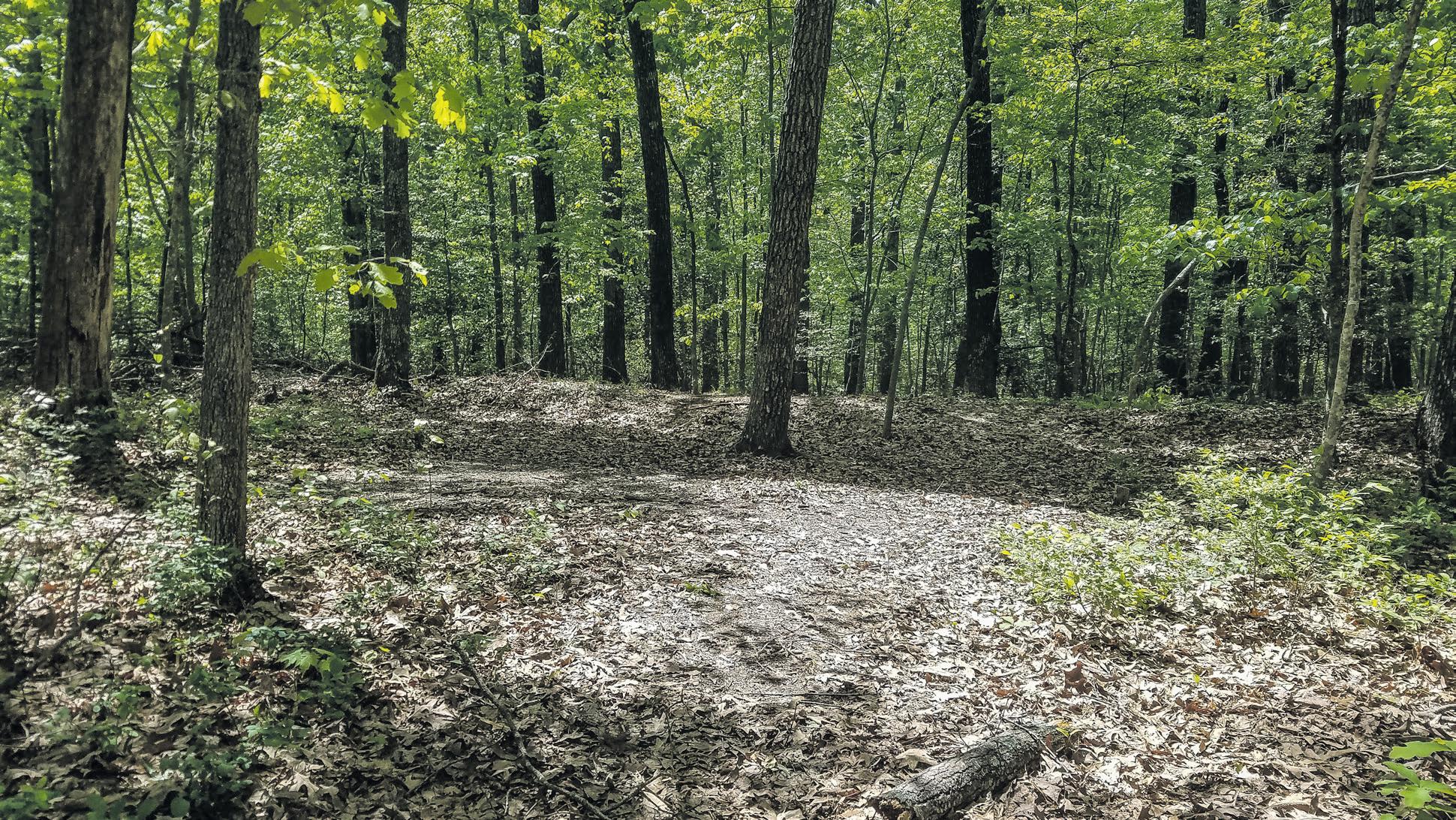
the Wilderness since it is so easily accessible. It is thought provoking when you wake up each morning and immediately stare into the throat of the beast that significantly hindered fighting by both Union and Confederate troops in early May 1863 and 1864. For General Lee, it was the great equalizer with his army being only a portion of the size of Grant’s. For General Grant, it took away his cavalry and gave him quite a surprise on the Orange Turnpike from unseen Rebel skirmishers.
I soon realized, by the license plates on vehicles buzzing around my area, that people were coming from all over the United States, in fact the world, to visit these sites. When you live near or within an historic area, it is easy to begin taking it for granted. For me, it made me dedicated to help saving it. This is important history. I often wonder how many of my neighbors are aware of what took place in their backyards.
About twenty-five years ago, shortly after moving here, I read in our subdivision newsletter, of a group trying to form with the intention of assisting the National Park Service in preserving and promoting the Wilderness Battlefield. I attended that meeting and never looked back. The Friends of Wilderness Battlefield was formed. I held several positions in this organization, culminating in five years as its president. The Friends organization is still going strong today.
As is true with all of us, life sometimes gets in the way. I had to retire from the preservation cause for a couple of years to take on my day job’s travel demands. This did have an upside; it gave me the opportunity to visit many battlefields across the country and learn more and more about the conflict. I was able to speak with other like-minded battlefield preservationists and came away
with best practices and success stories.
I always remind myself how fortunate I am to live on one of these battlefields, arguably one of the most important, when realizing that General Grant’s decision to follow General Lee contrasted with previous Union commanders who simply positioned their armies back where they started.
A few years later, I met an old friend, Dr. Mike Stevens, at a book signing. Dr. Mike happened to be the President of the Central Virginia Battlefields Trust. He asked so, what are you up to lately? To make a long story short, I wound up on the CVBT Board of Directors and for years held several positions culminating in, you guessed it, becoming the current President of CVBT. Never miss a meeting!
I am extremely honored to hold this position and work alongside our most dedicated Board members and staff. We have a staff of two, and the rest of us are all volunteers.
Although I have a comfortable CVBT office in Fredericksburg, I still do most of my work at my home office in the Wilderness. With my day job, I accomplish much of my preservation work at odd hours, and it makes for some exceptionally long days. When these hours begin to wear on me, I simply look out the window, overlooking the Wilderness, and imagine, in my mind’s eye, what occurred here in 1864. This reminds me why I am so passionate about preserving these battlefields.
I had a dear friend and wellknown Overland Campaign author stay over at the homestead one night. I had to ask, what do you think happened on our property in 1864? He paused for a second or two and answered, well, Burnside might have stopped for lunch in your front yard. To this day I am not sure if he was kidding me.
When we read a brilliantly written book chronicling one of these battles, it is easy to immerse yourself and feel as if you are there. Preserving these battlefields allows us all to walk upon those grounds where so many were wounded or gave their lives. Each one of those men has a story to tell, and those stories are embedded in those fields.
The men outside my window tell me their stories each day, and I listen to them. I answer back; I am doing my best to keep your memories alive. At CVBT, we are doing our best to save the ground where much of our nation’s history is embedded. We consider Fredericksburg, Chancellorsville, Wilderness, and Spotsylvania battlefields our backyard, and for almost twenty-five years, we have been preserving it for future generations to learn and conceivably better understand our past.
Tom Van Winkle is the President of the Central Virginia Battlefields Trust and author of several articles regarding the Civil War. He is also an historical film maker and has produced several films including a popular local cable TV series “History Scene™” Publishers:


100 Significant Civil War Photographs: Atlanta Campaign collection of George Barnard’s camera work. Most of the photographs are from Barnard’s time in Atlanta, mid-September to mid-November 1864, during the Federal occupation of the city. With this volume, Stephen Davis advances the scholarly literature of Barnardiana.
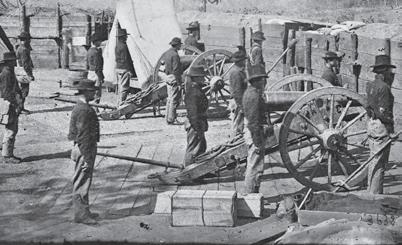
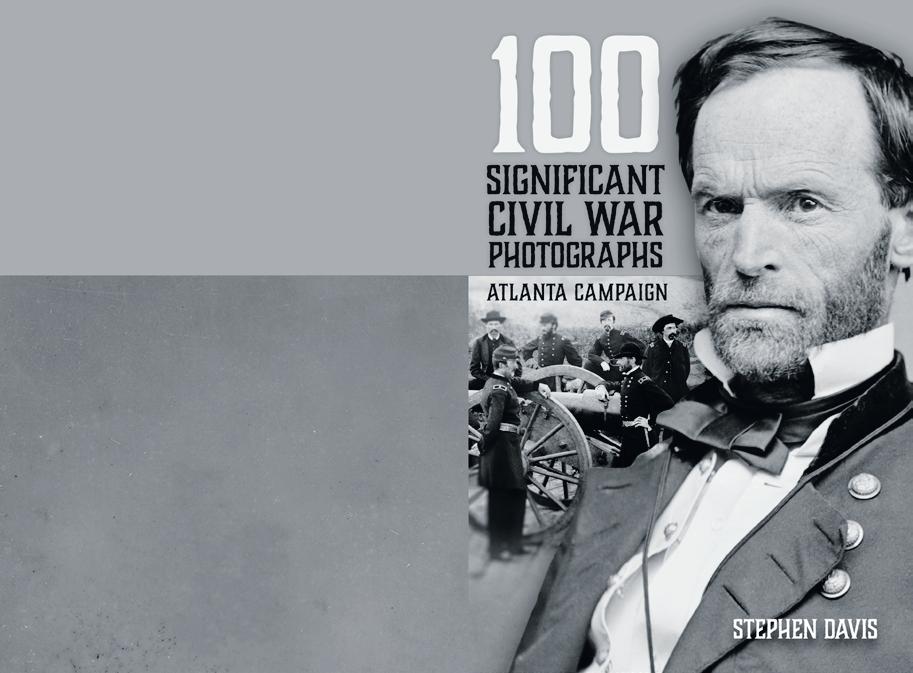
14 CWN September 2020
The American Civil War was the first war in which both sides widely used entrenchments, repeating rifles, ironclad warships, and telegraphed It was also the first American War to be extensively photographed. Mathew Brady, Alexander Gardner and Timothy O’Sullivan are famous for having made iconic photographs in the Civil War’s eastern theater. George N. Barnard deserves to be ranked in this top tier for his photographic work in the war’s western theater. A civilian photographer hired by Gen. William T. Sherman’s chief engineer to take pictures of fortifications around Atlanta, Barnard took several hundred of them in and around the city in the fall of 1864. His most famous is the site of Union Maj. Gen. James B. McPherson’s death in the battle of Atlanta, July 22, Thus far, no comprehensive, definitive listing has been made of the photographer’s work. The Library of Congress has 130 images; the U. S. Military Academy at West Point, New York, has at least 98 photographs, donated by Captain Poe’s widow. Other repositories, such as the Gilder Lehrman Institute of American History in New York City, have smaller collections. For this book we have chosen a hundred images we deem “significant,” though other students may wonder at some of our selections. We hope that this work will stimulate further interest in Barnardiana, and that other scholarly volumes are yet to come. The Atlanta Campaign STEPHEN DAVIS 100 SIGNIFICANT CIVIL WAR PHOTOGRAPHS ATLANTA CAMPAIGN $19.95 + $3.50 shipping 128 pages, photographs, maps, bibliography. $19.95 + $3.50 shipping. Softbound. ISBN: 978-1-61850-151-6. www.HistoricalPubs.com. Order online at www.HistoricalPubs.com or call 800-777-1862
Trenches on Wilderness Battlefield stand as a reminder of the intense fighting on this ground.
Tom Van Winkle (CVBT President) is a preservation leader and he’s inspired everyday by his view of Wilderness Battlefield.
send your book(s) for review to: Civil War News
Folly Road, Suite 25 PMB 379 Charleston, SC 29412
Please
520






Research Press Journal
I have mentioned Research Press Journal in this column before. It is a British publication, but there is a lot to learn in its pages for Americans, especially because British and European military shooters were far beyond their American counterparts up to and including the Civil War years. Training programs had been established in France and Britain in the 1850s, along with the introduction of rifled small arms as standard issue weapons in each nation’s military. Research Press has just released Journal –Issue 9, Summer 2020. It covers all aspects of nineteenth century shooting, from historical profiles to modern marksmanship matches. The 36-page PDF is free to
Although several Americans did travel abroad and studied European training methods, and even provided manuals for American use, in the decade before the Civil War, American armies seldom practiced shooting. The 13th New Jersey Infantry, for example, joined the Army of the Potomac just before the Battle of Antietam but had never loaded or fired their rifle muskets. There were exceptions, of course, with Confederate sharpshooters and General Patrick Cleburne’s command.

After the war, the American army and National Guard made up for lost time, and, along with civilian shooting hobbyists, held a number of long-range target matches.
The magazine covers the history of 19th century arms, but also modern shooting of origi-




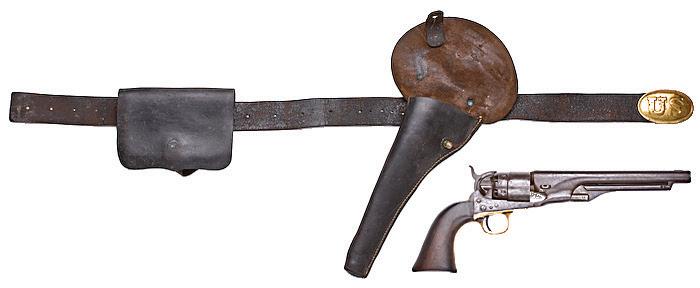 by Joe Bilby
by Joe Bilby
is also an asset to historians and researchers, who post their needs at the beginning of each issue. It is a perfect merge of shooters and historians. In the current issue, firearms scholars are asking for information on British army percussion rifles and the famed Whitworth target and sniper rifle. Not unexpectedly, Research Press is an authority on 19th century European arms particularly British ones, although the magazine has expanded to cover aspects of American marksmanship and history. The initial article is on the Black Powder Rifle Association, a new organization based in Colorado and Wyoming that has 55 active shooter members, including its “first ever junior shooter, Emily Hayes of Wyoming.” The matches thus far are at “medium” ranges, from


been at least one “long range” match at 1,000 yards. The Black Powder Rifle Association is working on attracting top shooters from across the county to its future matches. For more information on the group, check out their website at https://bptra.org.


Arthur Hare’s account of the history of the Brunswick Rifle, the predecessor of the British P53 Enfield, in this issue of the Research Press Journal is very comprehensive and well-illustrated. The Brunswick, originally a German design, used a special spherical ball and was not overly popular among rifle regiment troops it was issued to. It went through a number of variations during its service. During the Enfield trials one officer wondered how the Brunswick was ever approved, due to difficulty in loading its round ball ammunition that included a belt around the ball intended to facilitate loading into the two-groove barrel.
This issue also has an essay on the powder mills of famed British powder maker Curtis and Harvey by a direct descendant of the original owners, W.S. Curtis. Starting with the Hounslow works in 1820, the Curtis powder empire soon took over the market, along with a number of other black powder manufacturers across Great Britain and even one mill in Canada.
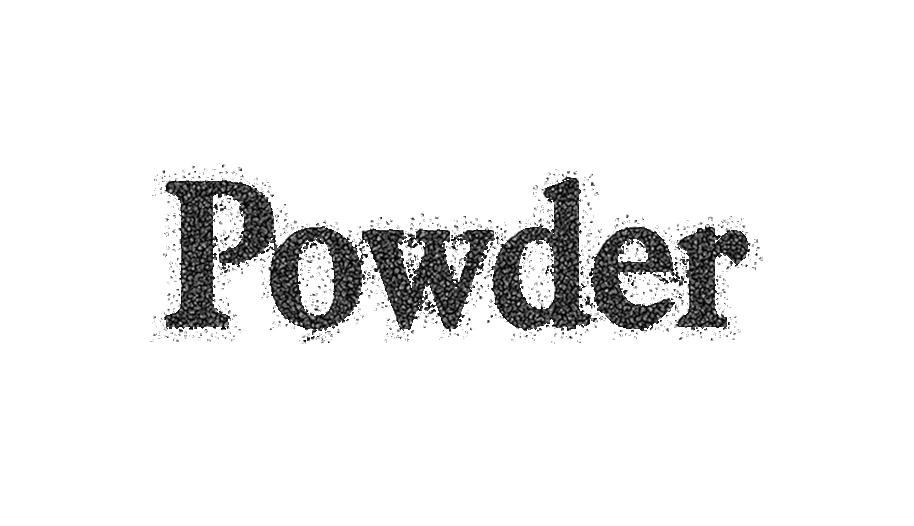
After giving a brief background on the firm’s history, Curtis provides a reprint of an account about an 1896 visit from William Oliver Greener. Greener, the editor of The Sporting Goods Review and son of the renowned gun maker William Wellington Greener, went to the Hounseville
powder mills, the initial mills acquired by Curtis and Harvey.
Another reprint in this issue is a chronicle of Military Rifle Shooting in America, first published in Arms and Explosives magazine in London in July 1903. The author laments the decline of public interest in such shooting. Beyond that, there is a detailed look at sights in use at the time. There are other articles and book reviews and the history of the British National Match in this issue as well. If you are interested in the evolution of 19th century military shooting, you should take a look at this publication. The current and back issues are available at:
http://www.researchpress. co.uk/index.php/publishing/ category/5-journal.
Joseph G. Bilby received his BA and MA degrees in history from Seton Hall University and served as a lieutenant in the 1st Infantry Division in 1966–1967. He is Assistant Curator of the New Jersey National Guard and Militia Museum, a freelance writer and historical consultant and author or editor of 21 books and over 400 articles on N.J. and military history and firearms. He is also publications editor for the N.J. Civil War 150 Committee and edited the award winning New Jersey Goes to War. His latest book, New Jersey: A Military History, was published by Westholme Publishing in 2017. He has received an award for contributions to Monmouth County (N.J.) history and an Award of Merit from the N.J. Historical Commission for contributions to the state’s military history. He can be contacted by email at jgbilby44@aol.com.

16 CWN September 2020 Carolina Antique Arms Civil War Period Arms & Equipment Michael Dyches www.CarolinaAntiqueArms.com Phone: 864-871-5325 Email: mdyches.ogma@gmail.com
Publishers: Please send your book(s) for review to: Civil War News 520 Folly Road, Suite 25 PMB 379 Charleston, SC 29412
Chattanooga Antique Militaria & Americana Show News



CHATTANOOGA, Tenn.—
On July 25 & 26 one of the first shows during Covid-19 was held. In a year when so many things have gone wrong, something finally went right: the American Digger Chattanooga Antique Military & Americana Show & Sale. With the cancellation of a key Civil War show a few weeks before, and cancellation of another major artifact show a few weeks afterward, American Digger was able to meet all required mandates needed to be allowed to have a show.
How does one have a show in the midst of a pandemic? Very carefully. By using common sense and following Hamilton County, Tenn., health mandates, the planned show went forward. Among the requirements were mandatory masks, social distancing, and one-way aisles.

American Digger Events also announced a name change for the show to more completely incorporate the wide variety of eras displayed by vendors and exhibitors. While the Civil War era is still a big focus, more and more

pre-1945 collectibles are appearing at all shows. If anything, American Digger has lagged behind in a name change best reflecting what these events have become.


With the Covid-19 pandemic still gripping the world, there were concerns that a last minute cancellation could be caused by local government or even Federal actions. The town of East Ridge, where the show is held annually, offered their full support to help bring the event back this year. Although the crowd was limited to 900 people inside at any given time, social distancing was easy in the 34,000 square foot Camp Jordan Arena. Shows have been extremely scarce this year, allowing many dealers and collectors to unveil items they had accumulated in the down time. Some items have not been on the open market in many years, if ever, and the show created a great opportunity to add rarely seen items to individual collections.
Most attendees praised the mandatory use of masks as a way to not only meet the local requirements, but to help assure that everyone remained safe. In a great example of making lemonade from lemons, a mask contest was held, spearheaded by American Digger magazine’s own Anita Holcombe. Vendors and dealers voted on each other’s masks, with winner Jerry Raisor receiving a prize package of American Digger products as well as perhaps the rarest of items in this unusual year: a four-roll pack of toilet tissue.
The awards were as follows:
Best of Show-Chattanooga Dug
Collection: Jeremiah Simmons; Most Educational: Chattanooga History, Matt Miller; Best Dug
Artifact: A Risque Pipe, Bryan Davis; and Best Non-Dug Artifact: 1st Virginia flag, John
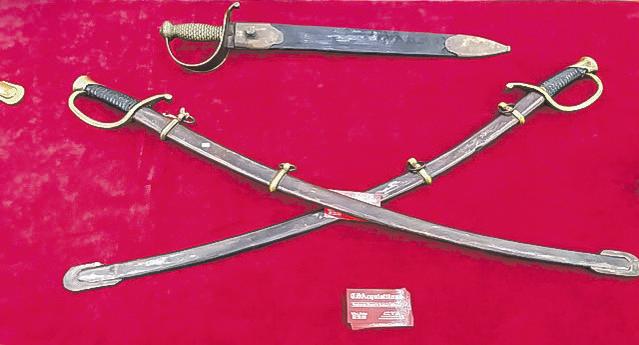
Young.
As to where the shows go from here is anyone’s guess, but one thing is for sure: the American Digger Chattanooga Show made its mark in a big way. For more info visit americandigger.com.
A little of everything pre-1945 could be found in the show hall. Even so, the majority seemed to be 19th century and beyond.
17 September 2020 CWN
In this photo are all things necessary to have a show in 2020Social distancing, mandatory masks, marked one-way aisles, and quality artifacts. All photos by American Digger.
As he is noted for, Wallace Markert of CSA Acquisitions had a good selection of rare weaponry.
American Digger Senior Editor Bob Roach and publisher-show promoter Butch Holcombe in front of the American Digger tables.
War Horses
The horse was the backbone of the war effort, especially for the Confederate side. They carried generals and moved artillery and ambulances. One general ordered that, “Every opportunity at a halt during a march should be taken advantage of to cut grass, wheat, or oats and extraordinary care be taken of the horses upon which everything depends.” The first thing Gen. Robert E. Lee asked for after the surrender at Appomattox was rations for his troops and feed/fodder for the horses. The surrender document included a negotiated provision for every Confederate cavalryman to take his horse home with him. There were up to one million horses and mules killed during the Civil War. At the beginning of the war more horses were being killed than men. At the Battle of
Gettysburg, at least 1,500 horses and mules were killed, leaving burial details the horrendous task of disposing of bloated animal carcasses during the heat of July.
A War Horse was required to be fast, steady under fire, strong, and maneuverable. While there is no one particular breed unique to the antebellum South or specifically the war effort, the popularity of horse racing meant the greater numbers (and best) war horses were bred there. The breed known as the American Saddlebred was very popular, easy both to ride and to train. Kentucky Saddlers, Thoroughbreds, Morgans, Standardbreds, and Tennessee Walkers were also widely used.
According to an article in the New York Times, the last Confederate war horse named “Old Jack” died on December 23, 1889, at age 33. He did his service for Lieutenant R.T. Craighill of Nelson’s Artillery
Battalion from early 1862 until the end of the war. Old Jack was injured three times in battle. There is anecdotal evidence that a horse named “Old Jim” was the last surviving Civil War horse and lived until at least 1894. His rider Lieutenant McMahon, was killed in action, but post-bellum Old Jim went back to live in Aiken, S.C. Who knows?
Craig L. Barry was born in Charlottesville, Va. He holds his BA and Masters degrees from the University of North Carolina (Charlotte). Craig served The Watchdog Civil War Quarterly as Associate Editor and Editor from 2003–2017. The Watchdog published books and columns on 19th-century material and donated all funds from publications to battlefield preservation. He is the author of several books including The Civil War Musket: A Handbook for Historical Accuracy (2006, 2011), The Unfinished Fight: Essays on Confederate Material Culture Vol. I and II (2012, 2013) and four books in the Suppliers to the Confederacy series on English Arms & Accoutrements, Quartermaster stores and other European imports.
Digital Issues of CWN are available by subscription alone or with print plus archives from 2012 at CivilWarNews.com

Here is a list of some of the better known war horses and their owners who served during the Civil War. In some cases, the horse is as well-known as its owner; in others the name is practically lost to history:
• Tom Telegraph: Col. Turner Ashby Jr.
• Old Charley: Gen. John Bell Hood; he also rode a horse called Jeff Davis.
• Baldy: Gen. George Gordon Meade.
• Blackjack: President Jefferson Davis.
• Red Eye: Gen. Richard Garnett.
• Cincinnati: Gen. Ulysses S. Grant; he also rode a horse named Jeff Davis, apparently a popular equestrian name.
• Black Hawk: Maj. Gen. William B. Bate.
• Dixie: Maj. Gen. Patrick R. Cleburne. Dixie was killed at Perryville in October 1862.
• Meg Merrilies: Gen. Edward Porter Alexander; he also rode a horse named Dixie.
• Rifle: Lt. Gen. Richard S. Ewell.
• King Philip: Gen. Nathan Bedford Forrest, who also owned and rode Roderick and Highlander. King Philip was apparently not one of the twenty-nine horses shot out from under General Forrest. King Philip survived the war and there is anecdotal evidence he still bit men dressed in blue uniforms years after the war ended.
• Old Black: Gen. George Pickett.
• Cecelia: Col. John Singleton Mosby.
• Highfly: Gen. JEB Stuart; he also rode Virginia, Skylark, and My Maryland.
• Joe Smith: Brig. Gen. Adam R. “Stovepipe” Johnson.
• Nellie Gray: Maj. Gen. Fitzhugh Lee; this mare was numbered among the dead at Opequon (Third Battle of Winchester).
• Old Fox: Col. E G. Skinner of the 1st Virginia Infantry.
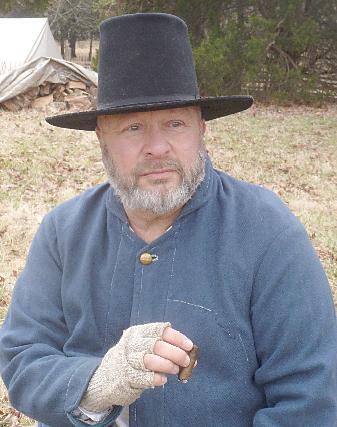
• Sardanapalus: Brig. Gen. M.J. Thompson, Missouri State Guard.
• Hero: Lt. Gen. James Longstreet.
• Little Sorrel: Gen. Thomas J. “Stonewall” Jackson. Little Sorrel, Jackson’s favorite horse, is still on duty in the museum at Virginia Military Institute, Lexington, Va. He also rode Gaunt Sorrel, Superior, Staunton Steed, and Trojan Mare.
• Traveller: Gen. Robert E. Lee; he also rode Brown Roan, Richmond, Grace Darling, Lucy Long (gift from JEB Stuart), and Ajax. Traveller (1857–1871) was originally named Jeff Davis. He is buried a few yards from Lee, outside Lee Chapel, Washington and Lee University, where visitors still place apples, sugar cubes, and coins on his grave.
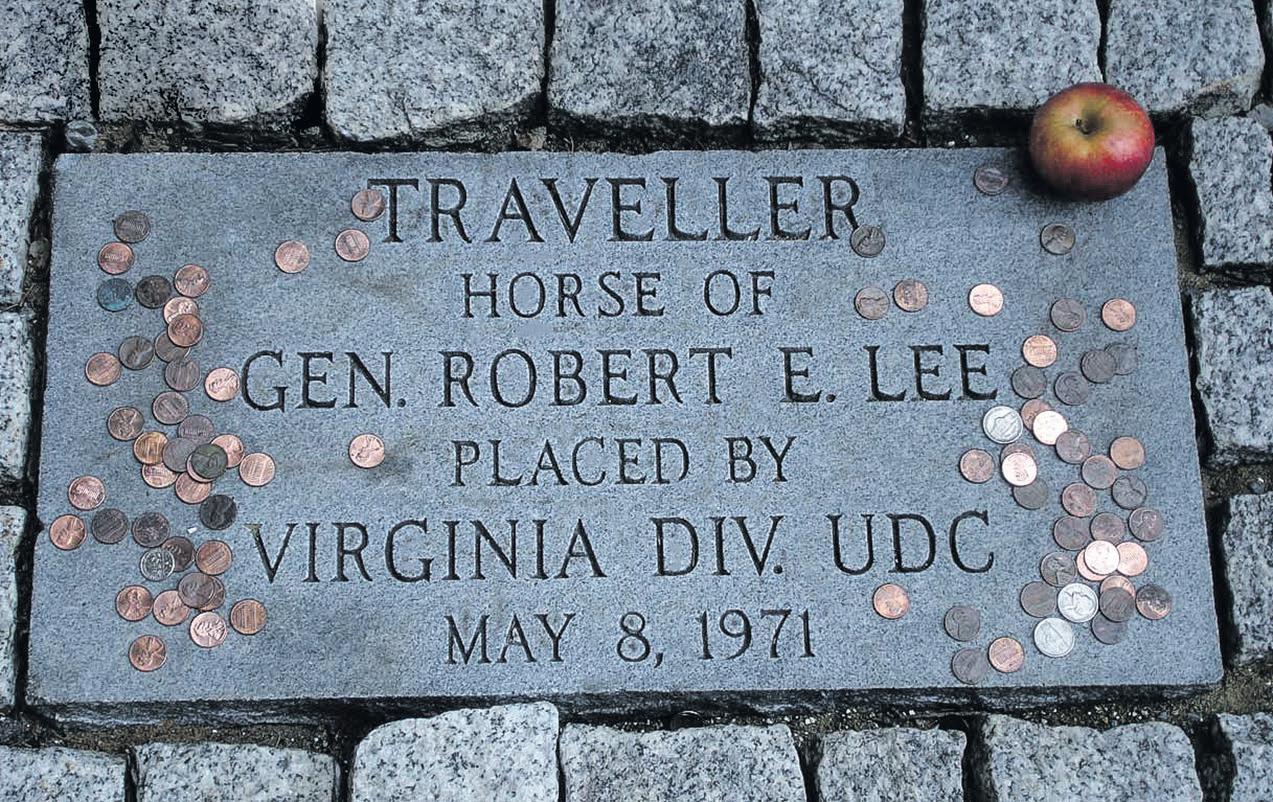
• Fire-eater: Thoroughbred ridden by Gen. Albert S. Johnston when he was killed at Shiloh.
• Milroy: Gen. John B. Gordon, captured from Union General Robert Milroy.
• Old Isham: Gen. Benjamin Cheatham.
• Gray Bull: Gen. Jubal Early.
• Butler: Gen. Wade Hampton also rode a horse named Captain
• Folly: Gen. Leonidas Polk.
• Jack: Gen. “Fighting” Joe Wheeler.
• Black Bess: Gen. John Hunt Morgan.
• Beauregard: Capt. W.I. Rasin, 1st Maryland Cavalry.
• Firefly: Gen. Robert Rodes.
• Shiloh: Gen. William J. Hardee.
• Bucephalus: Gen. Sterling Price.
• Pocahontas: Gen. George “Maryland” Steuart.
• Jinny: Gen. Isaac Trimble.
18 CWN September 2020
Traveller’s grave at Washington and Lee University.
Deadlines for Advertising or Editorial Submissions is the 20th of each month. Email to: ads@civilwarnews.com
Photo by Hal Jespersen.
Little Sorrel, Stonewall Jackson’s horse, on the VMI Parade Ground, ca. 1890. After the war, Little Sorrel first returned to North Carolina with Mrs. Jackson, and subsequently was sent to VMI, where he grazed on the VMI Parade Ground and was a favorite of cadets. He died in March 1886, at the age of 36, and his mounted hide is now on display in the VMI Museum in Lexington, Va. Little Sorrel’s bones were cremated and interred on the grounds of VMI in 1997. VMI Archives Photographs Collection. Visit http://digitalcollections.vmi.edu/digital/ collection/p15821coll7/id/4067 for more information about Little Sorrel.

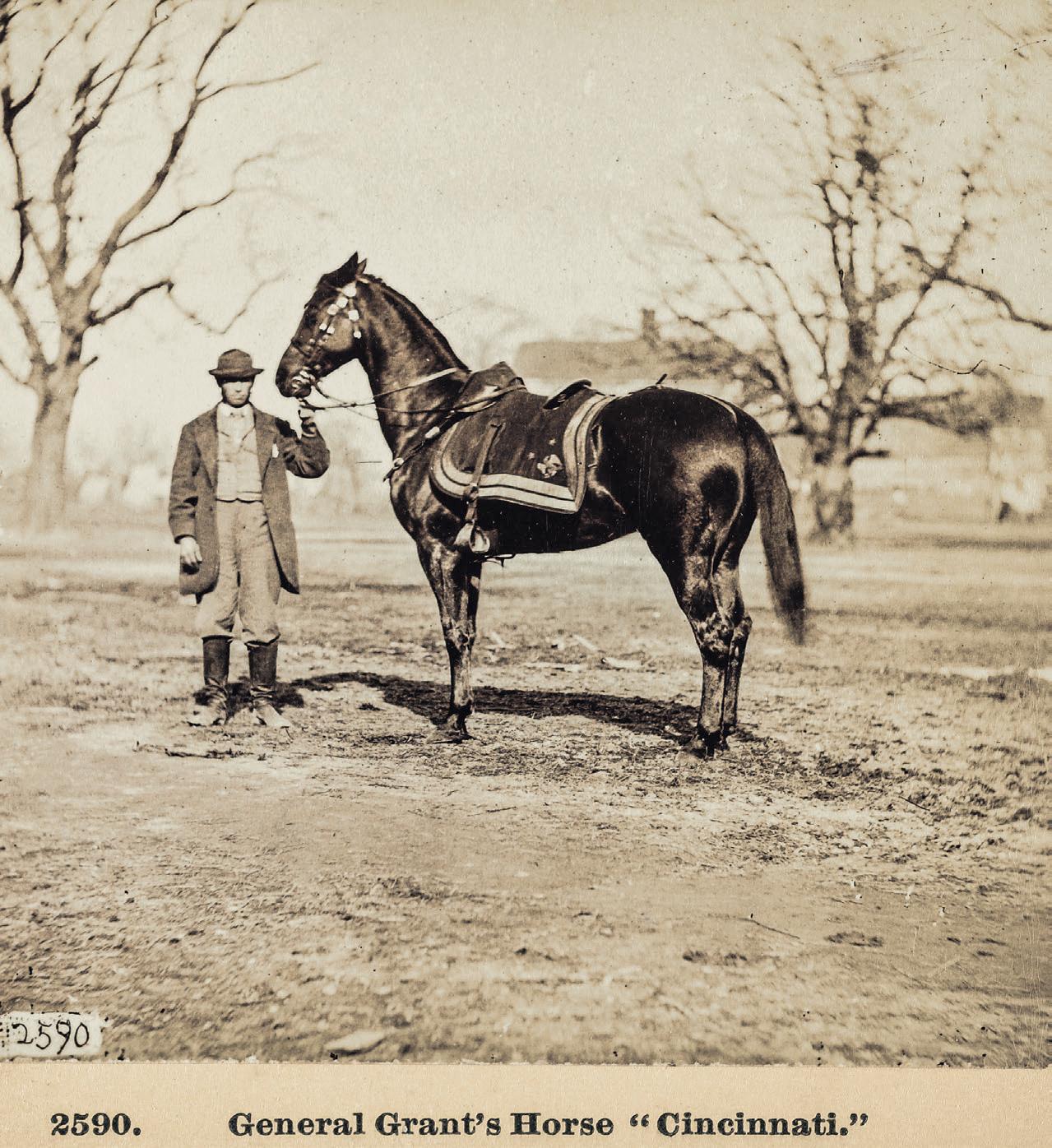

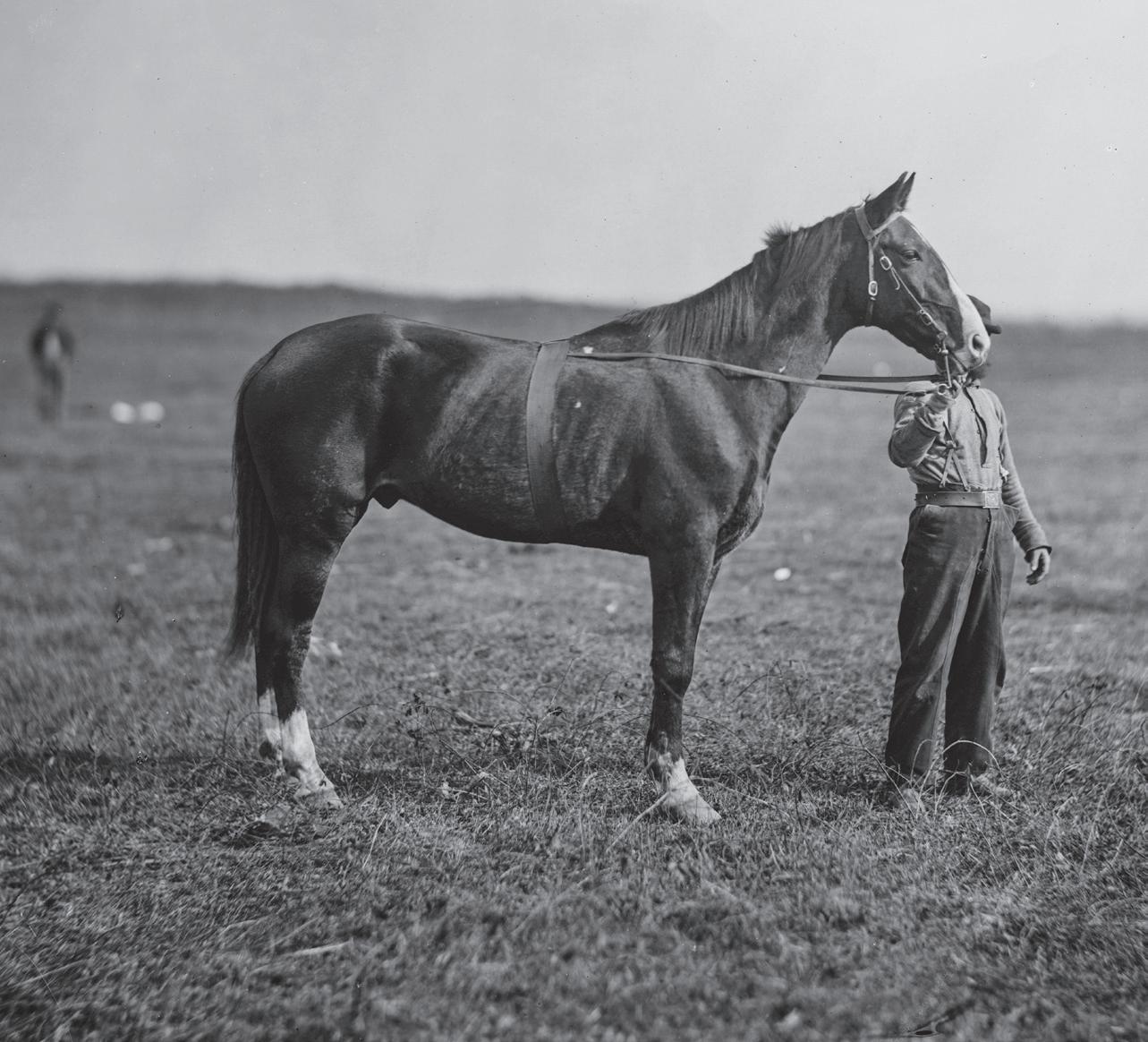
In Henry K. Douglas’s memoirs, I Rode With Stonewall, he left a description of Little Sorrel:


General Jackson never had a handsome horse in the army, nothing to compare to General Lee’s “Traveller,” or Stuart’s “Maryland, My Maryland,” or Ashby’s white or black stallions. “Little Sorrel” was a plebeian-looking little beast, not a chestnut; he was stocky and well-made, round-barreled, …good shoulder, excellent legs and feet, not fourteen hands high, of boundless endurance, good appetite, good but heavy head and neck, and natural pacer with little action and no style… It would have been impossible to have found another horse that would have suited his owner so exactly – he was made for him… The endurance of the little animal was marvelous, and the General was apt to forget it was exceptional. He never seemed to change in looks or condition; his gait, except when the yells of the soldiers warmed him into a gallop, was always the same, an amble; he could eat a ton of hay or live on cobs…


19 September 2020 CWN
Gen. George G. Meade’s horse Baldy. Library of Congress.
Gen. Robert E. Lee, in uniform, on Traveller. Photographed by A.H. Plecker’s Travelling Gallery. Liljenquist Family Collection of Civil War Photographs Library of Congress.
of
CSA National Defense Medals & other banned internet items Civil War Recreations WWW.CWMEDALS.COM cwmedals@yahoo.com
Smithbridge Rd., Unit 61, Chester Heights, PA 19017
Gen. Ulysses S. Grant’s horse Cincinnati. This photograph was taken at City Point, Va., in March 1865. Library of Congress.
Loyal Legion
the Confederacy
1
Publishers: Send your book(s) for review to: Civil War News 520 Folly Road, Suite 25 PMB 379 Charleston, SC 29412 REINFORCEMENTS MAKE ALL THE DIFFERENCE!!! Nobody even comes close to building a Civil War tent with as much attention to reinforcing the stress areas as Panther. Our extra heavy duty reinforcing is just one of the added features that makes Panther tentage the best you can buy! PANTHER Catalog - $2 Web: www.pantherprimitives.com 160 pages of the best selection of historical reenactment items from Medieval era to Civil War era. Includes over 60 pages on our famous tents and a 4-color section. Your $2 cost is refundable with your first order. SEND for copy TODAY The Best Tents in History P.O. Box 32N Normantown WV 25267 (304) 462-7718 Want To Advertise In Civil War News? Email us at ads@ civilwarnews.com or Call 800-777-1862. For a rate sheet visit: civilwarnews.com
Virginia Center for Civil War Studies Civil War Sources
the right place.”
The word cloud, shown above, provides a quick way to drilldown to specific sources. For example, diaries offer a glimpse into the everyday life of soldiers, civilians, politicians, etc. Click on ‘Diaries’ in the word cloud, and 22 collections appear in the navigation bar on the left. Various repositories, from Duke University to local historic site collections, comprise the entities holding these diaries. Another example:
Ulysses S. Grant; selecting Grant in the word cloud nets the Grant Library at Mississippi State University and the digitized Papers of Ulysses S. Grant. See the image above. Users can search using keywords; remember to clear your selection before continuing to research new subject matter. Next month, we will investigate additional primary sources. Until then, good luck with studying the Civil War!

Michael K. Shaffer is a Civil War historian, author, lecturer, instructor, and a member of the Society of Civil War Historians, the Historians of the Civil War Western Theater, and the Georgia Association of Historians. Readers may contact him at mkscdr11@gmail.com, or to request speaking engagements, via his website www.civilwarhistorian.net. Follow Michael on Facebook www.facebook.com/ michael.k.shaffer and Twitter @ michaelkshaffer.
Civil War Sources page at Virginia Center for Civil War Studies.
The Virginia Center for Civil War Studies, currently operating under the guidance of Paul Quigley, offers a vast array of online material useful to historians, educators, and anyone with interest in this segment of our nation’s history. Please visit the homepage at https://civilwar.vt.edu. For this article, the ‘Civil War Sources’ section of the site will serve as the focus. Visit https:// www.sources.civilwar.vt.edu/#!/ sites to access this sector.


Locating primary source material online, while offering convenience, can also prove challenging. One must stay up to date on new sites, additions to
existing sites, and changes to URLs. Virginia Tech makes the process of locating primary source material online simpler by amassing a wide selection of resources in one, easy to navigate spot. The introduction to their Sources section captures best what researchers will find. “Explore the wealth of digitized primary sources on Civil War-era history. Browse our listing of the best databases online. Click on the tags to explore by theme. Or search for whatever interests you. Whether you’re beginning a major research project or just looking for fascinating new insights into the Civil War era, you’re in

A page from Grant’s Personal Memoirs. Ulysses S. Grant Papers: Series 4, Personal Memoirs, 1884-1885; 1885. Library of Congress.

20 CWN September 2020
Grant Papers section of the site.

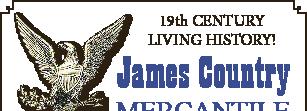



21 September 2020 CWN Publishers: Please send your book(s) for review to: Civil War News 520 Folly Rd, Suite 25 PMB 379, Charleston, SC 29412
Give Them Cold Steel Armstrong’s Raid – Part I


“It is reported that a rebel force of 6,000 cavalry have been sent to attack our lines. Keep a sharp lookout.” – U.S. Gen. Ulysses S. Grant
On Aug. 14, 1862, C.S. Gen Braxton Bragg launched his Kentucky Campaign to drive U.S. Gen. Don Carlos Buell out of Kentucky and Tennessee. To prevent Gen. Ulysses S. Grant from sending Buell troops, Grant had to be kept occupied. C.S. Col. Francis “Frank” C. Armstrong was promoted to general for the job. Armstrong was ordered to gather the scattered Army of the West cavalry units and disrupt Federal supply and communication lines and gather intelligence in west Tennessee.
At daybreak on Aug. 22, Armstrong’s cavalry rode out of Guntown, Miss., traveled over 60 miles, and linked up with Col. William “Red” Jackson’s horsemen in Holly Springs, Miss. Four days later, Armstrong “now had perhaps thirty-five hundred, rank
and file. We had never moved with as large a body of cavalry before. Generally speaking, they were well mounted and a fine-looking body of men,” wrote Sgt. R.R. Hancock, 2nd Tenn. Cavalry.
Armstrong may not have realized it, but as early as Aug. 28, his raid was already accomplishing one objective. The Federal telegraph wire had been spreading news of his approach. Grant had to deny Gen. Henry Halleck’s request to send reinforcements for Buell due to the large numbers of Confederate cavalry in the area.


On Aug. 30, the Confederate advance rode in column formation and the horses were kicking up dust clouds. The Federals stationed at Bolivar, Tenn., were sent out to investigate a report that “a small rebel force was menacing our pickets.” Armstrong’s men had been busy cutting up the Mobile and Ohio railroad. Two companies of the 11th Cavalry, one section of the 9th Indiana Battery, 20th Ohio Infantry, and three companies of the 78th Ohio Infantry were sent out. The remaining 78th companies were ordered to be ready for movement.
Col. Mortimer D. Leggett led the advance with 45 20th Ohio infantrymen mounted on mules. Around 1 p.m. the two forces met “in a piece of woodland,” on the Van Buren Road, about 5 ½ miles from Bolivar. It was Armstrong’s 7th Tenn. Cavalry vs. the lead companies of the 20th Ohio. Leggett observed that, “the nature of the ground being such that cavalry could not be used, some 12 or 14 of those who had [Sharps] carbines dismounted and formed with the infantry. After driving the enemy steadily but slowly for three-fourths of a mile I gained a position where I had a distinct view of the foe and found that I was contending with a force of over 6,000 instead of 300 or 400.” Leggett sent for reinforcements. Due to the terrain, he realized that “… my force must have been annihilated had I attempted to escape from such overwhelming numbers. I had not men enough to retreat, and consequently had no choice left but to fight until support could reach us.”
Two hours later, six more companies of the 20th Ohio joined the fight with two guns of the 9th Indiana Battery. The battery was sent back a mile to avoid capture. Dust clouds had masked the true number of the Rebels. Now the dust clouds signaled the enemy’s intention to get around the Union’s flank. Leggett led the action to block Armstrong’s flanking move. Leading the Rebel charge was Capt. John R. “Rock” Champion, 2nd Mo. Cavalry. He was shot dead before reaching his foe. As fighting escalated, Col. Harvey Hogg with four companies of the 2nd Ill. Cavalry arrived.
Hogg, an anti-slavery lawyer, politician, and eloquent orator, was raised in a slave

owning family. He moved to Bloomington, Ill., and may have become acquainted with Abraham Lincoln while practicing law on the Eight Circuit. In 1857, both men were part of the losing team prosecuting Isaac Wyant for murder. Richard Yates, Governor of Illinois, offered the highly regarded Hogg the position of Lt. Col in the 2nd Ill. Cavalry. Hogg would reached out to the president through fellow 8th Circuit attorney and Lincoln family lawyer, Leonard Swett, requesting guns and other supplies for his men. As for meeting the enemy, Hogg would instruct his men with his “oft-quoted order: ‘If we do ... don’t use your pistols but give them the cold steel. The saber is the weapon for the cavalry to rely on.’”
Armstrong’s men began tearing down fences along the road and entering the field to fire on Hogg’s men. Leggett spotted Col. Robert “Black Bob” McCulloch, 2nd Mo. Cavalry, preparing to charge behind them. Leggett told
Hogg, “If he had any doubt about holding his position he had better fall back and not receive their charge. He promptly replied, ‘Colonel Leggett, for God’s sake don’t order me back.’ I replied, ‘Meet them with a charge, colonel, and may Heaven bless you.’ He immediately ordered his men to draw their sabers, and after giving the order ‘Forward’ he exclaimed, ‘Give them cold steel, boys,’ and darting ahead of his men he fell pierced with nine balls.”
“McCulloch waved his saber and cheered the men on, and in we went with the rebel yell, cutting and slashing as we again drove them from the field,” recalled C.Y. Ford, 2nd Mo. The fighting intensified as the men fought hand-to-hand. The 78th Ohio arrived, shoring up the Federal line. Leggett wanted to engage his guns. The Federals retreated to their waiting artillery. Lt. Wallace Hight’s 9th Ind. Battery “opened upon them with shot and shell and caused them

22 CWN September 2020
Col. Harvey Hogg. Colorization © 2020 civilwarincolor.com. Courtesy, McLean County Museum of History, Bloomington, Ill.)
Gen. Mortimer D. Leggett. Colorization © 2020 civilwarincolor. com. Courtesy civilwarincolor.com/cwn. Library of Congress.
to break and disperse in great disorder.”
After more than seven hours of fighting the Federals retreated to Bolivar. The Confederates made camp on Clearwater Creek with 71 Federal POWs. Pvt. John Hubbard, 7th Tenn. Cavalry, who had enlisted in Bolivar over a year earlier, wrote of Champion, “his body was borne from the field by two of his troopers. I saw for the first time a dead Confederate who had been slain in battle.” Hogg’s body was retrieved by his friends and shipped back to Bloomington. On his 29th birthday, Hogg was buried in what was the largest funeral in Bloomington up to that time.
Both sides thought they had won the Battle of Bolivar. Leggett reported, “900 of our brave soldiers met and drove from the field over 6,000 well-officered and well-armed rebels.” Leggett would return the next day to finish the job, but the Confederates were moving on to a different target.
Armstrong also sent a report. “Just finished whipping the enemy in front of Bolivar; ran in town. I believe they will leave the country. West Tennessee is almost free of the invaders. All needed is advance of the infantry. … You will hear of us again in a day or so.”

Sources:
• OR Series I, Volume XVII, Part I, Chap. XXIX, pp. 44-51.


• Alexander, H. (1962). The Armstrong Raid Including the Battles of Bolivar, Medon Station and Britton Lane. Tennessee Historical Quarterly 21(1), pp. 31-46.

• Black, Robert W. Cavalry Raids of the Civil War. Stackpole Books, 2004.
• Owens, Ryan, “Harvey Hogg,” McLean County Museum of History, 2018.
• Eckley, Robert S. Lincoln’s Forgotten Friend, Leonard Swett. Southern Illinois University Press, 2012.
• Wyllie, Arthur. Hancock’s Diary: Or A History of the Second Tennessee Confederate Cavalry. Brandon Printing Company, 1887.
• Ford, C. Y., “Fighting With Sabers.” Confederate Veteran 30, 1922.
Stephanie Hagiwara is the editor for CivilWarinColor.com and Civil Warin3D.com. She also writes a column for HistoryinFullColor. com that covers stories of photographs of historical interest from the 1850’s to the present. Her articles can be found on Facebook, Tumblr and Pinterest.
Publishers:
Send your book(s) for review to: Civil War News





520 Folly Road, Suite 25 PMB 379 Charleston, SC 29412 bookreviews@civilwarnews.com


23
CWN
September 2020
CARRIAGE HARDWARE FOR: #1 and #2 Field Carriage, Field Limber & 1st Model Prairie Carriage COMPLETE CARRIAGES - IN STOCK & READY TO SHIP Implements • Artillery Ammunition • Sabots & Shooting Accessories Ammunition Shipping Boxes • Artillery Harness • Other Artillery Goodies 1754 Little Valley Road Blaine, TN 37709 Ph: (865) 932-1200 • Fax: (865) 932-1200 • akm556@aol.com www.TrailRockOrdnance.com
Trust Transfers 35 acres at Barlow’s Knoll to Gettysburg National Military Park
Although many events and activities that typically mark the anniversary of the Battle of Gettysburg went digital in 2020, there was at least one tangible and permanent legacy of the commemoration. On July 1, the American Battlefield Trust transferred a critical 35-acre tract at Barlow’s Knoll to the National Park Service.
“Among the dozens of battlefield properties that we protect each year, a small number rise above the rest because of their iconic nature,” said Trust President Jim Lighthizer. “Barlow’s Knoll at Gettysburg is certainly in that category. For years and decades to come our members will be able to walk this land and tell their children and grandchildren that ‘I helped do something special by saving this forever.’”
On July 1, 1863, the area that became known as Barlow’s Knoll was the far right of the Federal line. Brig. Gen. Francis Barlow’s two XI Corps brigades initially deployed in the fields before he made a controversial decision to advance across the land now protected by the Trust and transferred to the Park, and onto
a small rise about 700 yards distant. Barlow had hoped that the elevation would provide an advantage to his artillery, but he overextended his force and was dislodged from the position.
Retreating toward the Adams County Almshouse, again crossing the Trust-purchased property, Barlow attempted to rally his men, but was badly wounded.
“Gettysburg National Military Park and the American Battlefield Trust have a long and successful history of partnership,” said Park Superintendent Steven Sims.

“They are a constant ally and aid in our work; this land transfer at Barlow’s Knoll is just the latest example. I look forward to many more instances of cooperative preservation.”
Protection of this land had been a top park priority for decades until the Trust had the opportunity to acquire it from Adams County in 2016. Because the tract was entirely within the National Park’s boundary, it was ineligible for Federal matching grants designed to create public-private partnerships for battlefield preservation. This meant that the Trust had to raise the full $400,0000 price in private donations.
Today, Gettysburg National Military Park protects more than 6,000 acres of that battlefield and welcomes 1 million visitors annually. The American Battlefield
Trust has preserved a total of 1,183 acres at Gettysburg, much of it subsequently transferred into the national park for permanent stewardship and interpretation. The Trust’s highest profile effort at Gettysburg has been the purchase and restoration of the site that served as Lee’s Headquarters, a multi-million dollar project that included removing a hotel complex and subsequently returning the landscape to its wartime appearance.
Achievement Unlocked! Major Awards for Trust Video Productions
As digital education and interpretation tools become increasingly important, the American Battlefield Trust is keeping pace with trends and earning an ever-growing list of accolades for its groundbreaking video storytelling. In recent weeks Trust video productions earned Silver Medal honors in major international competitions from the Society of Publication Designers and the Telly Awards, showcasing the innovative means available to bring the past alive through this medium.
“In terms of its reach, accessibility, and immersive qualities, video is the most versatile tool in our interpretation arsenal,” said
Trust President James Lighthizer. “We are proud of the ways these productions can bring the past alive for so many different audiences.” All the honored videos were created in collaboration with Wide Awake Films, a longtime Trust partner based in Kansas City, Mo. Wide Awake specializes in crafting quality pieces that bring the past to life, a skill they contribute to other historic sites and organizations, including George Washington’s Mount Vernon.
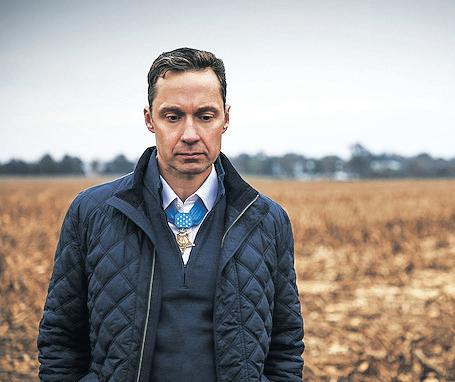
Late in 2019, the Trust released its first truly immersive video production, Civil War 1864: A Virtual Reality Experience, that swiftly became the most popular video the Trust has ever created. Last month, it was included as an official selection at the Pixii Festival, an international gathering showcasing immersive. The production also won a Silver Telly Award in the Virtual and Mixed Reality division of the 41st annual Telly Awards, the world’s largest honor in video and television content.

Separately, a Trust fundraising video featuring actor and historic preservationist Steve Zahn exploring an endangered part of Kentucky’s Perryville Battlefield, also earned a Silver Telly Award in the Promotional Video: Not for Profit category.
In conjunction with a special edition of its award-winning membership magazine, Hallowed Ground, that focused on the history of the Medal of Honor, the Trust released a suite of supporting video content to enrich the reader experience. On-site interviews were combined with archival images and historically
accurate reenactment footage to showcase the enduring ties that exist between the historic and modern military. Dubbed “Brothers in Valor,” this package has recently been named the Silver Medalist in the 55th annual Society of Publication Designers competition in the Video of the Year category, finishing just behind a film produced by The New Yorker to support its issue on human trafficking. The entire multimedia “Brothers in Valor” package also won a Grand Award in the APEX Awards for Publication Excellence.
Explore Battle History and Preservation History with Ox Hill (Chantilly) Battlefield Tour Guide
Any discussion of the modern battlefield preservation movement begins in the same place: Chantilly, Va. After watching development pressures spreading across Northern Virginia consume much of this battlefield, a group of historians formed the Association for the Preservation of Civil War Sites in 1987. The need for action was real, and that small group has now grown to become the American Battlefield

24 CWN September 2020
MOH recipient Britt Slabinski at the Slaughter Pen Farm. Ron Maxwell.
A scene from Civil War 1864: A Virtual Reality Experience. Wide Awake Films.
Trust Education Department members Kris White, Garry Adelman and Dan Davis present Gettysburg National Military Park Chief of Interpretation Chris Gwinn with the ceremonial deed for 35 acres at Barlow’s Knoll. American Battlefield Trust.
Trust, the nation’s top historic land preservation organization, having protected 52,000 acres in 24 states, at sites associated with the Revolutionary War, the War of 1812, and the Civil War. The Trust also leads the way in bringing digital technology to historic interpretation, recently launching its 21st mobile app to help visitors explore Fairfax County’s Ox Hill Battlefield Park.
The Ox Hill (Chantilly) Battlefield Tour Guide app helps users explore the fighting that took place on Sept. 1, 1862. More




than just telling the story of that battle, the app shares the controversies involved in the loss of 99 percent of the battlefield to development and how preservationists rallied to secure, save, and commemorate the 4.9 acres that remained.
“A digital product is the ideal way to tell the story of the Battle of Chantilly,” said Trust President Jim Lighthizer. “Technology lets you peel away the years and visualize what this landscape looked like when mighty armies clashed amid a late-summer

thunderstorm.”

This project was produced in partnership with the Bull Run Civil War Round Table (BRCWRT), one of the leading such organizations in the nation, and with the support of local historian and BRCWRT member Ed Wenzel, one of the initial activists who launched the modern battlefield preservation movement. Significant assistance was also provided by the Fairfax County Park Authority.
The Ox Hill Battlefield Tour Guide app includes 16 stops along Ox Hill Battlefield Park’s existing trail, adding multimedia depth to the static interpretation. An interactive tour map allows users to seamlessly navigate between stops, and brings the user to nearby off-park battlefield locations that were lost to development. The Trust’s renowned battle maps, completely updated for this app, reflect the multiple phases of the fighting and immerse the user in the battle. Annotated period photographs of the Park and surrounding area add layers of knowledge.
25 September 2020 CWN Digital Issues of CWN are available by subscription alone or with print plus CWN archives at CivilWarNews.com
All Hands on Deck! Support Our Mission to Bring You the Naval History “This is the magazine for all things Civil War Navy. From ‘Uncle Sam’s web-feet’ to the ‘grey jacket navy’ raised by Jeff Davis! It is all here thoroughly researched and illustrated by beautiful contemporary navy images.” Ron Field, military historian and author of over 45 books, including Bluejackets: Uniforms of the United States Navy in the Civil War Period, 1852-1865. 1 Year—4 Issues: $37.95 Subscribe Now at civilwarnavy.com Or send a check to: CSA Media, 808 Drayton St., Savannah, GA 31401 International subscriptions subject to postage surcharge. Sailors and Marines on the deck of the U.S. gunboat Mendota, 1864. National Archives (Identifier 524548). 48 E. Patrick St., Frederick, MD. 301-695-1864 / civilwarmed.org Divided by Conflict. United by Compassion.
A peek inside the new Ox Hill Battlefield Tour Guide app. American Battlefield Trust.
The Graphic War highlights prints and printmakers from the Civil War discussing their meaning and most importantly, the print maker or artist’s goals.


The long summer of 1863 was marked in the eastern theater by Meade’s inability to crush Lee after Gettysburg. All summer long and into the fall, the two armies punched and counter punched to no avail. In a major skirmish/ minor battle at Bristoe Station on October 14, Union General Gouverneur Warren surprised Confederate General A.P. Hill, decisively driving him from the field. Three weeks later, this time with Federal General John Sedgwick facing Confederate
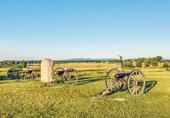


General Jubal Early, the Yankees roundly drubbed the Rebel force causing nearly 1,700 casualties at Rappahannock Station, November 7. The so-called Mine Run Campaign from November 27 to December 2, with many feints and useless movements, effectively ended in a draw with both armies going into winter camp without significant contact. In the meantime, substantial action occurred in the West. The last half of 1864 witnessed three major engagements between the two armies at Tullahoma, Tenn. (June 24-July 3); Chickamauga, Ga. (September 19-20); and Chattanooga, Tenn. (November 24). Both the Army of Tennessee and the Union forces had been
reinforced from the east: General James Longstreet from the Army of Northern Virginia and General Ambrose Burnside from the Army of the Potomac. The two reinforcements finally fought at Knoxville Nov. 29, 1863, and a small fort protecting the town became the center of interest. Longstreet chose to attack Fort Sanders, the main defensive position at Knoxville. Longstreet believed the fort was Knoxville’s, and therefore Burnside’s, weakest link. Confederate forces surrounded the town. Burnside reacted by fortifying the entire town and by Nov. 29, it had been under siege a week. Longstreet planned on a nighttime storming party assembled below the fort to assault its daunting slopes at dawn. During the night, in a freezing rain, nearly 3,000 Confederates in three brigades noisily assembled. Defenders inside the fort were thus alerted to the impending attack. Manning the fort were
some 250 to 500 men, depending on sources. One of the defenders was the 79th New York, “The Highlanders.”
The ensuing attack, coming at dawn, lasted only some twenty short minutes. Federal forces had stretched telegraph wire between tree stumps in an outer ditch. An inner ditch, twelve feet wide and ten feet deep in some places, featured a steep vertical wall up to the fort. Early intelligence noted that Federal troops were seen walking across the ditch, not knowing the Yankees were walking on planks. The attacking Confederates were easy targets for Federal soldiers firing from the ramparts. Attempts to scale the wall without ladders were futile. The attack quickly became an unmitigated disaster. The Highlanders suffered only nine casualties in a total Federal loss of 100. Confederate losses were substantial: 800 killed, wounded, or missing. Longstreet withdrew and eastern Tennessee remained in friendly northern hands.
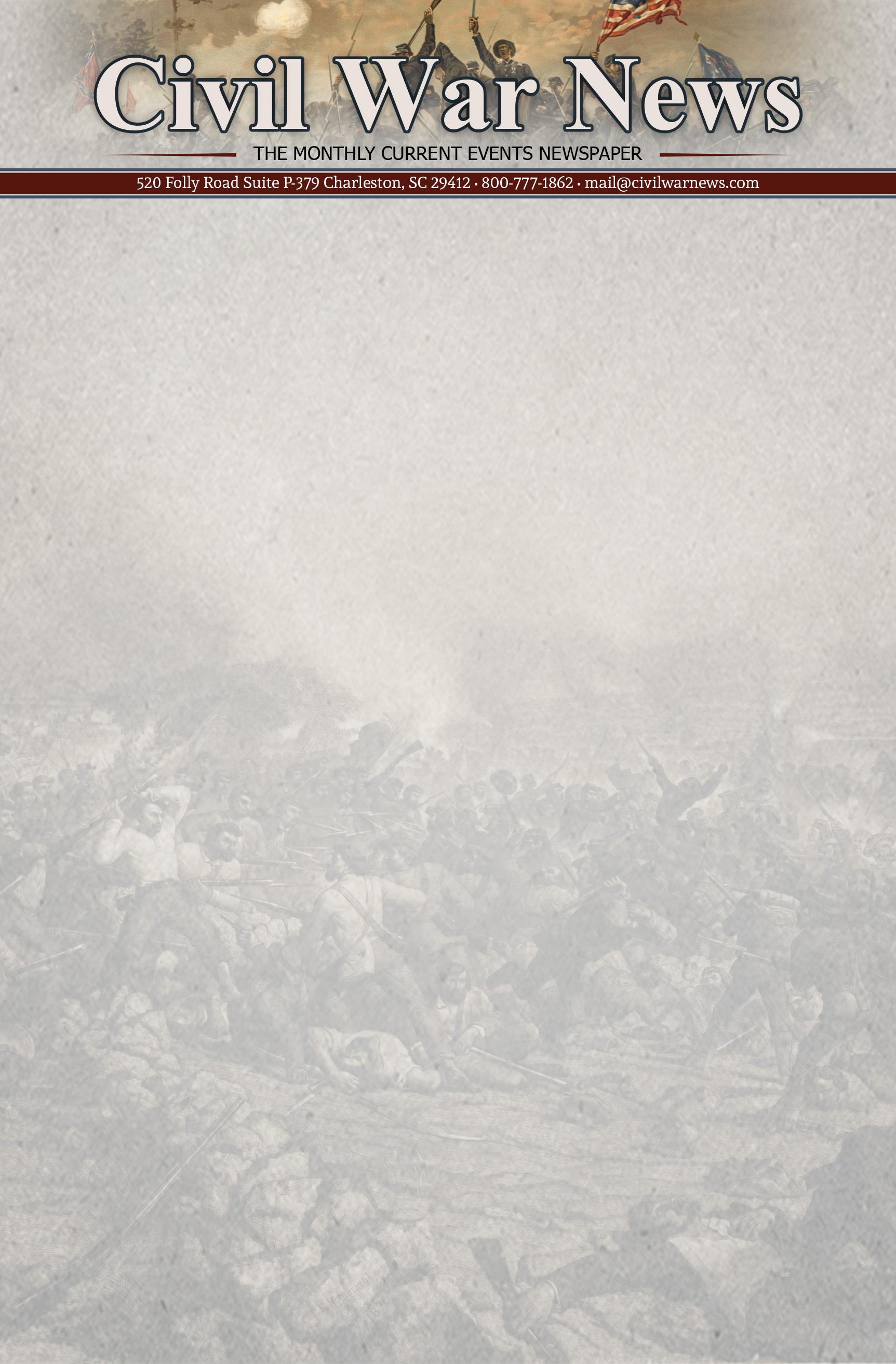
Years later, the Chicago lithographic firm of Kurz and Allison portrayed the ill-fated attack by Longstreet’s brigades. In its usual dramatic fashion, the artists pictured an orderly, organized assault, seemingly in bright sunlight, not at dawn. However, it realistically portrayed the tangled wires strung between tree stumps as the record showed. Also depicted are those Rebels who managed to scale the slippery wall where they engaged in hand to hand combat. Clouds of exploding shells document the presence of 12-pdr. cannon inside the fort.
More realistically portrayed is

a moving image of the Soldier’s Cemetery outside Knoxville. This lithograph shows the graves of the 79th N.Y. Volunteers, the “Highlanders” in the forefront. It is an excellent example of a lithograph as primary source. It was based on a “Sketch Taken by A Member of the Regiment March, 1864.” A member of the regiment stands in front of thirteen Highlander graves, each with a name and details of death, while an officer and family stand at the right. Upon closer examination, it is possible to identify a few graves from the attack on Fort Sanders. The regiment suffered four enlisted deaths and 16 wounded, all of whom recovered, during their tour in the fort.1

The Knoxville National Cemetery was founded by General Burnside after the siege. This large folio print shows the cemetery high on a hill framed by the surrounding hills and river. The artist, Hugh Young, was an officer in the 79th, who enlisted at age 31 to serve three years. He rose from private to Captain by war’s end.2 Less than a year later, Young deposited his print with the Library of Congress in October, 1864.
Endnotes:


1. The four dead were Sergeant Thomas Denham, Co. B; John Burgess, Co. K; David Schultz, Co. K; and Sergeant Robert Atherlly.




2. Frederick Phisterer, New York in the War of the Rebellion: 1861 to 1865. 3d. ed. 5 vols. Albany: J. B. Lyon Company, State Printers, 1912, IV, 2859. After 43 years in the museum field,

INSIDE EVERY ISSUE
26 CWN September 2020
Historical Publications, LLC Civil War News • 800-777-1862 520 Folly Road, Suite 25 PMB 379 Charleston, SC 29412 www.CIVILWARNEWS.com UP-TO-DATE COVERAGE • PRESERVATION NEWS • BOOK REVIEWS SHOWS, LIVING HISTORY AND REENACTMENTS • HISTORICAL ARTICLES MONTHLY COLUMNS • CALENDAR OF EVENTS STAY INFORMED! Only $38.50/One Year • $66.00/ Two Years THE MONTHLY CURRENT EVENTS NEWSPAPER -FORCIVIL WAR ENTHUSIASTS SINCE 1974 12 ISSUES PER YEAR PRINT & DIGITAL EDITIONS AVAILABLE CALL OR SUBSCRIBE ONLINE TODAY! 2018 CW N Vol. America’s Monthly Newspaper War Enthusiasts have 48,000 states! County, Friends Mountain Civil War Trust’s Path to Preservation CW N 44, 48 Pages, Civil War News America’s Monthly Newspaper War Enthusiasts Holzer Dancing Inside this Appraiser Bordonaro people death, cottagepeople these though, visitballroom this true, might departed1863. are, fact, ghoststhe you Gettysburgenjoy 1860’sorganizers JohnGettysburg, haveRemembrance features heldmeant slight additional accompanying Hotel Dancing the Night Away at the Gettysburg Hotel Poretsky as Lincoln Scholar Harold Holzer’s Oration at the 154th Anniversary of the Gettysburg Address GettysburgProclamation,liftingAmerican uniqueAfrican Douglass history,” colormonumentduring the and has some, believe bothDespite long recall now.groundstatuecrisis—now rememberBut nationsculptureLongstreet elevatedconsideredengaged reckoning long Today,countless Do when Lincoln
Fort Sanders
Graves of the Highlanders. Library of Congress.
Kurz & Allison Fort Sanders. Library of Congress.
Salvatore Cilella devotes his time collecting American prints and maps and writing. His last professional position was President and CEO of the Atlanta History Center. His most recent books are Upton’s Regulars: A History of the 121st

New York Volunteers in the Civil War (U. Press Kansas, 2009). His two-volume Correspondence of Major General Emory Upton, (U. of Tennessee Press, 2017), received the 2017–2018 American Civil War Museum’s Founders Award for









outstanding editing of primary source materials. His latest book “Till Death Do Us Part,” an edit of Upton’s letters to his wife 1868–70, was published in May by the Oklahoma University Press.

27 September 2020 CWN Deadlines for Advertising or Editorial Submissions is the 20th of each month. Email to ads@civilwarnews.com THE FINEST HISTORICAL ANTIQUE MILITARIA Wallace Markert info@csacquisitions.com 16905 Nash Road • Dewitt, Virginia 23840 804-536-6413 • 804-469-7362 www.csacquisitions.com
John
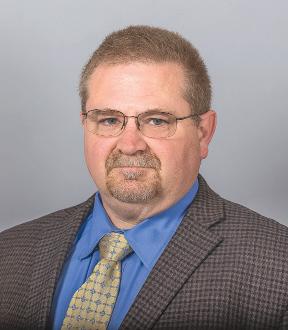
Walch’s 12-Shot Navy Revolver
In the March 2020 CWN, we looked at John Walch’s superimposed load, 10-shot pocket revolver; a gun that almost bankrupted Oliver Winchester and the New Haven Arms Company. This month, we will look at the Walch’s first revolver, his 12-shot “Navy” revolver.
On February 8, 1859, John Walch of New York City received U.S. Patent #22,905 for a somewhat unique revolver that fired superimposed loads from its cylinder, thus doubling the number of times the revolver could be fired before it was reloaded. Walch’s patent application, describing his Improvement in Revolving Firearms, read in part: “The nature of my said invention consists in constructing a revolving chamber with two
ranges of nipples connecting to the middle and rear part of the breeches, in combination with double hammers so fitted and acting that upon pulling the trigger the hammers fall, the one before the other, and explode caps on the aforesaid nipples that fire in succession charges contained in the forward and rear parts of each breech, so that two charges are fired out of one breech and the breech revolved each time the two hammers are cocked.”
As mid-19th century percussion revolvers were prone to chain fires, the simultaneous detonation of chambers other than the one intended as a result of pulling the trigger, it would seem that Walch’s double loaded chambers would raise a few eyebrows and cause concern among potential users. However, Walch explained
clearly in his patent application that there was nothing to fear, as his revolvers would also use a new type of projectile. He notes that this new type of bullet was “made either by attaching a tin plate to a half ball by means of a very thin piece, or by connecting two half-round balls by means of a very small piece, in such a manner as to have a recess all round. This recess is filled with a composition consisting of three-fourths part of soap and one-quarter of oil.” While the description may not really bring to mind what the inventor intended, the patent drawings that he references can best be described as miniature “bar shot,” essentially a lead ball cut in half and joined by a thin piece between the flat sides that resulted in an incredibly deep groove.
This groove also gave the projectile a more oval than round silhouette. The purpose of the groove was to contain the greaselike composition described, that would ooze out of the groove when the ball was compressed during loading and the space between the two halves suitably squeezed. This grease would then, in the words of the Walch, have the effect that “…every danger is likewise prevented by which the after-charge might be ignited when the forward charge is fired off….” Walch further notes that this rather slippery arrangement with the heavily greased balls would have the effect that “the chamber will be well greased and the barrel by each discharge will be there by cleaned.” He goes on to further state the advantages of the arrangement were that “as this forms a perfect air-tight packing for the ball the powder will have more force (and) be able to send the ball a greater distance.” It is interesting to note that while Walch appears to have, at least in his mind, removed the possibility of the rear charge igniting as a result of the front charge being fired, he does not address the possibility that the front charge might misfire, and when the rear charge was fired into the blocked


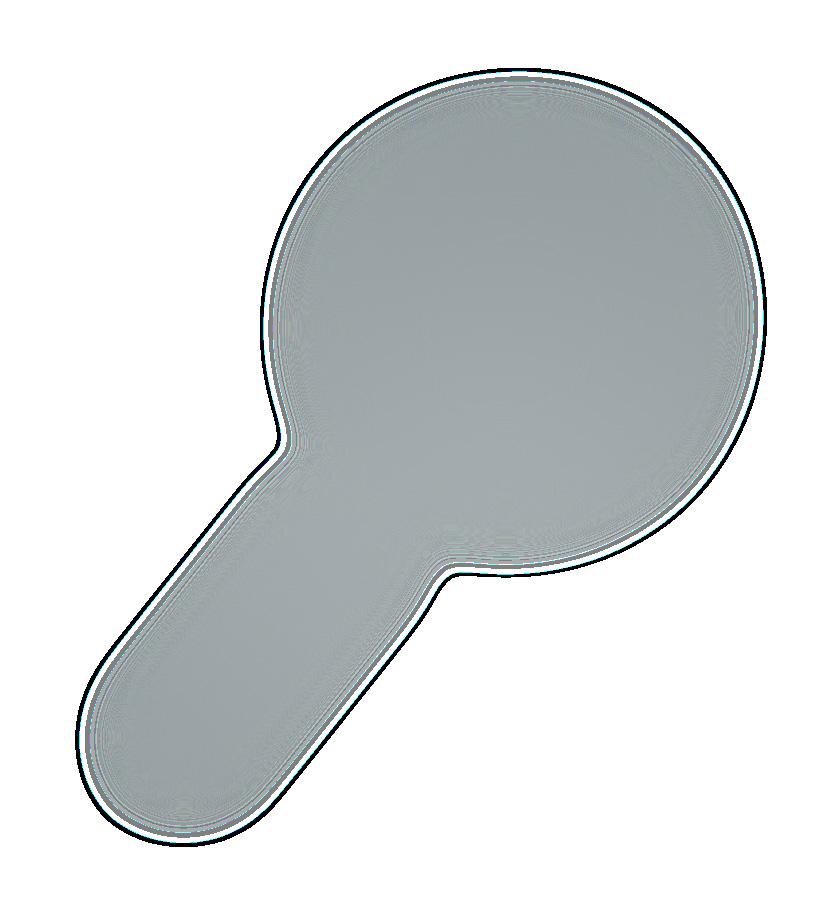

chamber, a catastrophic failure would almost certainly occur.

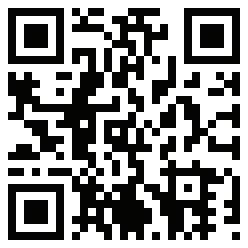
Walch knew that the notion of a superimposing two or more loads in a single chamber was not a new idea and did not claim that design in his patent. In fact, the U.S. military had experimented with the concept circa 1829 with the Ellis-Jennings repeating rifle, that was produced in both fourand ten-shot variants. Rather his claim ran specifically to the arrangement of two rows of nipples on the rear of revolving cylinder allowing double loads to be fired from each cylinder chamber. His other claim referred to his trigger, which as he notes, “is on its upper end made in two parts.” Thus, based upon his description, a single conventional trigger would be in the triggerguard. The trigger had two operating parts in the frame, allowing the release of the right, and then the left, hammer with two separate pulls. In Walch’s initial production revolvers, however, it was two individual triggers that were used.

John Parker Lindsay received a similar patent, #30,332 on October 9, 1860, that allowed a single trigger mechanism to release two or more hammers in sequence. This was a more elegant solution to the single trigger and double hammer firing mechanism. Eventually the two men would design a refined version of the Walch revolver together. The revolver conceived by these two New Yorkers would eventually be brought to Oliver Winchester and the New Haven Arms Company for manufacture; the Walch Pocket revolver almost prevented the Winchester Firearms Company from existing; but we are getting slightly ahead of our story.
Like many designers and patent holders during the 19th century, Walch had plenty of ideas but no manufacturing facilities. To that end he entered into an agreement with the Union Knife Company of Naugatuck, Conn., to manufacture the first of his double-load revolver designs, the Walch “Navy” Revolver. This was a .36 caliber, six-shot chambered revolver that was capable of firing twelve shots from the double loaded cylinder chambers. The revolver was roughly 12 ¼ inches overall length with a nominally 6 inch octagonal barrel and utilized two triggers rather than the convoluted single trigger with two upper sections, as shown and described in Walch’s patent application. Standard markings were the patent date information on the left side of the barrel and WALCH FIREARMS CO over NEW YORK in two lines on the top of the barrel.
The production of the Walch Navy revolver at the Union Knife Company was supervised by John Parker Lindsay, who would become famous (or infamous) for his Lindsay Model 1863 Rifle Musket that used a double loaded chamber incorporated into a U.S. Model 1863 pattern musket with double hammers and a single trigger. While Flayderman’s Guide To Antique American Arms suggests that Lindsay was already producing his “Young America” pistols based upon the single trigger, double-hammer, double-loaded concept at the Union Knife Company before Walch came to the company, it seems more likely that the former Springfield Armory employee was initially engaged to produce the Walch “Navy” contract revolvers at the Union Knife Company, more than a year and half prior to starting to produce his own “Young America” pattern pistols at the same facility. The Walch patent pre-dates Lindsay’s by some nineteen months, so it seems likely that Walch was already promoting his firearms prior to meeting Lindsay. In fact, the pocket version of the Lindsay “Young America” pistol bears the February 8, 1859, patent date of Walch’s bifurcated bullet design, along with the October 9, 1860, date of Lindsay’s design under its barrel.
Despite producing a small number of the .36 caliber Walch Navy revolvers at Union Knife Company circa 1860, they met with little commercial success. While exact production figures are not known, most references suggest that between 200 and 300 of the 12-Shot Walch Navy revolvers were produced. Most of these guns were blued with smooth walnut grips, but a small number were lightly engraved and featured checkered grips. It would not be unreasonable to think that some pistols might have had higher grade finishes as well, possibly silver or tin plating or even early nickel plating, then being experimented with by some New York retailers circa 1860. During the same basic period, Lindsay produced nearly double the number, possibly as many as 400-500, of his “Young America” pocket pistols and approximately 100 of his larger sized belt model pistols; both of which also appear to have been commercial failures. By early 1861, the Union Knife Company seems to have separated themselves from both Walch and Lindsay and returned to producing the knives that were the heart and soul of their business, rather than speculating in the production of odd ball handguns. However, Walch was not
28 CWN September 2020 www.CollegeHillArsenal.com Tim Prince College Hill Arsenal PO Box 178204 Nashville, TN 37217 615-972-2418
deterred. He proceeded to design a new pocket version of the revolver in collaboration with Lindsay. It was this gun, as produced by Oliver Winchester’s New Haven Arms Company, that we discussed a few months ago.
Today the Walch Navy revolver remains one of the “Holy Grails” of U.S. percussion revolvers on the collector market. Surviving examples are very scarce and are often the centerpiece of an advanced collection of “large frame” or “military sized” American percussion revolvers from the Civil War era. In fact, despite the lack of evidence that any of these guns were ever acquired for military use, they are considered a “Secondary Martial Revolver” due to their size and caliber. These scarce guns rarely appear on the market and are always coveted additions to advanced collections.


The example pictured here is one of the very scarce factory engraved examples with checkered wood grips. While the gun retains no finish to speak of, there are some traces in protected areas that suggest the gun was originally plated during the period, possibly in silver, but more likely in tin or nickel. This example was formerly part of a major firearms museum collection, but now resides in a private collection.

Tim Prince is a full-time dealer in fine & collectible military arms from the Colonial Period through WWII. He operates College Hill Arsenal, a web-based antique arms retail site. A long time collector & researcher, Tim has been a contributing author to two major book projects about Civil War era arms including The English Connection and a new book on southern retailer marked and Confederate used shotguns. Tim is also a featured Arms & Militaria appraiser on the PBS Series Antiques Roadshow.
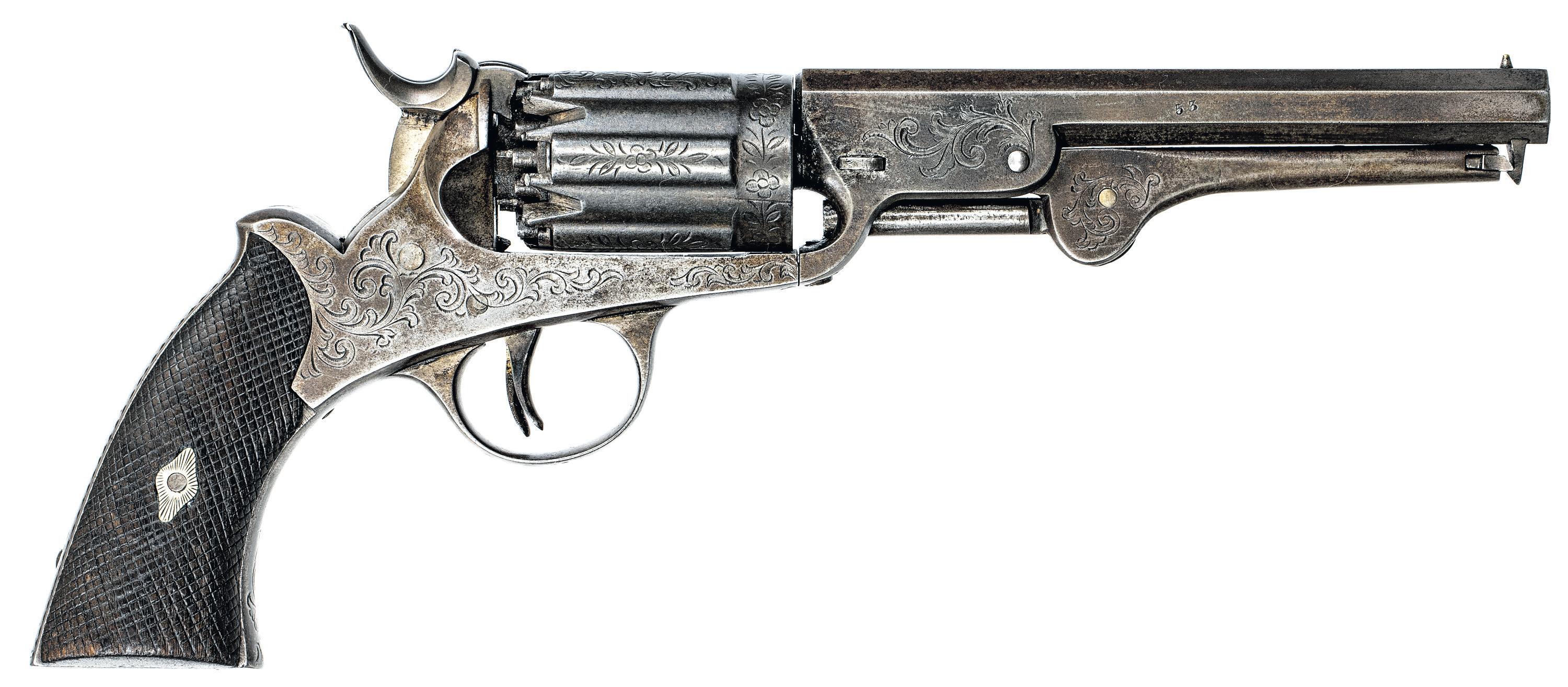
29 September 2020 CWN Digital Issues of CWN are available by subscription alone or with print plus CWN archives from 2012 at CivilWarNews.com
Obverse overall view of Walch Navy Revolver #53. This is one of the rarer factory engraved examples with checkered grips. All photos by Tim Prince.
Overall reverse view of Walch Revolver #53, inset shows the patent date information that is roll marked on the left side of the barrel, referring to Walch’s February 8, 1859, patent #22,905.
Top view of Walch Navy revolver #53, showing the double hammer arrangement and double rows of percussion nipples. Inset shows the detail of the barrel markings.
Detail oblique view of the Walch cylinder’s rear, showing the double rows of nipples, double hammers, and the raised flash channels that communicated the ignition flame to the forward charge in the cylinder.
Stunning Identified CS Regulation Artillery Frock Coat


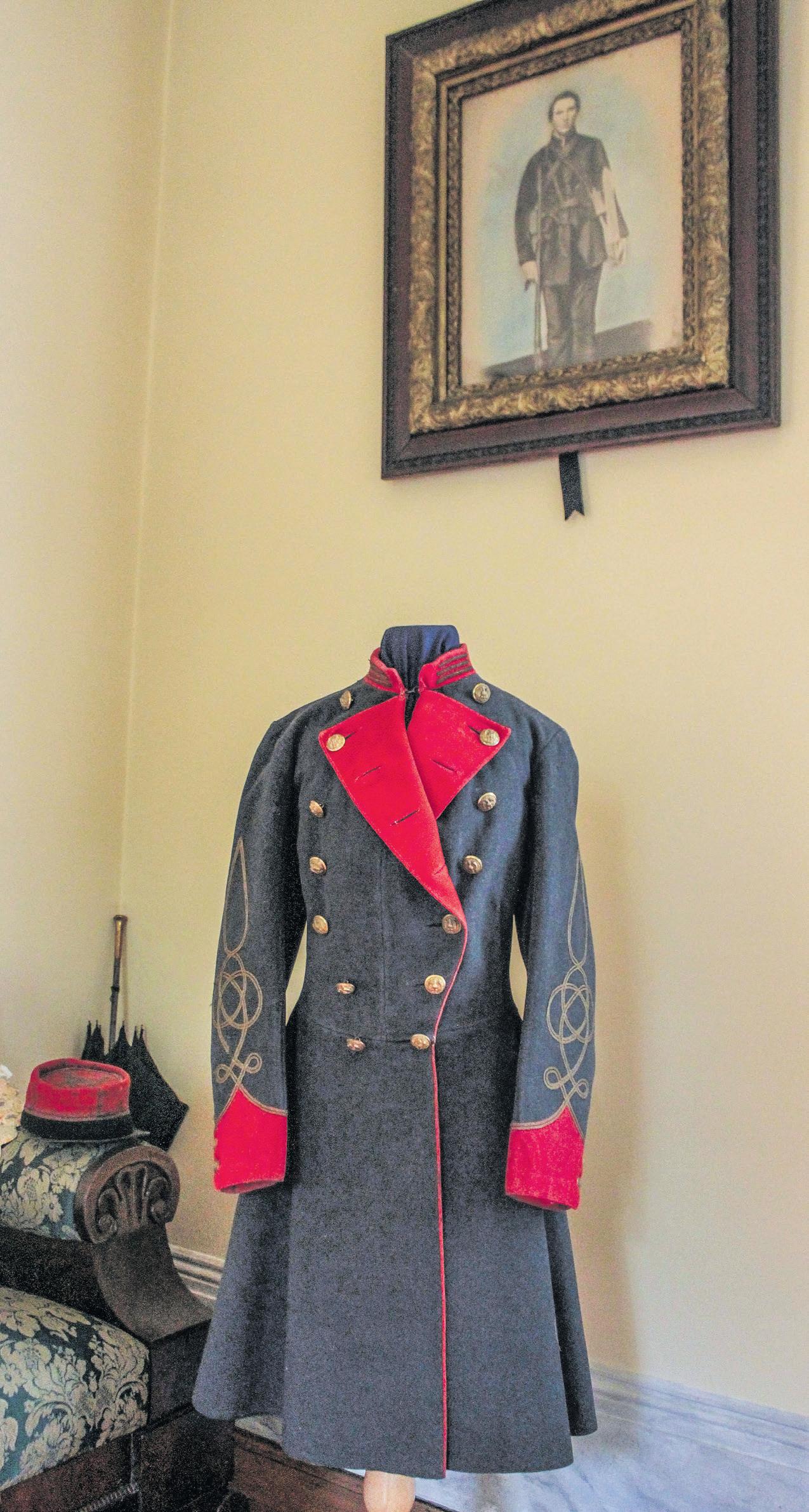
 by Shannon Pritchard
by Shannon Pritchard
Stunning seems an understatement. This is without a doubt the most colorful Confederate regulation uniform that I have ever seen in over thirty years of collecting.
The coat is finely tailored of the best English wool, and faced with fiery red broadcloth. What makes this artillery captain’s frock stand apart from all others is the breast lining of the same red broadcloth,
so that when the breast was buttoned back with its gorgeous Confederate staff officer buttons, the officer was oozing with red blooded Southern patriotism.
The coat’s cadet grey wool exterior is in near new condition. The green satinet liner shows extensive wear but remains in good condition. The broadcloth service branch facings show extensive wear but are otherwise in excellent condition. All eighteen “EXTRA RICH TREBLE GILT” stamped coat buttons are original to the coat. The six CS staff officer cuff buttons are original and carry the same “EXTRA RICH TREBLE GILT” backmark.

“Property of Chas. I Dial” is inked on the inside of one sleeve. The style of writing is post War, so he was not the coat’s owner, but Charles Inglesby Dial was the son of Mary Inglesby Dial, and grandson of Captain Charles Inglesby, 1st South Carolina Artillery.
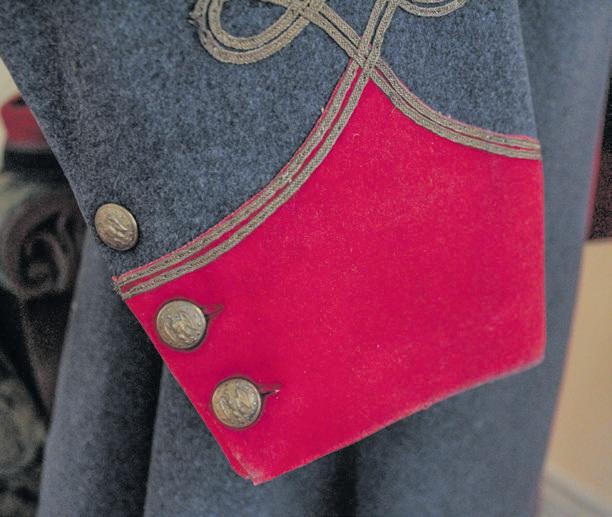
Charles Inglesby entered Confederate Service as a 2nd Lieutenant, Company B, 1st Battalion South Carolina Artillery. He was promoted to 1st Lieutenant in Company E by January 1862. On March 24, of the same year, the battalion officially became the 1st South Carolina Artillery. Inglesby had been signing documents as commanding officer of the company for nearly a year and a half when he was finally officially promoted to Captain, Company I, on July 20, 1864. He was paroled at Greensboro, N.C., on May 1, 1865.
The regiment was assigned to the Department of South Carolina, Georgia, and Florida. It fought in the June 16, 1862, battle of Secessionville, or the First Battle of James Island, a Confederate victory. Afterwards the 1st South Carolina Artillery
served in the defenses around Charleston in their various engagements. During operations on Morris Island, July 10 to September 6, 1863, the battalion suffered 18 killed, 50 wounded, and 52 missing. In February 1865, the unit was converted to
The Captain’s cuffs are adorned with EXTRA RICH TREBLE GILT Confederate staff officer’s buttons, two of which fasten the working cuff, the third is merely for decoration.
30 CWN September 2020
The family tree that led to the discovery of the coat’s original owner. Ancestry.com.
Captain Charles Inglesby’s frock coat is shown below the author’s great uncle, killed in action during Pickett’s Charge. All photos courtesy OldSouthAntiques.com.
Stunning, even from the rear!
The tail pockets are piped in the same flaming red, and flanked by four staff officer’s buttons.
an infantry regiment and was assigned to Colonel A. Rhett’s Brigade. The regiment soon became part of the forces involved in the North Carolina Campaign. Only a remnant surrendered with the Army of Tennessee.
The author thanks Dom Serrano for the research that led to the identification of the coat’s original owner.


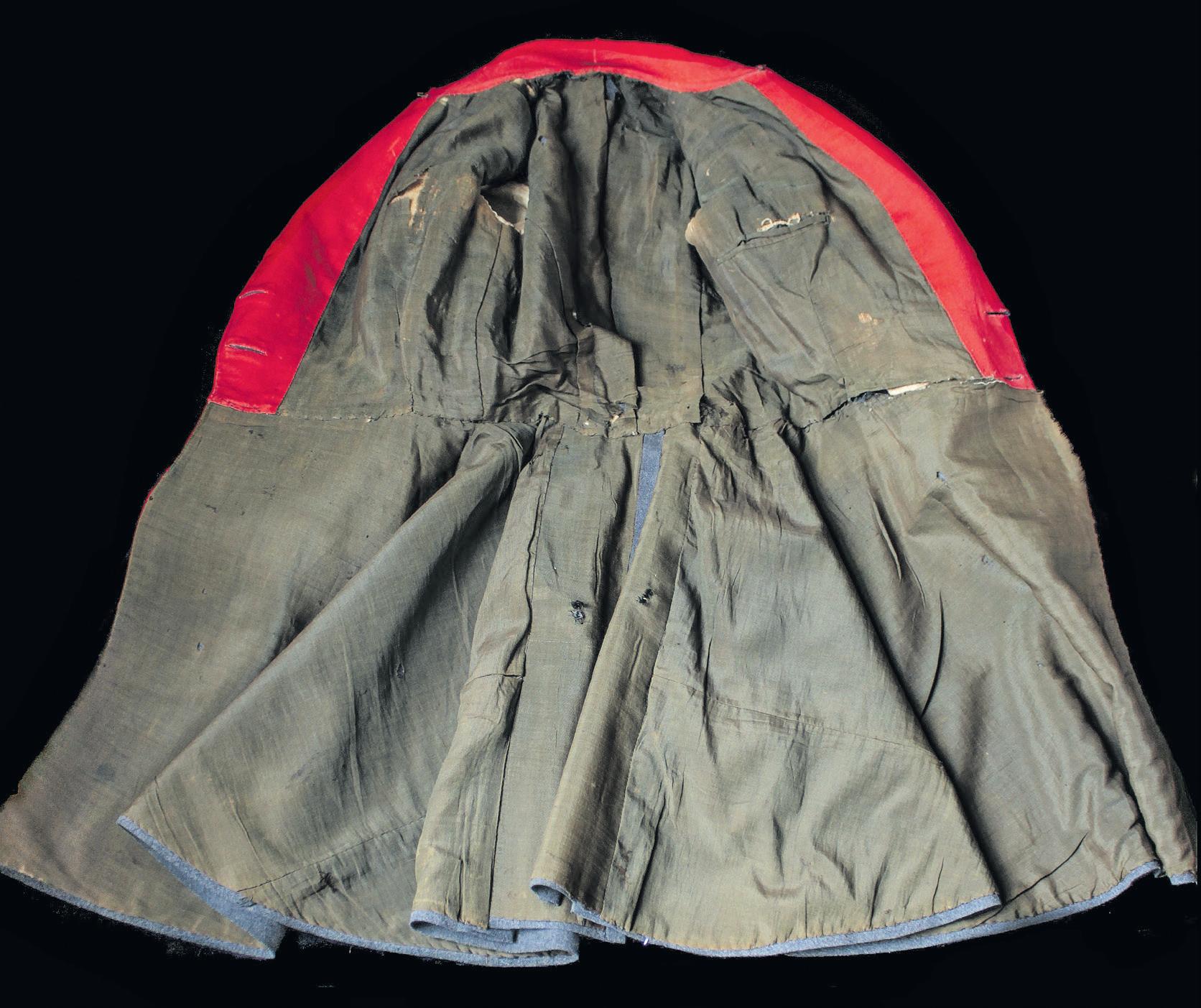
Shannon Pritchard has authored numerous articles relating to the authentication, care and conservation of Confederate antiques, including several cover articles and is the author of the definitive work on Confederate collectibles, the widely acclaimed Collecting the Confederacy, Artifacts and Antiques from the War Between the States, and is co-author of Confederate Faces in Color.
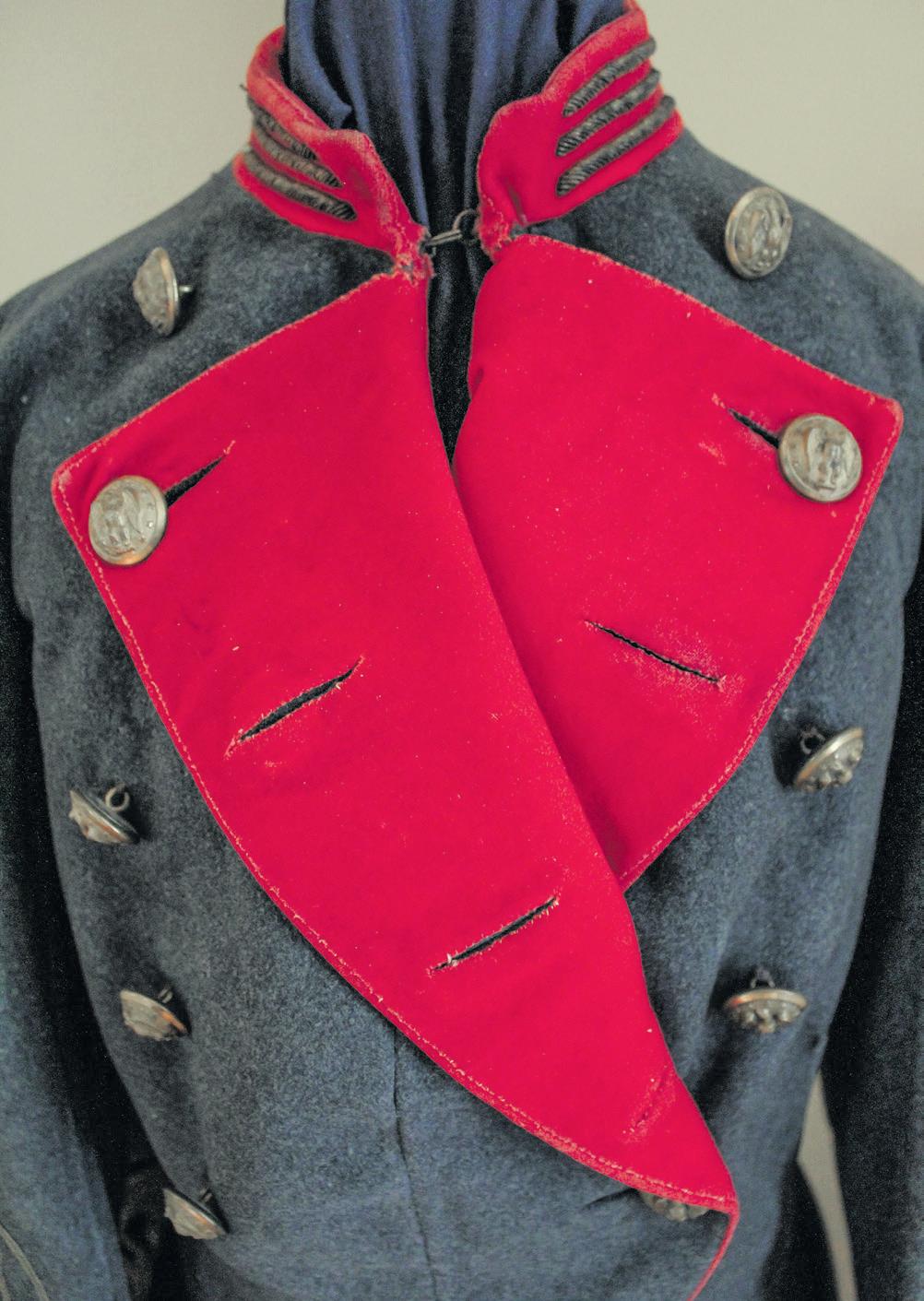
31 September 2020 CWN Digital Issues of CWN are available by subscription alone or with print plus CWN archives at CivilWarNews.com Want To Advertise In Civil War News? Email us at ads@ civilwarnews.com or Call 800-777-1862. For a rate sheet visit: www.civilwarnews.com
Right: Note the green satinet liner shows extensive wear, but remains in remarkably good condition.
Left: With the breasts pinned back, the Captain showed a flaming front.
Right and left sides showing the galloons’ running two thirds of the way to the shoulder and coming to a sharp point.
whole of Anderson’s brigade, mine, Colquitt’s, and any troops that had arrived on Anderson’s right. My whole force at this moment did not amount to over 700 men….”
Rodes noticed that troops, one regiment and part of another, that were “going to the support of Anderson…instead of passing to the front, stopped in a hollow immediately in my rear….”
Perspectives on Sharpsburg, Phase Two
Stern necessity bade us be satisfied with simply holding our ground. – Col.
Risden Bennett
At the end of last month’s column we left the Confederates at the north end of the “ensanguined field of Sharpsburg,” as the fighting in the early phase of the battle petered out. We move to the center, where more American blood soaked the land. We now listen to the words of several Confederate officers leading the men who traded blows with their Federal enemies along the famous Sunken Road.
The division commanded by Maj. Gen. Daniel Harvey Hill had shifted early in the day to support units fighting desperately on the Confederate left. Hill’s troops were pushed back with heavy losses. He reported that “efforts were made to rally them, in the bed of an old road…which had been their position previous to the advance.” One of his brigades, Hill stated, got back to the road but took little part in the fighting there: its leadership had been annihilated, with four of its 10 field officers dead, five badly wounded, and the tenth stunned by a shell.
Another brigade, commanded by Col. Duncan McRae, “advanced with alacrity” from the road to meet the enemy. The men “secured a good position and were fighting bravely when a panicky North Carolina captain cried out ‘They are flanking us.’” Hill wrote that with this cry “in a moment they broke and fell to the rear.” Hill’s candid report further stated that “We had now lost all the ground wrested from the enemy, and were occupying the position held in the morning. But three of my brigades had been broken and much demoralized. [The brigades of Brig. Gen. Robert] Rodes and [Col. George B.] Anderson were in the old road, and some stragglers had been gathered up and placed upon their left.”
Hill sent “several urgent messages to General Lee” to alert the commander that the Federals were about to strike these depleted brigades. No help arrived before “a heavy force advanced in three parallel lines, with all the precision of a parade day,” but, even worn down as they were, Rodes’s and Anderson’s men poured “a galling fire” into the ranks of the attackers. The Federals “recoiled, and fell back; again advanced, and again fell back, and finally lay down behind
GEORGIA’S CONFEDERATE MONUMENTS

In Honor of a Fallen Nation
Gould B. Hagler, Jr.
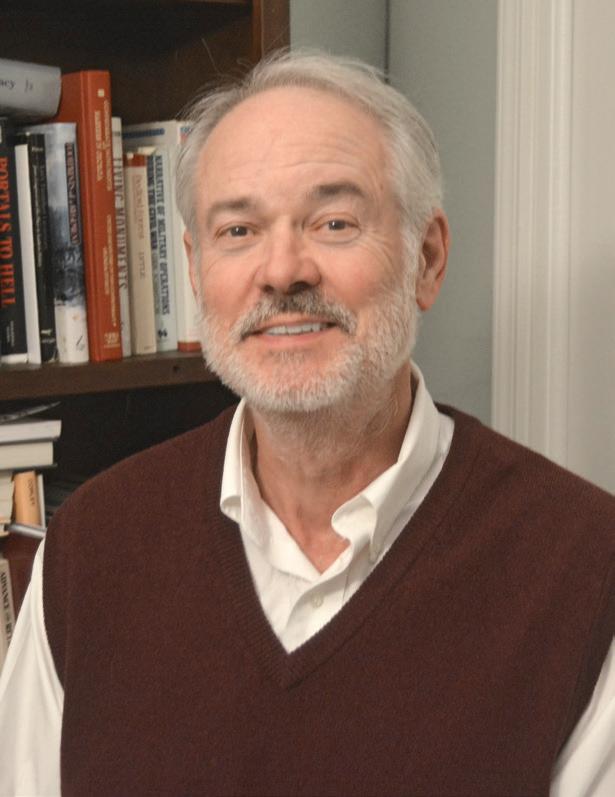
This unique work contains a complete photographic record of Georgia’s memorials to the Confederacy, a full transcription of the words engraved upon them, and carefully-researched information about the monuments and the organizations which built them. These works of art and their eloquent inscriptions express a nation’s profound grief, praise the soldiers’ bravery and patriotism, and pay homage to the cause for which they fought.
www.mupress.org
866-895-1472 toll-free
of following these instructions
Lightfoot “moved briskly to the rear of the regiment and gave the command, ‘Sixth Alabama, about face, forward march.’ Major Hobson, of the Fifth, seeing this, asked him if the order was intended for the entire brigade; he replied ‘Yes,’ and thereupon the Fifth, and immediately the troops on their left, retreated.”
the crest of the hill and kept up an irregular fire.”
Hill was soon reinforced by the division of Maj. Gen. Richard H. Anderson, whose 3,000 to 4,000 men brought sufficient weight to the Confederate side, or so it seemed, when the order to charge was given.
General Rodes reported that “The charge failed, mainly because the Sixth Alabama Regiment, not hearing the command, did not move with the others, and because Colquitt’s brigade did not advance far enough. That part of the brigade which did move forward found themselves in an exposed position, and, being outnumbered, fell back before I could get…the Sixth Alabama to move. Hastening back to the left, I arrived just in time to prevent the men from falling back to the rear of the road…. It became evident to me that an attack by us must, to be successful, be made by the
Rodes learned that these troops belonged to Pryor’s brigade and was told by their officers that “they had been ordered to halt there, by somebody, not General Pryor. Finding General Pryor in a few moments, and informing him of their conduct, he immediately ordered them forward.”
Rodes’s account is matter-of-fact, but the reader gets the impression of a certain level of disgust at the “conduct” of these unnamed officers and their men, holed up in a hollow, with a battle swirling around them, sheltering there because “somebody,” not their commander, had ordered them to do so.
Having handled this situation, Rodes returned to get an urgent message from the officer in command of the Sixth Alabama, Lt. Col. James Lightfoot, who had taken over from the seriously wounded Col. John B. Gordon.
Lightfoot said his regiment’s right “was being subjected to a terrible enfilading fire…and…had but few men left in that wing….”
Rodes told the colonel to “throw his right wing back out of the old road….” However, instead
Rodes did not immediately see this “retrograde movement” because he stopped to help a wounded officer and was himself then downed by a wound that he first thought to be serious. By the time he realized what had happened it was too late to prevent the retreat. “I hastened to intercept it at the Hagerstown road. I found, though, that, with the exception of a few… men…, not more than 40 in all, the brigade had completely disappeared from this part of the battlefield.”
So, we have Rodes finding men sitting in a hollow because “somebody” told them to halt there. He corrects this problem. Then he orders Lightfoot to make an adjustment to his line. Lightfoot instead orders his entire regiment to retreat, and informs another regimental commander that the whole brigade is to do so. Rodes, slowed by a wound, is unable to stop his brigade—except for 40 souls—from melting away.
Leadership of Colonel Anderson’s Brigade ultimately devolved to Col. Risden Bennett after its commander and other senior officers were disabled or killed. In his report for the

32 CWN September 2020
Old Comrades from the 14th North Carolina. Col. Bennett seated second from right. Library of Congress.
A Photographic Legacy of America’s Bloodies

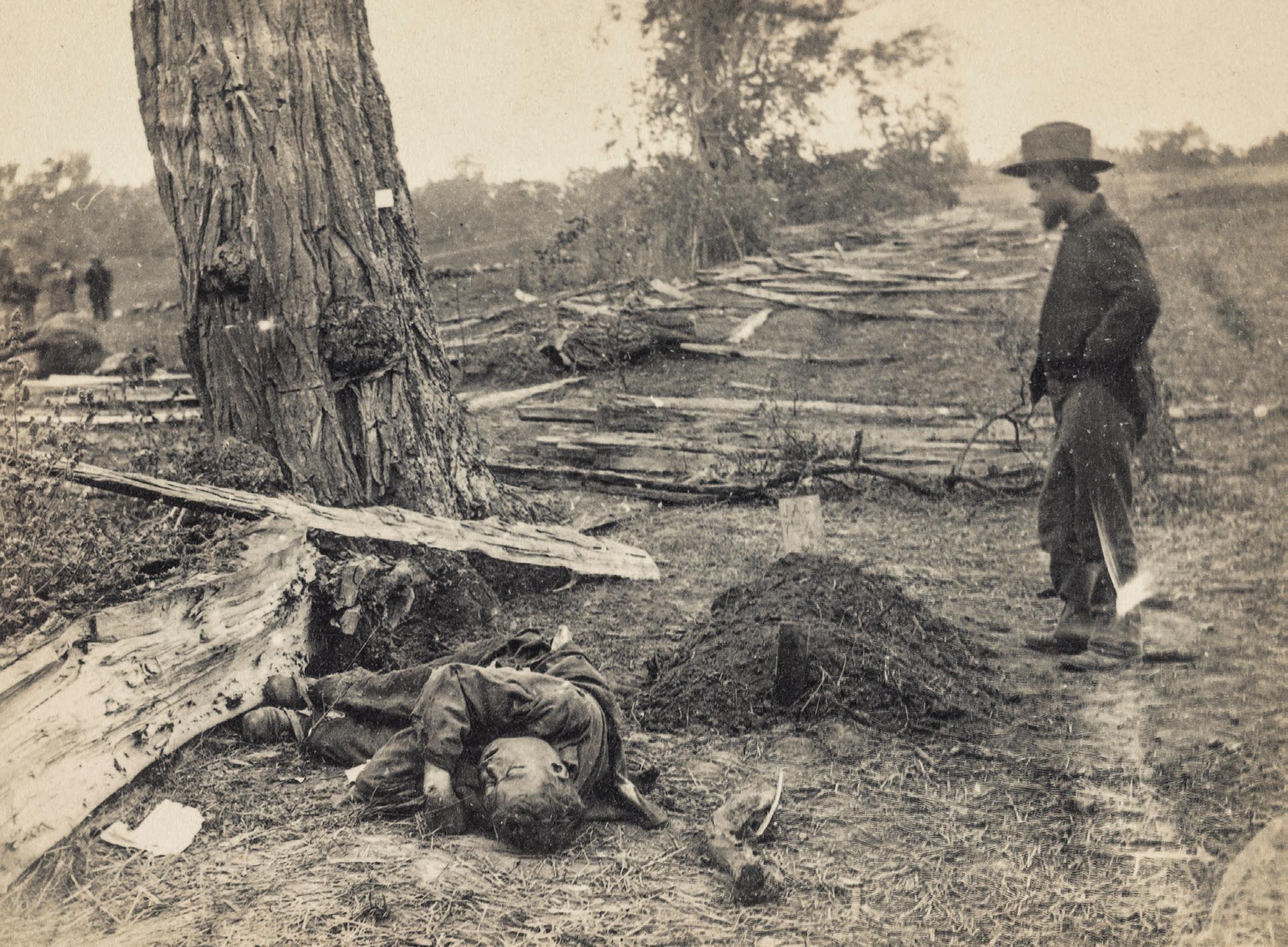
brigade, Bennett wrote that Hill himself led the unit to its position in the Sunken Road. Soon the enemy “came into the field in front of us….” Bennett’s report describes the Federal assault. “Their advance was beautiful in the extreme, and great regularity marked their column.” The Yankees closed to within 50 yards, but “a well-directed fire sent them in disorder some 50 paces rearward.” The attackers charged again, “with same result as aforesaid, with the addendum of wild confusion.”
Bennett continued: “The bravery of a field officer apparently checked the spreading symptoms

of panic, and once more their courage was brought to the test. Poor return, indeed, they made for the gallantry of their leader. Confusion that seemed remediless followed.”


With the assault on their line faltering, Bennett wrote, “the colonel commanding [i.e., George Anderson] gave orders for bayonets to be fixed, preparatory to an advance of the line. However, two fresh columns of the enemy were seen double-quicking to the relief of the shattered ranks of the foe, and stern necessity bade us be satisfied with simply holding our ground.”
As we have seen, the division of


of his brigade were swept up in “the stampede, if we may so term it.”
“The hour of 1 p.m. had arrived. [Richard] Anderson’s division had gone to the rear. Two regiments…of our own brigade were missing. The dark lines of the enemy had swept around our right, and were gradually closing upon Rodes’ brigade.” Bennett’s assessment was that “to contend against front and rear attacks we were totally inadequate, and the bare alternative of retreat was presented. The command was ordered to make the retreat….”
Bennett concluded his report by saying that “About sunset the colonel commanding was taken from the field, disabled.” The brigade suffered 302 casualties, with 57 killed and 245 wounded. However, Bennett reported that “The command was reformed at the road leading to Sharpsburg, and participated in all the skirmishes of the afternoon.”
The Confederates had been forced back but there was no Federal breakthrough. Heavy fighting in the center ended in the early afternoon. The next threat came from the south end of the line. Federals had crossed the creek in force; the Confederate right had been largely denuded of troops, as the morning and midday crises required Lee to shift men to his left. Where were the
men to be found to stop this final Federal push? Would the Army of Northern Virginia be saved, or would it be cut off from the Potomac crossing and trapped in Maryland? Next month we will read about one of the war’s most famous episodes, the arrival of the division of Maj. Gen. A.P. Hill.

Sources:
The reports of the officers quoted are in O.R., Ser. 1, Vol. 29, Part 1.
Maps of the Sharpsburg battlefield can easily be found online. The American Battlefield Trust shows excellent maps at its site, www.battlefields.org.
Gould Hagler is a retired lobbyist living in Dunwoody, Ga. He is a past president of the Atlanta Civil War Round Table and the author of Georgia’s Confederate Monuments: In Honor of a Fallen Nation, published by Mercer University Press in 2014. Hagler speaks frequently on this topic and others related to different aspects of the Civil War and has been a regular contributor to CWN since 2016. He can be reached at gould.hagler@gmail.com.
Maj. Gen. Richard Anderson had sent reinforcements to stiffen the position in the Sunken Road and enable the Confederates to counterattack. Bennett’s report contains a very negative assessment of these troops’ performance. His brigade was warned to keep a lookout on the extreme right. “While directing ourselves to that point, masses of Confederate troops in great confusion were seen…, the Sixteenth Mississippi and Second Florida [of Richard Anderson’s division], coming to our succor, broke beyond the power of rallying after five minutes’ stay.” The panic spread, Bennett wrote, as two regiments

33 September 2020 CWN Subscribe online at CivilWarNews.com
Near the West Woods, unburied Confederate lying beside the battlefield grave of Lt. John A. Clark of the 7th Michigan Infantry, both KIA on America’s bloodiest day. Photograph taken by Alexander Gardner on Sept. 19. Information on the photo taken from William A. Frassanito’s Antietam:
t. Library of Congress.
View of ditch, which had been used as a rifle-pit. Library of Congress.
From
the Editor
My car’s thermometer reads 76 degrees when I set off into the woods. The Chancellorsville History Trail leaves the parking lot across from the visitor center and loops 3.2 miles through the forest north of modern Route 3. In this area, Confederate attacks and Federal counterattacks seesawed through the woods on May 3, 1863.
In the thick of the fight and without orders, Brig. Gen. Joseph Revere, grandson of the Revolutionary War hero, pulled his men out of line through here and marched them to the rear to reform. I pass an aluminum sign that tells the story, one of several such signs posted along the path. The ground rolls with small hills, crisscrossed by dry streambeds that, in the spring, flowed with shallow trickles of water. When the path descends toward the low ground, the foliage thickens; along the high ground, the groundcover thins out. In places, ample sunlight pours down into what was once described as “the
dark, close wood” of the Virginia Wilderness.
I’ve been exercising along the trail since mid-June, circling the loop twice each day, doing an on-off speed-walk/run combo that keeps my heartrate within a specific range. The heat has been especially oppressive this third week of July and my car thermometer will read “92” by the time I get back. Fortunately, the trail is beautiful, which helps distract me from the labor of the workout. It’s all a matter of mental toughness, even if the heat compounds the physical fatigue.
It’s been a hot summer all the way around. In fact, out here in the woods, away from the news, the internet, the protests, and the pandemic, it’s almost cool. I might offer that as a prescription to everyone: talk a walk in the woods, slow or fast. Get away from things. Cool off.
I often see deer, and last week I surprised a small skunk hardly bigger than a kitten. Once or twice a week, there’s a box turtle. I sometimes think they’re moving at the exact right speed, with the exact right deliberateness.
— Chris Mackowski, Ph.D. Editor-in-Chief
The Seventh Annual Emerging Civil War Symposium at Stevenson Ridge

Well, we ended up having to postpone this year’s symposium, bumping everything back. Our theme, Gordon Rhea’s keynote address, Greg Mertz’s tour, and all our speakers, to next year. Darn COVID-19! Mark your calendars for August 6-9, 2021. If
you had a ticket and haven’t yet indicated your refund preference, you can find out more information here: https://emergingcivilwar.com/2020/07/06/2020-symposium-postponed.
On the bright side, as a way to say thank you to our ticket-holders, we’re going to do a virtual symposium in August. We’ll record a series of presentations on Saturday, August 8, and make them available on YouTube later in the month, first as exclusive content to our ticket-holders, and, later, to our general audience. C-SPAN is also coming to record the programs, so you’ll see them there later this fall.
ECW News & Notes
Sarah Kay Bierle made a social-distanced trip to New Market, Va., in July. It was great to be back in the Shenandoah Valley for a warm day of hiking on the battlefield.

Sean Michael Chick has done a series of discussions about the Civil War, U.S. Presidents, and Napoleon’s commanders on the youtube channel Thersites the Historian: https:// www.youtube.com/channel/ UClHybiqQOzR8kUpg5BbnjdQ
Bert Dunkerly wanted to take a moment to call attention to some people who have been a big help to him recently. Gordy Morgan has finished editing Bert’s ERW book about New Jersey in the Revolution. Gordy is a great editor and ERW is fortunate to have his help. Edward Alexander is producing some maps for me and I’m amazed at his attention to detail.
Jon-Erik Gilot and Kevin Pawlak finished the manuscript for their John Brown’s Raid book for the ECWS. Look for it on bookstore shelves in the coming year.
Chris Kolakowski, in his new position at the Wisconsin Veterans Museum, recently participated in a panel discussion that examined the role of Wisconsin soldiers at the Battle of Gettysburg. Chris was joined by the museum’s curator of history, Kevin Hampton. https://www.facebook.com/

WisconsinVeteransMuseum.
Chris Mackowski reviewed Adam Petty’s The Battle of the Wilderness in Myth and Memory: Reconsidering Virginia’s Most Notorious Civil War Battlefield for LSU’s Civil War Book Review: https://digitalcommons. lsu.edu/cwbr/vol22/iss2/9.
Derek Maxfield has an event in West Sparta, N.Y., at 2 p.m. Aug. 9, to promote his new ECWS book, Hellmira.
Ryan Quint is returning to the Fredericksburg & Spotsylvania National Military Park, with August 2 being his first day back. Ryan started there years ago as an intern. “I am very much looking forward to returning to my roots as a Civil War historian,” he says.
10 Questions...with Phill Greenwalt

Phill Greenwalt is one of ECW’s longest-serving contributors. He’s also co-founder of Emerging Revolutionary War and the Emerging Revolutionary War Series. We first profiled him in the November 2017 newsletter (http://conta.cc/2zau8iL). You can read his full ECW bio here: https://emergingcivilwar. com/author-biographies/editors/ phill-greenwalt.
You’ve been helping to steer the ship over at our sister site, Emerging Revolutionary War, these days. How’s life in the 18th Century?
is going strong, though, and we thank our readership and followers for that. With the limits placed on travel, and with historic sites, parks, and hallowed ground all facing challenges, the historians at Emerging Revolutionary War came up with the idea of a Zoom history happy hour-type program for Sunday evenings. When we’re able to jaunt out to a battlefield or attend a conference, we always congregate afterwards at a restaurant, bar, or brewery, have a drink and discuss history. So, we figured we’d make the best of the situation and do it virtually! The idea took off in mid-April and is still going strong on Sunday evenings, so join us at 7 p.m. on our Facebook page.
Otherwise, the historians continue to crank out content, work on future publications, and, speaking personally here, trying to knock out books on that ever growing “to-read” list!
Do you have any Civil War projects in the works at the moment?
I currently completed an essay for an Engaging Civil War Series future publication and am jointly working on a publication about Floridians at Gettysburg that has a historical memory aspect, too. With some archives being closed, that project is taking longer than expected, but I’m cranking away at it and excited to see how it is coming along. Also, I’m working on a few essays for various historical organizations/initiatives. And maybe a future Emerging Civil War Series publication, too—who knows?
What else are you working on?
The 18th century is still there. Emerging Revolutionary War
I’m brainstorming and setting the foundation for the next volume I’ll write in the Emerging Revolutionary War Series. I cannot give the details away yet and, besides, it is a few years from seeing the light of day. There are other great books in that series just published, about to be published (including one of mine on Valley Forge), and a few in various stages of production. Check Savas Beatie and Emerging Revolutionary War to stay up-to-date.
Being in Florida, you’ve had the chance to explore the state’s often-overlooked Civil War history. Why don’t you think the state gets more credit for that history?
I think the main reason is location/geography. Florida was still relatively uninhabited at the time, with less than 300 people living in South Florida and large swaths of the state still
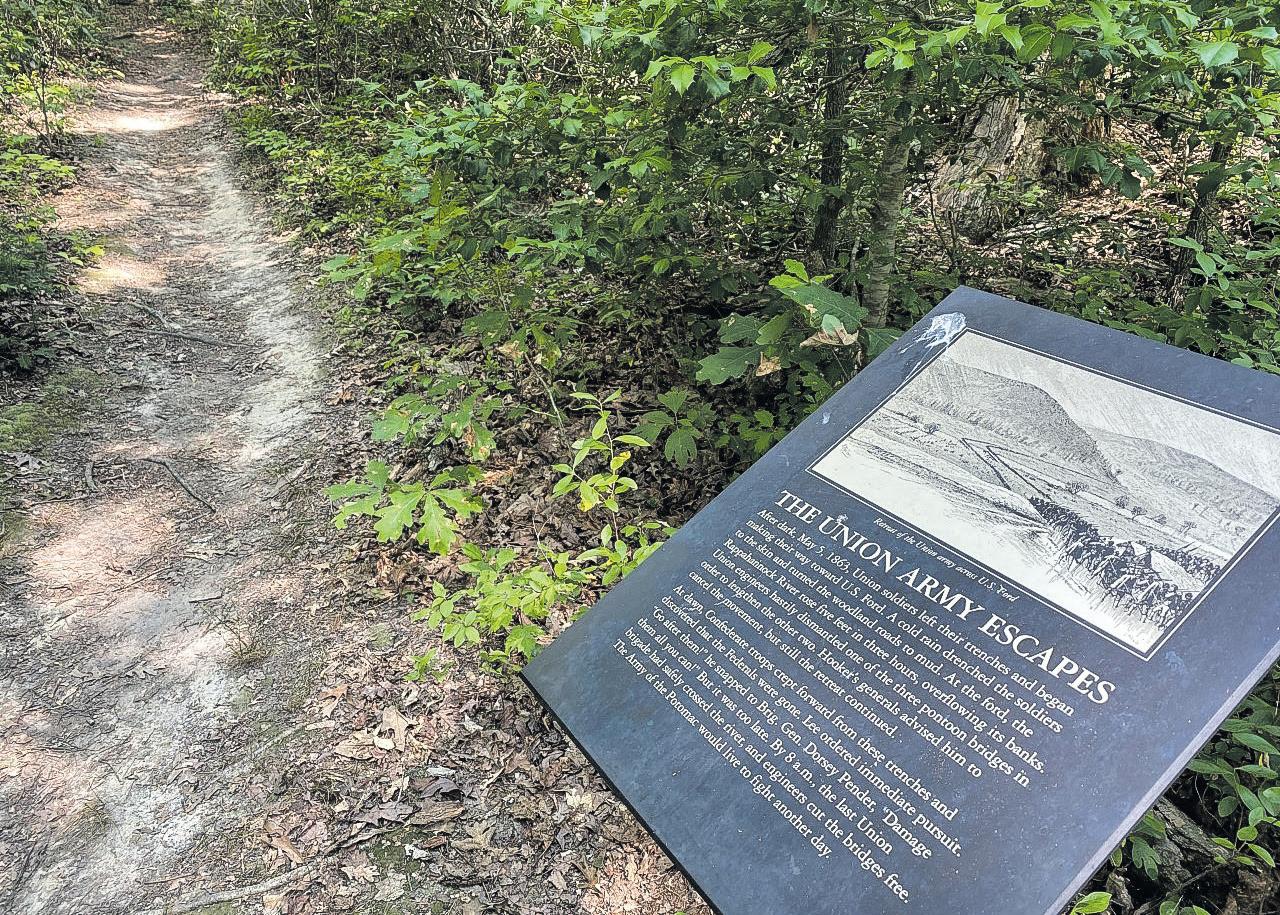
34 CWN September 2020 www.emergingcivilwar.com
Chris Mackowski
The Chancellorsville History Trail features interpretive signs that help tell the story of the end of the battle.
The New Market battlefield on a beautiful summer day.
Phill Greenwalt loves to talk about his home state of Maryland and his adopted state of Florida in the Civil War.
unchartered. It had minimal railroad mileage, and a large part was still untamed Everglades. The state’s population, at the time of secession, ranked it 11th out of 11 Confederate states. To put it in perspective, Florida had 30% fewer people than the 10th most-populated state in the Confederacy, Arkansas. By 1862, the Confederacy had largely given up defending the state, with its many miles of coastline and the strength of the U.S. Navy, so the state was largely forgotten until Confederate authorities realized they needed Florida’s economic factors: cattle and salt. Or when those former authorities needed to leave the country!
When people come to Florida, they tend to be drawn to other tourist attractions, Disney World, South Beach, and the Space Coast for some reason.

If a visitor to the Sunshine State could visit just one Civil War site, what would you recommend?

If you want to visit a battlefield, Olustee, in a still largely undeveloped area, has a great reenactment on the anniversary in February, great time to be in Florida. It was a very savage but important engagement in 1864. I think someone gave a talk on it at an ECW Symposium about how it was one of the forgotten battles.

Aside from a battlefield, Fort Jefferson in Dry Tortugas is a unique experience. It’s the largest brick fort in the western hemisphere. Dr. Mudd, from the John Wilkes Booth conspiracy, was held there. It’s located 67 miles off the coast of Key West.
Lightning Round (short answers with a one-sentence explanation)
Favorite primary source?


Can it be a tie? E.P. Alexander and W.W. Goldsborough’s The Maryland Line in the Confederate Army 1861–1865.
Favorite Civil War-related monument? 2nd Maryland (CSA) at Gettysburg. It misspells the brigade commander and has two unit designations, I’ll let those interested go see it and do the research.

Favorite unsung hero of the Civil War era?
Is John C. Breckenridge unsung? If not, J.J. Dickison (CSA) and Nathan Kimball (USA)
What’s a bucket-list Civil War site you’ve not yet visited?
Fort Donelson National Battlefield.
Favorite ECWS book that’s
not one of your own?
Let Us Die Like Men: The Battle of Franklin by Lee White.
ECW Bookshelf
We have two new audiobooks now available as part of the Emerging Civil War Series.
• Strike Them a Blow: Battle Along the North Anna River by Chris Mackowski, narrated by the author.

• A Long and Bloody Task: The Atlanta Campaign from Dalton to Kennesaw Mountain to the Chattahoochee River by Stephen Davis, narrated by Gary Williams.

soon on Amazon. To hear more about the book, click over to our Facebook page and listen to the Rev War Revelry with the author Billy Griffith: https://www. facebook.com/emergingrevwar/ videos/1586386451520562.
Each Sunday, at 7 p.m. EST, remember to click over to the Facebook page for the next installment of “Rev War Revelry,” an hour-long historian happy hour on topics related to the era. And, as always, continue to check out at blog at www.emergingrevolutionarywar.org.


Civil War Artillery Book
A 392 page, full-color, Civil War Artillery Projectiles – The Half Shell Book.

For more information and how to order visit the website www. ArtillerymanMagazine.com or call 800-777-1862. $89.95 + $8 media mail for the standard edition. Hardbound.

Both are available from Amazon.com, Audible.com, and our publisher, Savas Beatie (https://www.savasbeatie.com/).
July in American Revolutionary War history is a month to celebrate. On July 2, the Continental Congress agreed on independence, and on July 4 John Hancock affixed his grandiose signature to the bottom of the document declaring it so.
There is also reason to celebrate for ERW. This month, the latest volume of the Emerging Revolutionary War Series book was released: A Handsome Flogging: The Battle of Monmouth, Jun. 28, 1778. The book is available for purchase through Savas Beatie (https:// www.savasbeatie.com/a-handsome-flogging-the-battle-ofmonmouth-june-28-1778/) and
35
2020 CWN
September
The two latest audiobook releases from the Emerging Civil War Series.
William Wells, Civil War Medal of Honor Recipient


 by William Sweeney
by William Sweeney
Brigadier- and Brevet MajorGeneral William Wells was born in Waterbury, Vermont, Dec. 14, 1837. He enlisted as a private in Company C, First Regiment Vermont Cavalry, Sept. 9, 1861; was sworn into the United States service, Oct. 3, 1861, at the age of twenty-three years; commissioned first lieutenant, Co. C, Oct. 14, 1861, and captain, Nov. 18, 1861; mustered November 19, 1861, with the field and staff of the First Vermont Cavalry, to serve for three years. Promoted major, October 30, 1862; colonel, June 4, 1864. Appointed brevet brigadier-general of volunteers, Feb. 22, 1865, and brigadier-general of volunteers, May 19, 1865. Appointed brevet major-general of volunteers, March 30, 1865, “for gallant and meritorious services.”
He led the 7th Michigan Cavalry, March 2, 1864, while near Richmond, Va., and continued in command of the regiment for several weeks. As major, he commanded his own regiment from June 3, 1864 to July 2, 1864.
Promoted to colonel, he led the 1st Vermont cavalry regiment until September 19, 1864, when he assumed command of the Second Brigade, Third Division, Cavalry Corps, Army of the Potomac. He commanded this brigade until May 22, 1865, when he assumed command of the Third Cavalry Division. He was in command of the cavalry corps from June 1 to June 24, 1865, being its last commander. He mustered out Jan. 15, 1866.
He was wounded by a sabre at Boonesboro, Md., July 8, 1863, and by a shell fragment at Culpeper Court House, Va., Sept. 13, 1863 He was briefly a

prisoner of war in Libby prison, Richmond, Va., from March 17, 1863, to about May 6, 1863.
During his service with the First Vermont Cavalry, General Wells took part in the following battles and skirmishes: Middletown, Winchester, Luray Court-House, Culpeper CourtHouse, Orange Court-House, Kelley’s Ford, Waterloo Bridge, Bull Run, Warrenton, Hanover, Hunterstown, Gettysburg, Monterey, Leitersville, Hagerstown, Boonsboro, Falling Waters, Port Conway, Culpeper Court-House, Somerville Ford, Raccoon Ford, James City, Brandy Station, Gainesville, Buckland Mills, Falmouth, Morton’s Ford, Mechanicsville, Piping-Tree, Craig’s Meeting House, Spottsylvania, Yellow Tavern, Meadow Bridge, Hanover Court House, Ashland, Hawes’ Shop, Bottom Bridge, White Oak Swamp, Riddle’s Shop, Malvern Hill, Reams’s Station, Nottoway Court House, Roanoke Station, Stony Creek, Reams’s Station, [sic] Winchester, Summit Point, Charlestown, W.Va., Kearneysville, and Opequan.
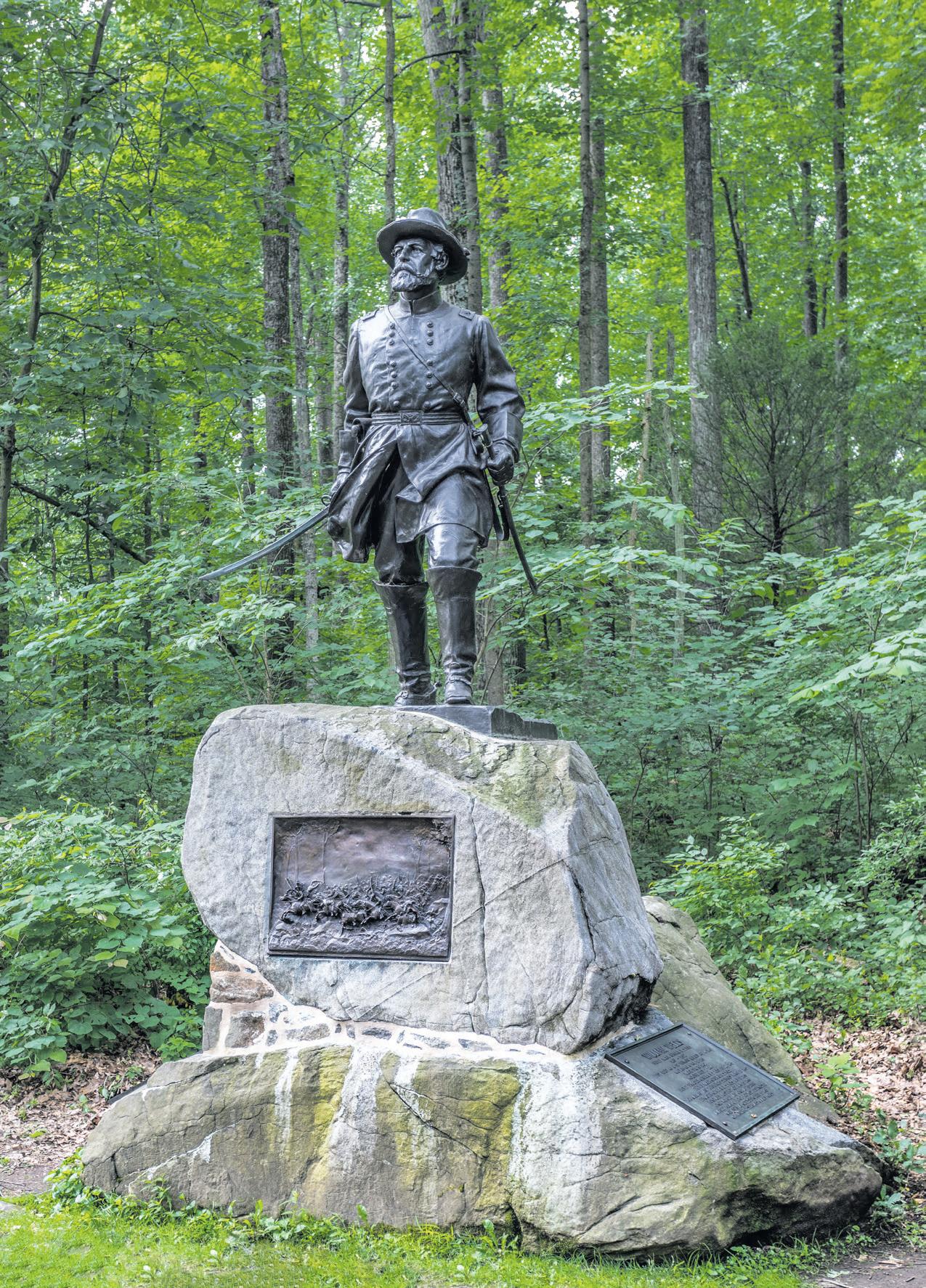

At the grand review, Washington, D.C., May 22,
1865, he commanded the Second Brigade, Third Division, Cavalry Corps, which led the advance of the Army of the Potomac. A medal of honor was awarded him by Congress “for distinguished gallantry at the battle of Gettysburg, Pennsylvania, July 3, 1863.” He was collector of customs, District of Vermont, from 1872 until 1885.
General Wells was elected to the office of adjutant and inspector-general of the State of Vermont in 1866, and resigned in 1872. He was one of the trustees of the Vermont Soldiers’ Home. He was a member of the Grand Army of the Republic, and a charter member and first commander of the Vermont Commandery, Military Order of the Loyal Legion.
General Wells died April 29, 1892, and is buried at Lake View Cemetery, Burlington, Vt.
Wells’ obituary noted that he served in the Vermont Legislature from 1865 to 1866 and again as State Senator from 1886 to 1887. A statue of General Wells was dedicated at Gettysburg in 1913, and an identical statue can be found in Battery Park, Burlington, Vt.
The first Medal of Honor
presentation took place in 1863. Since then, and as of October 30, 2019, there have been 3,525 Medals of Honor awarded. This includes 19 double recipients and 9 unknowns but does not include those revoked by the 1916 Army Review Board. Of the 3,525 recipients, 1,523 are from the Civil War.

The mission of the Medal of Honor Society of the United States’ (MOHHSUS) is dedicated to provide for the research, preservation, and documentation of the history of the individuals who have been awarded the Medal of Honor, the highest award that can be bestowed upon a member of the U.S. Armed Forces. Membership is open to all and is only $20 annually. Please visit our webpage at www.mohhsus.
com to learn more.
Source:
Men Of The Century, edited by Charles Morris, Philadelphia, Penn., 1896.
William Sweeney is from Woburn, Massachusetts. He is an Army veteran of the Vietnam War, and belongs to several veterans organizations including the VVA, DAV, VFW, Amvets, and American Legion. He is a descendant of a Civil War veteran and has a particular interest in the Civil War. He also has a special interest in the Medal of Honor, and is Vice President of the Medal of Honor Historical Society of the United States. He has been a subscriber to Civil War News for many years.
36 CWN September 2020 Want To Advertise In Civil War News? Email us at ads@civilwarnews.com Call 800-777-1862 CW N Vol. 46, No. 48 Pages, January 2020 $3.50 Civil War News America’s Monthly Newspaper For Civil War Enthusiasts Remembrance Day, 2019, Gettysburg President Lincoln was wrong–and visiting monuments.enactors; still impressive num-(Garry Adelman, American
Statue of Major General William Wells at Gettysburg. Sculpture by J. Otto Schweizer (1863–1955). Photograph by Jack Melton.
Portrait of William Wells.
What Robert E. Lee Means to Me
Mexican-American War. Lee was also the superintendent of West Point Military Academy from 1852–1855. He was president of Washington College in Lexington, Va., from 1865 until his death in 1870. There were many titles and posts that Lee held in his life in both military and civilian roles. However, he always sought to make the right decision regardless of where he was.

student at the Military Academy, he most likely had many temptations to go have fun, not study, or even drop out of West Point. He did not quit and graduated with NO DEMERITS his senior year. No one has ever been able to do that before or after Lee all the way up to the present day.

the States, Robert E. Lee, and the Battle of New Market. Her family has been going to the New Market reenactment for about three years. One of her favorite parts of the reenactment weekend is the dancing. Her family got her interested in New Market because her ancestor fought and was killed there.


His name was Captain Conrad Currence of the 62nd Virginia Infantry Regiment. On a trip to Lexington, Va., she was able see the Virginia Military Institute and learned the cadets fought at New Market. She hopes to attend Virginia Military Institute when she graduates from homeschooling.
 by Abigail Lang
by Abigail Lang

One of my favorite historical characters lived during the War Between the States. His name was Robert Edward Lee and he was born on January 19, 1807. Although most people recognize him as the commander of the Confederate Army, he also held many other titles. Apart from fighting in the War Between the States, Lee also fought in the
We can learn many things about Robert E. Lee. However, one of the most critical issues he is famous for is perseverance. For example, when he was a young boy, about 11-years-old, his father died. After his father died Lee promised himself that he would apply himself very diligently to his studies and go to college. That was probably difficult for him especially as a boy. He probably had very many temptations to not study and go play with his friends. The Lee family had many financial difficulties due to the death of Robert’s father at such a young age. Later as a college
Ulysses S. Grant, the leading general of the United States Army in the War Between the States, who later became president, also went to West Point. He got over 250 Demerits during his time as a student at West Point. Later in life Lee would find himself surrendering to Grant at Appomattox after a war that lasted four years.

Robert E. Lee was an outstanding character who we should all try to make ourselves like. He was a great example of perseverance and trying to do the right thing. President John F. Kennedy stated, “As a New Englander, I recognize that the South is still the land of Washington, who made our Nation, of Jefferson, who shaped its direction, and of Robert E. Lee who, after gallant failure, urged those who had followed him in bravery to reunite America in purpose and courage.” While it would be wrong to think Robert E. Lee always made the correct choice, he is still someone that we can all admire and learn from in our lives.
Abigail Lang is 13-years-old and has been homeschooled her entire life. She enjoys reading books about The War Between
37 September 2020 CWN
Abigail Lang
Abigail Lang in period dress during a Living History event.
General Robert E. Lee, wearing his military uniform with his sword. Library of Congress.
A Week in 1862 with Stuart’s Cavalry Covering Lee’s Flank
by Daniel Carroll Toomey
On Sept. 5, 1862, Lee’s Army of Northern Virginia began crossing the Potomac River at White’s Ford, Edward’s and Noland’s Ferries. Frederick native Colonel Bradley T. Johnson was given the honor of leading Jackson’s Corps into Maryland at White’s Ford as the bands played “Maryland My Maryland.” General J.E.B. Stuart’s assignment was to protect Lee’s right flank until his entire army had crossed the river. In order to cover all the roads leading to Frederick City from Baltimore and Washington he established a defensive arc from the mouth of the Monocacy River to New Market. Between Sept. 5 and 12, Union and Confederate cavalry were constantly engaged. The numerous skirmishes and small battles fought during that time represent a classic example of Confederate cavalry covering
the Army of Northern Virginia’s flanks. While this type of operation undoubtedly occurred numerous times in Virginia, it only happened once in Maryland on this grand a scale.
Stuart left Leesburg, Va., with two brigades, at 2 p.m. on Sept.
5. Hampton’s Brigade crossed at White’s Ford. Fitzhugh Lee’s Brigade crossed lower down the river at Edward’s Ferry. Colonel Thomas Munford covered the army’s rear with less than 300 hundred cavalrymen. Stuart ordered Fitz Lee to occupy Poolesville, Md., before making camp for the night.1
Stuart’s adversary was General Alfred Pleasonton, commander of the Cavalry Division of the Army of the Potomac and a native of Washington, D.C. Pleasonton sent out three regiments to reconnoiter between Seneca Creek and Poolesville.

At 4 p.m. 100 men from the First Massachusetts Cavalry passed through Poolesville under Captain Samuel E. Chamberlain. The town’s citizens showed their Southern leanings by erecting a barricade in the street after they left. The Yankees soon encountered the Fifth Virginia Cavalry and were driven back into the town where a collision with the newly erected impedimenta brought about a great number of unhorsed riders; in all 48 men and 40 horses were captured. Confederate losses were three killed and four wounded. That night both Lee’s and Hampton’s brigades made camp at Poolesville.2
The next day Fitz Lee’s Brigade moved to New Market on the National Road and sent patrols out as far east as Ridgeville. Hampton’s Brigade occupied Hyattstown with outposts at
Damascus and Clarksburg. Colonel Munford’s Brigade was now up and anchored the right of Stuart’s line at Sugar Loaf Mountain with pickets extending all the way to Poolesville.3
In Frederick City Surgeon Robert E. Weir commanded the Federal army hospital at the old Hessian Barracks. When he received word from Colonel Dixon Miles, the post commander at Harpers Ferry, that the Confederate Army was only a day’s march from Frederick, Surgeon Weir and Lieutenant G. Castle, with the help of Captain William T. Faithful and Company C, First Potomac Home Brigade worked together to prevent as many sick soldiers as possible from being captured. In Captain Faithful’s official report he stated that he secured all available horses and wagons in the city, loaded two wagons with the most valuable medical supplies, put 275 convalescent soldiers in the rest, and sent them off to Pennsylvania under the command of assistant surgeon C.P. Harrington. They then set fire to what could not be removed. Captain Faithful also managed to send an entire train load of military supplies to Baltimore before the Baltimore & Ohio Railroad line was cut. Just south of Frederick City, the B&O’s main line crossed the Monocacy River on an iron
suspension bridge consisting of three spans each 115 feet long. On Sept. 8 the Confederates set about destroying the bridge. Earlier attempts had failed due to a lack of tools and explosives. This time gun power was poured into the cores of the iron castings. The resulting explosion knocked the three spans off their piers and into the water below. The bridge was not replaced until after the battle of Antietam.4
On the morning of Sept. 6, Fitzhugh Lee moved from Barnesville to New Market. He positioned his brigade to cover both the Baltimore Pike and the Baltimore & Ohio Railroad. His mission was to thwart any Union force moving west from Baltimore City and at the same time appear to be the army’s lead element advancing on Baltimore to disguise the direction Lee’s army was actually moving. He left behind a squadron of the Ninth Virginia under Captain Thomas C. Waller. When Union cavalry advancing toward Sugar Loaf Mountain overran Waller’s picket post and captured ten men, Waller quickly abandoned the town and retreated to New Market losing one man killed and six wounded in the process.5
Prior to this engagement Stuart led Hampton’s Brigade through Barnesville and skirted the base of Sugar Loaf Mountain. Before

38 CWN September 2020
Stuart’s Cavalry map. Brad Gottfried.
General J.E.B. Stuart. Library of Congress.
the Confederate invasion began Lieutenant Brinkerhoff N. Miner operated a signal station on the mountain’s summit. Part of a chain of posts that ran from Darnstown to Emmetsburg, it provided the Federal capitol with an early warning system. Chief Signal Officer of the U.S. Army, Major Albert J. Myer, stated, “The range of vision from this point is unequaled by that of any other in Maryland.” Given its name from its shape, the mountain rises 750 feet above the Monocacy Valley. Troop movements could be observed as far south as Leesburg, Va., as well as several crossings on the Potomac River. To both the east and the west it provided a sweeping view of the Maryland countryside. Lieutenant Miner had established the signal station there on Sept. 3 and it sent the first report of Confederate forces moving into Maryland.

Fearing the approach of Confederate patrols, Miner abandoned the post the night of Sept. 5. The next day Captain Miner and his flagman, A.H. Cook, were in route to reopen the station when they happened upon two Rebel cavalrymen. One, a courier who unbeknown to them was carrying dispatches from President Jefferson Davis to General Robert E. Lee, was captured. His companion managed to
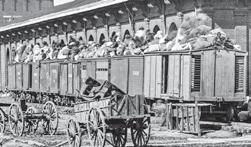
escape and informed Stuart of the captured courier. A detachment of the First North Carolina took off in pursuit followed by Stuart with Hampton’s Brigade. The galloping Confederates overtook the two Yankees and their prisoner before they got far. Neither Union soldier had taken the time to search their prisoner so no vital information was lost. With the two Yankees, Stuart also captured a complete set of signaling equipment that he used to open his own signal station on Sugar Loaf Mountain.6 He also presumably captured the Federal signal codes.
After recapturing the courier, Stuart, with Hampton’s Brigade, proceeded to Urbana. Meanwhile in Frederick City, a member of Elijah V. White’s 35th Battalion of Virginia Cavalry rode up to the hospital at the Hessian Barracks and informed Surgeon Weir that he was a prisoner of war. Colonel Miles’ prediction was right on the money.
At the same time the Union cavalry continued to search for Lee’s army. Elements of the Third Indiana, First New York, and First U.S. Regiments nosed their way towards Hyattstown while the Eighth Illinois moved toward Poolesville. Two companies of the First New York skirmished with the Ninth Virginia at
Sugar Loaf Mountain and were forced to return to Clarksburg. Hampton’s Brigade spread out around Urbana and Stuart made his headquarters there at the home of Mr. Cockey.7
On Sept. 6, Munford’s Brigade, the Second, Seventh, Twelfth Virginia, and Chew’s Battery of horse artillery, crossed the Potomac at White’s Ford. While Munford crossed and deployed, the newly reconstituted Army of the Potomac began moving west from Washington. General McClellan established his headquarters at Rockville where he was joined by the VI Corps.8
On Sept. 7 a detachment of Union cavalry charged into Poolesville and captured two Rebel videttes stationed there. Early the next morning, Munford’s Brigade was sent to Poolesville to chase off Union cavalry threatening to discover the Confederate infantry camped west of the Monocacy River. In effect, General Pleasanton was running a mirror image of Stuart’s operation, attempting to find the enemy and provide a protective screen for the slowly advancing Army of the Potomac.
When Colonel John F. Farnsworth, commander of the Second Brigade of cavalry led the Eighth Illinois and Third Indiana into Poolesville supported by two

guns of the Second U.S. Artillery, Munford opened fire with two guns from Chew’s Battery, a Blakely, probably a 3.5-inch rifle, and a 12-pounder howitzer. The Union cavalry was forced to fall back until their own guns could go into action. Chew nearly lost both his pieces when the Union cavalry came on again at full gallop. Two rounds of canister and a counter charge by the Seventh Virginia saved the howitzer, while the Twelfth Virginia lost eight men defending the Blakely rifle. By the end of the day Poolesville was in Federal hands. Farnsworth lost one man killed and twelve wounded; the Confederate losses were five killed, nine wounded, and six captured.9
When Stuart took up residence in Urbana he discovered a two story building that had previously been used as a female academy. He deemed it an excellent place for a ball and ordered the necessary arrangements made for September 8. Major Heros von Borcke of Stuart’s staff was master of ceremonies. He proclaimed Miss Anne Cockey, AKA the New York Yankee, the queen of the ball. Just as things were going in great style, Major Alonzo Adams led five companies of the First New York Regiment against Hyattstown, an outpost four miles away. A quick-thinking
line officer sent a courier to warn Stuart just before his position was overrun.
Directed to the academy, the dust covered trooper’s announcement that a battle was in progress was authenticated by distant gun fire. Officers quickly bid adieu to the ladies as they buckled on sabers and rode out of sight. Stuart pushed the impertinent Yankees out of Hyattstown with Hampton’s Brigade and Pelham’s horse artillery. Once the situation was stabilized, he turned the operation over to his subordinates and returned to Urbana where the ball was resumed around midnight.10
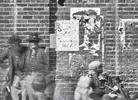
Pressure began to mount as the Army of the Potomac crept closer to Frederick City. Union cavalry occupied Damascus and Lisbon with an eye to advancing on New Market. Farnsworth, with the Eighth Illinois and Third Indiana supported by the Fourth Maine Artillery, advanced from Poolesville and pushed the Rebels out of Monocacy Church and Barnesville on Sept. 9. When Farnsworth’s regiment attacked two companies of the Twelfth Virginia on picket at Monocacy Church, several of the Rebel’s horses were killed and others stumbled over them throwing
page 44





“The best little book on Barnard”
The American Civil War was the rst war in which both sides widely used entrenchments, repeating ri es, ironclad warships, and telegraphed communications. It was also the rst American War to be extensively photographed. Mathew Brady, Alexander Gardner and Timothy O’Sullivan are famous for having made iconic photographs in the Civil War’s eastern theater. George N. Barnard deserves to be ranked in this top tier for his photographic work in the war’s western theater. A civilian photographer hired by Gen. William T. Sherman’s chief engineer to take pictures of forti cations around Atlanta, Barnard took several hundred of them in and around the city in the fall of 1864. His most famous is the site of Union Maj. Gen. James B. McPherson’s death in the battle of Atlanta, July 22, 1864. Thus far, no comprehensive, de nitive listing has been made of the photographer’s work. For this book we have chosen a hundred images we deem “signi cant.”


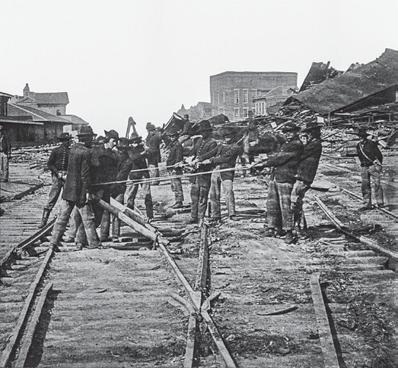


128 page Paperb ac k: $19.95 (+$3.50 S & H)
Ordering
39 September 2020 CWN “The STORIES BEHIND THE PICTURES” 100 Significant Civil War Photographs CHARLESTON IN WAR By Stephen Davis & JACK W. MELTON JR Name Shipping Address City State Zip 160 pages • OVER 100 PHOTOS • MAPS • INDEX • BIBLIOGRAPHY • ISBN: 978-1-61850-167-7 Paperback: $19.95 (+$3.50 S & H) • Released Jan. 2020 3 ways to order YOUR COPY! CALL US 800-777-1862 ORDER ONLINE www.historicalpubs.com fill out this form BELOW & mail with a check for $23.45 to: Historical Publications LLC 520 Folly Road, Suite 25 PMB 379, Charleston, SC 29412 (S.C. residents include 9% sales tax of $1.80) newly and Charles photograph, selected e Fire allow book are Confederates Harbor Reminiscences of Federal history historical works. such as (1838–1910). DAVIS & MELTON 100 SIGNIFICANT CIVIL WAR PHOTOGRAPHS CHARLESTON IN THE WAR
info: $19.95 plus $3.50 s&h South Carolina residents add 9% sales tax Mail a check to: Historical Publications LLC 520 Folly Road, Suite 25 PMB 379 Charleston, SC 29412 or Order online at www.historicalpubs.com Wrecking Atlanta Northern Engineers Prying Up Track the right—leading one to deduce that this picture was taken on the afternoon of November series of the 1880s. When the men of the 1st Missouri Engineers (oneofPoe’s thecaption,“theFirstMissouriEngineersdestroyingarailroadshowingtheuseofhooks made by them for the purpose.” for Monday, November 7. Freedpeople on the Boxcars Library of Congress. Congress images bear no captions (as do Poe’s pictures), so students of Barnardiana have to scrutinize the pictures and compare them to others. In identifying these kinds of scenes, viewers look for telltale clues. One the most important Confederate Lt. Col. Bushrod W. Frobel, assistant chief engineer in Hood’s army, called this“thePeachtreestreetbattery.”InhisdiaryentryforAugust14,1864,heremarkedon Peachtree Battery–Another View Order these books online at www.HistoricalPubs.com
H Stuart . . . . . . . . . . . see
CIVIL WAR BOOK,___ B mv 11:
Civil War News book reviews provide our readers with timely analysis of the latest and most significant Civil War research and scholarship. Contact email: BookReviews@CivilWarNews.com.


Indian Nations: Civil War within a Civil War
Caught in the Maelstrom: The Indian Nations in the Civil War, 1861–1865. By Clint Crowe. Bibliography, footnotes, photographs, maps, index. 300 pp., 2019, Savas Beattie, www. savasbeattie.com. $32.95.

Reviewed by Joseph A. Derie
Finally—An Objective Look at Sigel in the Shenandoah
Union Command Failure in the Shenandoah: Major General William Franz Sigel and the War in the Valley of Virginia, May 1864. By David A. Powell. Photos, maps, notes, index, 264 pp., 2019. Savas Beatie, www.savasbeatie.com. $29.95.
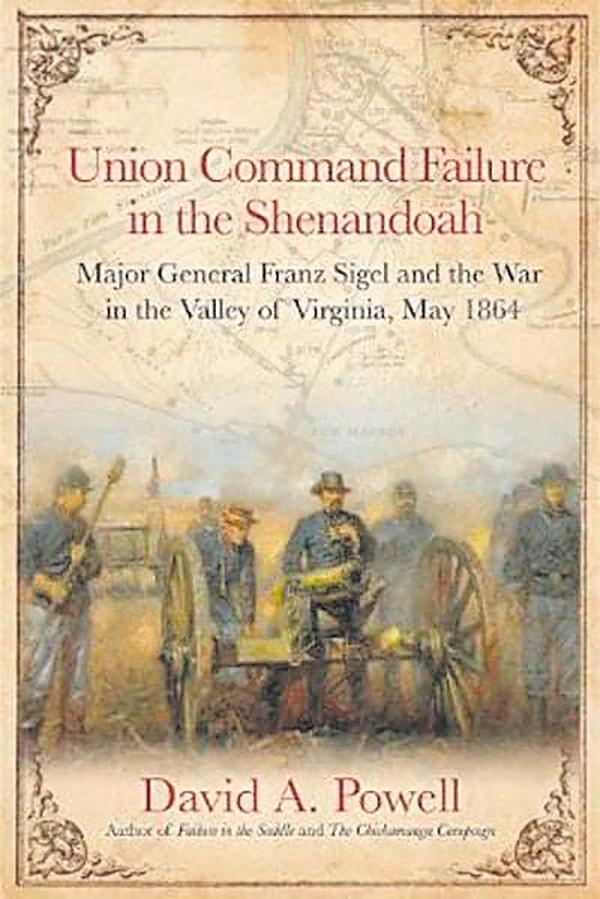
Reviewed by Jonathan A. Noyalas

fought within the Indian Nations by Indian troops supported by Texans or Kansans. Within the territory’s borders the population was at the mercy of guerilla bands, bandits and people out for themselves or to pay off grudges. The latter included the Union siding Keetoowah Society, made up of Cherokee full-bloods.
Stand Watie surrendered his troops on June 23, 1865. The author states that he was “likely” the last Confederate general to surrender. All other sources state he was the last and it is unusual that a scholarly work of this nature would not seek a definitive answer to that question.
Stand Watie’s surrender may have ended the fighting but did not end the war in the Nations because it was not a state, and therefore different federal laws and treaties applied there. It would take until September when a council met and terms and a full government was agreed to by both sides.
Additionally, Powell analyzes how, at times, Grant’s decisions impeded Sigel’s ability for success, including not providing Sigel the manpower required properly carrying out his mission and preventing Confederates in the Shenandoah from supporting the Army of Northern Virginia’s operations east of the Blue Ridge Mountains. Securing the Valley was a task that proved the bugbear of many Union Shenandoah commanders since the conflict’s outset.
so asinine that he feigned illness to avoid them. While some historians previously characterized Sigel’s mock battles as another example of his foolishness, Powell views them as evidence of Sigel’s awareness of the lack of combat experience that existed in his army and his reasonable effort to remedy that deficiency.
The Indian Nations, or Indian Territory as it was also known, due to the U.S. government’s ceding the area to the “Five Civilized Tribes” (the Cherokee, Creek (Muscogee), Choctaw, Chickasaw, and Seminole) in the 1830’s. This area would mostly become present day Oklahoma. Prior to, and during the Civil War, the Indian Nations and their politics were split among pure blood non-slaveholders, and mixed bloods, many of whom were slaveholders.
It is not surprising the slaveholders sided with the Confederacy, providing various regiments to the Confederate Army, and a general officer, Brigadier General Stand Watie, a Cherokee; while the non-slaveholders stood with the Union, providing the Union Indian Brigade.
The Civil War in the Indian Nations was thus a Civil War within a Civil War, as found in Tennessee, Missouri, and western Virginia, with all the tragedy and hatred of brother against brother. There were a number of battles
The volume also includes a very interesting “exclusive excerpt:” “Chapter 6: Protecting Johnsonville: Union Defense of the Supply Depot,” from the publishers recent Johnsonville: Union Supply Operations on the Tennessee River and the Battle of Johnsonville, November 4-5, 1864. This will be of special interest to fans of Nathan Bedford Forrest and the Civil War in Tennessee.
Caught in the Maelstrom is based on the author’s dissertation and has been ably researched by the author. It is highly recommended to those with special interest in the Trans-Mississippi Civil War, as well as in the former Indian Nations and the areas surrounding it.
Capt. Joe Derie is a longtime Civil War buff with a special interest in Civil War naval history and the Civil War in the West. He is a retired USCG officer and a licensed officer of the Merchant Marine, currently self-employed as a marine surveyor and marine accident investigator in Portland, OR.
Twenty-seven years ago, historian Stephen D. Engle, in his biography of Union general Franz Sigel, Yankee Dutchman, offered a scathing assessment of Sigel’s conduct in the Shenandoah Valley during the spring of 1864. Engle concluded that Sigel’s generalship in the weeks leading up to and during the Battle of New Market proved Sigel a “fool.” While historians prior to the publication of Engle’s biography reached similar conclusions and scholars have continued to assess Sigel’s ability to command in a similar vein since, author David Powell’s thoughtful volume convincingly challenges that notion in this outstanding study.
Powell, best-known for his work on Chickamauga, does not profess to be an apologist for Sigel, but rather aims to scrutinize him under a more objective lens to illustrate that Sigel’s conduct in the Shenandoah Valley during the spring of 1864 was not that of “a blundering fool, and not all of his decisions wrong-headed.” Through careful analysis of a wide array of primary and secondary sources Powell offers an unprejudiced examination that shifts Sigel from “caricature” to “commander.”
Throughout the book’s ten chapters, the author masterfully recounts the decision to appoint Sigel to command and how Sigel’s Department of West Virginia fit into Grant’s overall strategy in the spring of 1864.
Beyond insightful analysis of the ways in which Grant’s decision adversely impacted Sigel; Powell does a remarkable job of analyzing the varied abilities of the regiments and subordinates who comprised Sigel’s command. Not only did some units lack combat experience, animosity existed amongst regiments as some regimental commanders balked at the idea of serving in brigades with regiments they believed inferior. For example, some in the 34th Mass. Inf. did not approve of being in the same brigade with the 116th and 123rd Ohio Inf. Although the two Ohio regiments had combat experience, and the 34th had none, some of the 34th’s officers believed their regiment better-disciplined and more proficient in drill. While indeed, as the author notes, the 34th might have appeared better on the parade ground, their lack of combat experience proved detrimental during the culmination of Sigel’s spring campaign in the Shenandoah Valley, the Battle of New Market.
Enmity, as the author rightfully concludes, not only existed between various regiments, but between some of those regiments and Sigel. When Sigel staged mock battles in Winchester during early May, dissension among some subordinates rose significantly. Among those who did not see any merit in mock battles was the 34th Massachusetts’ Colonel George Wells. He believed them
Although Powell does a terrific job highlighting various factors working against Sigel, he is balanced in his assessment and points out critical strategic errors Sigel made leading up to the Battle of New Market, such as his ill-advised decision to send Colonel William H. Boyd with a hodge-podge cavalry command to Luray. Powell also enumerates Sigel’s tactical errors at the Battle of New Market, covered in three of the book’s chapters, including ordering a counterattack against Confederate General John C. Breckinridge’s command on Bushong Hill and his failure to appropriately utilize Brigadier General Jeremiah Sullivan at New Market.
This study, solidly written, soundly researched, profusely illustrated, and enhanced with detailed maps is indispensable reading for anyone interested in Shenandoah Valley Civil War conflict. Its importance transcends those who study that oft-contested region. To those interested in understanding the animus existing among soldiers of the same army Powell’s volume is also quite useful.
Jonathan A. Noyalas is director of Shenandoah University’s McCormick Civil War Institute in Winchester, Virginia, a professor in Civil War Era Studies at Shenandoah University, and founding editor of Journal of the Shenandoah Valley During the Civil War Era. He is the author or editor of thirteen books including Civil War Legacy in the Shenandoah: Remembrance, Reunion, and Reconciliation.
40 CWN September 2020
A Revolution that had Global Implications

The Second American Revolution: The Civil WarEra Struggle over Cuba and the Rebirth of the American Republic. By Gregory P. Downs. Notes, Bibliography, and Index, 232 pp., 2019. The University of North Carolina Press. www.uncpress.org. Cloth. $27.95.
 Reviewed by David Marshall
Reviewed by David Marshall
the change that was happening with Ulysses S. Grant’s upcoming presidential inauguration. The paper emphasized that the Union general would help bring about a transformational change. Significant modifications were the end of slavery, citizenship for freed people, forcing the last Southern states to accept voting rights for African American men and the 13th, 14th, and 15th amendments with the threat of martial law. In the end, Gregory Downs makes the excellent point that these reforms came about due to a violent reconstructing of a reunified nation’s political structure.
Revolution.
The Civil War was more than a fight between two regions of the United States. This was greater than a domestic struggle, or a fight to preserve the nation. The differences were not only national but international as well. It spilled into many other nations, confronting how the world was going to change. Would countries be free-labor republics and governed by a constitution with slavery ended or would empires continue to dominate many countries and regions?
In the end, Americans called the four-year nineteenth century conflict such names as the Rebellion or the War of Secession. During the early 20th century, people phrased the term Civil War as an effort to depoliticize the struggle between the states and reconcile better relations with white Southerners. Some people even used the phrase second American Revolution for this momentous period in U.S. history. The New York Herald used this phrase on March 4, 1869, to describe

Downs explains that people in this time period wanted to see how the United States would influence old traditional powers such as Great Britain, France, and Spain and others as an emerging world power. This wonderful monograph starts off by detailing not only changes that occurred because of the Civil War and the passage of the Civil War/Reconstruction amendments but how citizens can reevaluate our founders, their legacy, the First American Revolution, and the establishment of a new government under a ratified constitution. The chapter titled “The Civil War the World Made” goes into great detail concerning how the U.S. helped bring about an end to global slavery as well as bringing about the establishment of constitutional republics and increased freedom and rights for colonial controlled countries such as Cuba.
Chapter three assesses what the Civil War and Reconstruction accomplished and what disappointments happened during the Jim Crow era to race relations and civil rights. The author further develops that, due to the turmoil that occurred in the United States, Mexico, Cuba, and Spain, the resulting changes failed to go far enough in Western Hemisphere countries including their own revolutions and independence in the years following the Civil War and the Second American
Finally, the chapter titled Afterward proposes that the Second American Revolution is unfinished today and did not go far enough in the nineteenth century. This excellent historian proves that many changes were significant such as freeing four million individuals who were held in bondage, the greatest emancipation in world history and the largest confiscation of property in any one nation’s history. Downs shows that the Civil War reshaped the United States, politically, socially, and economically, however, in the end bigger changes could have happened faster concerning civil rights for blacks, assistance with, and alliances with Atlantic world emerging revolutionary nations seeking independence from old world countries such as Spain.

Using numerous primary and secondary sources, Downs was able to bypass many opinions of previous authors and demonstrated an important new and insightful interpretation of a great deal that has not been studied in the past. He makes a substantial contribution to understanding what comprehensive deviations arose in the U.S. and in the world by providing fresh insight that helps us understand the motivation, strategies, tensions, controversies, and triumphs that have characterized the work and lives of people and nations involved in this excellent book. While this volume contains six important illustrations, it would have been helpful to all readers to have included many more images and a few maps. Highly recommended by this reviewer.
David Marshall is a high school American history teacher in the Miami-Dade School district for the past thirty-three years. A lifelong Civil War enthusiast, David is president of the Miami Civil War Round Table Book Club. In addition to numerous reviews in Civil War News and other publications, he has given presentations to Civil War Round Tables on Joshua Chamberlain, Ulysses S. Grant, Abraham Lincoln, the Battle of Gettysburg, and the Common Soldier.
Mahone “Porte” and “Gridiron”
The Petersburg Regiment in the Civil War: A History of the 12th Virginia Infantry from John Brown’s Hanging to Appomattox, 1859–1865. By John Horn. Maps, photos, diagrams, footnotes, bibliography, index, 440 pp., 2019, Savas Beatie, www.savasbeatie.com, hardcover. $39.95.

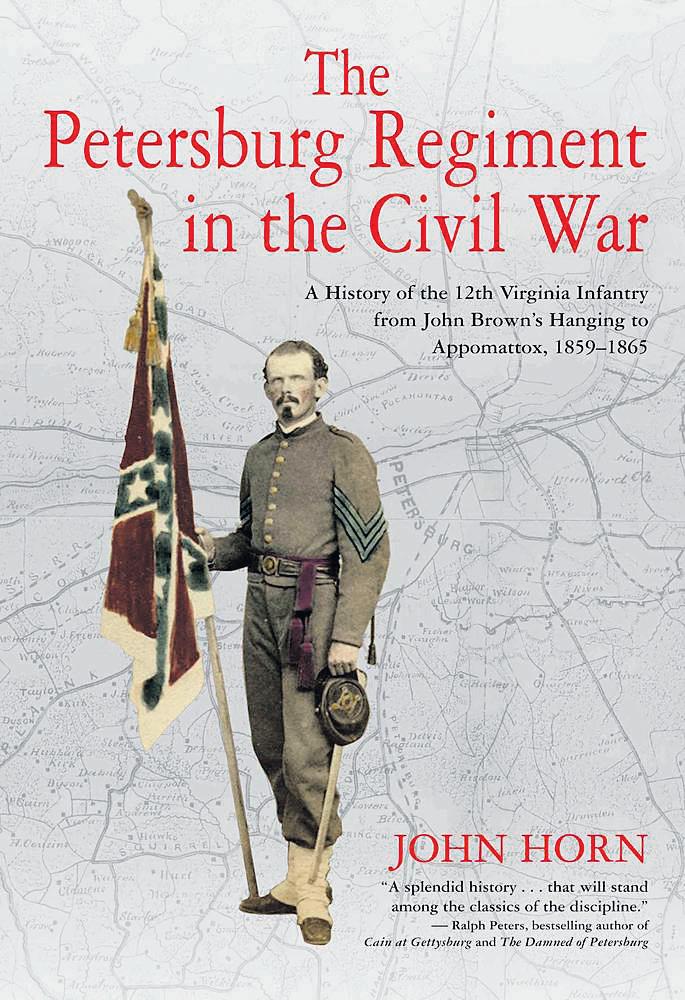
Reviewed by John Michael Priest
battles I never really knew very little about. Throughout the pages of this book, he emerges as a uniformed bantam rooster. The author makes no apologies or excuses for the regiment’s feelings toward African Americans in the Union Army or for their brutality in battle. The chapters on the Crater and Petersburg starkly describe how desperate and unforgiving the fighting had become by the last stages of the war in the East. Mr. Horn clearly has honestly portrayed the combat brutality, some of which shocked veteran George S. Bernard.
I also noted how he used the soldiers’ slang to describe their camps, their officers, and the U.S. flag, which I had never heard referred to as the “gridiron.” They called Mahone “Porte,” the reason for which you will have to read the book to discover.

Many Civil War enthusiasts are, probably, familiar with George S. Bernard’s, 1892, War Talks of Confederate Veterans and Hampton Newsome’s, John Horn’s, and John G. Selby’s excellent edition (2012) of Bernard’s previously unpublished, Civil War Talks: Further Reminiscences of George S. Bernard & Fellow Veterans, (UVA). Mr. Horn has expanded his research and produced this very good and much needed, Confederate regimental history.
The 12th Virginia served with distinction from the Peninsula though the rest of the war, with some of its hardest fighting occurring at Petersburg and the Crater. Interpreted through the astute observations of several more participants other than Bernard, this work puts the reader in the ranks to observe the war in all its grim reality from the ground up. Thoroughly illustrated with over 30 clear, easy to read maps and diagrams explaining regimental formations, the author puts every action into context by marking where the 12th was on the field, where I learned that the Virginians did not always, to their relief, get into the thickest part of the battle but when they did, they served very well.
They owed their tenacity, in part, to General William “Billy” Mahone, whose contributions to
Critics will probably find issues with the footnotes, because they only refer to primary sources concerning the 12th Virginia and not every secondary or Union regimental history cited in his extensive bibliography. That did not detract from the quality of the writing or the information in this book. Mr. Horn invested a lot of time and effort in creating this thorough regimental and it shows.
Mike Priest is author of Antietam: The Soldiers’ Battle (1989) and Before Antietam: The Battle of South Mountain (1992).
41 September 2020 CWN Digital Issues of CWN are available by subscription alone or with print plus CWN archives at CivilWarNews.com
Want To Advertise In Civil War News? Email us at ads@civilwarnews.com or call 800-777-1862 CW N Civil War News Inside this issue: Day Remembrance Day, 2019, Gettysburg President Lincoln was wrongThe world will little note, nor long remember what we say here, but can never forget what they did here. – Abraham Lincoln, November 19, 1863.es and visiting monuments. A Gettysburg National Cemetery Although the numbers of reenacwhen Wikipedia estimated thereenactors; still impressive num-Battlefield Trust)
The Lost Cause Reinterpreted
The False Cause: Fraud, Fabrication, and White Supremacy in Confederate Memory. By Adam H. Domby. Illustrated, bibliography, index, University of Virginia Press, www.upress.virginia.edu, 2020, 258 pp., hardcover, $29.95.

Reviewed by Wayne L. Wolf
Julia Grant’s Memoirs: The 45th Anniversary Edition
into attacks on Confederate monuments as inspired by a desire to justify white supremacy. Pensions awarded to blacks who served the Confederacy were dismissed as an early welfare system that rewarded subservient blacks.
Confederate soldiers fighting for what Col. John S. Mosby called “my Country” were portrayed as nothing more than protectors of slavery that was crucial in glorifying white control. While he concedes Confederate soldiers fought nobly, even if for a bad cause, he contends they were nevertheless racists who either intentionally, accidentally, or even unintentionally stood for white supremacy.
The Personal Memoirs of Julia Dent Grant (Mrs. Ulysses S. Grant): 45th Anniversary Edition. Edited by John Y. Simon. Photos, notes, index. 351 pp. Southern Illinois University Press, 2020. siupress.siu.edu. Softcover, $26.95.

Reviewed by Jonathan W. White
trip around the world (1877–1879). In the Introduction, Bruce Catton writes that this section of the book “is highly interesting; she was having fun, and she conveys her feeling of pleasant excitement.”
sob escaped him.”
The author states in the last chapter, “Anyone can make up an interpretation of history.” True to his word, Adam Domby does just that. Using North Carolina as a microcosm the old Confederacy, he presents selected incidents in four areas; opposition to secession by some North Carolinians, the presence of Union sentiment in the state, the resistance to conscription, and desertion rates among North Carolina Confederate soldiers, as evidence that North Carolina’s support for the Confederacy was lukewarm at best. No mention is made of similar Union difficulties, e.g. New York draft riots, desertion among Union troops in response to the Emancipation Proclamation, or Northern citizens going South to fight for the Confederacy. To have explained these might have tempered the author’s obsession with trying to make the Lost Cause School of historical thought nothing more than a justification for white supremacist ideology.
Professor Domby then launches
The author uses a selective series of quotes from North Carolina political speeches, as well as UDC and SCV talks, principally from 1902–1926, including one 8th grade graduation speech, to hammer home his ideology of white supremacy inherent in everything from the dedication of Confederate monuments to Southern soldiers, to supporting black pensioners, to voting for President Donald Trump. This selectivity omits any reference to opposing viewpoints of Black Power movements, or even just the good intentions of a Southern populace trying to honor their ancestors. The battle for States’ Rights is relegated to the dustbin of historical myth.
For all of these reasons, despite including some pension fraud cases, political self-serving speeches, and desertion rates that were illuminating, the overall liberal bias displayed precludes a recommendation that the book be purchased by Civil War historians. If you are looking for a balanced treatment of a sensitive topic, this is not your book.
Wayne L. Wolf is Professor Emeritus at South Suburban College and the author of numerous Civil War books and articles including Two Years Before the Paddlewheel and The Last Civil War Scout.
Publishers:
Please send your book(s) for review to: Civil War News

520 Folly Road, Suite 25 PMB 379 Charleston, SC 29412
Email cover image to bookreviews@civilwarnews.com

Ulysses S. Grant has received a much-needed reevaluation in recent years, largely due to major biographies by Ron Chernow and Ronald C. White, as well as a new annotated edition of Grant’s Memoirs, edited by John F. Marszalek. It is fitting that his wife’s memoirs should also receive renewed attention with this new, 45th-anniversary edition. Julia Dent Grant was the first First Lady to write a memoir, but her book remained unpublished until 1975, more than seven decades after her death in 1902. Fortunately, Grant’s great-grandchildren gave John Y. Simon, the late, eminent historian who for many years served as editor of The Papers of Ulysses S. Grant, permission to publish this important book. Now, forty-five years after it first appeared in print, Southern Illinois University Press has released a special anniversary edition with a new foreword by John F. Marszalek and Frank J. Williams, and a new preface by Pamela K. Sanfilippo.
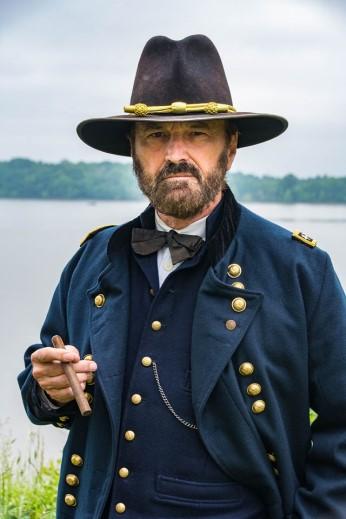
Mrs. Grant’s recollections begin with her childhood at her family’s plantation, White Haven, near St. Louis, Missouri, where she was born in 1826. The first six chapters cover her early life, the Civil War, and her hus band’s presidency. Chapters 7-12 recall the Grants’ post-White House years, with significant at tention given to their two-year
In fact, the entire book teems with wonderful anecdotes from the lives of Julia and Ulysses Grant. As a schoolgirl, Julia told her friends that she wanted to marry “a soldier, a gallant, brave, dashing soldier—and I got him, did I not?” Throughout her memoirs, she recalled touching, personal moments, such as when she was courting Grant and he attended the funeral of her beloved pet canary. Shortly after their wedding, Julia’s father said that she could remain at home and that Grant could visit “once or twice a year” when he received furloughs from the army. Grant could tell that Julia was upset by this idea. He put his arm around her and whispered, “Would you like this, Julia?” She replied, “No, no, no, Ulys, I could not, would not, think of that for a moment.”
“Then,” said Grant, “dry your tears and do not weep again. It makes me unhappy.” She wrote, “There was never again a word said about my staying at home,” she remained with him for much of the Civil War.
Julia’s stories of their children bring the Grant family to life. Once, two-year-old Jesse put on his father’s boots and fell down the stairs. Julia wrote, “The result was dreadful. His neck was not broken, but his four front teeth were broken squarely off, and he lay quivering and fainting in my arms.” On another occasion during the war, when Jesse was now four, a cannonball rolled off a windowsill and landed on his foot. Jesse’s older brother said, “A soldier never cries, Jess.” Julia wrote, “Whereupon the dear little fellow grasped his wounded foot in both hands and sank quivering and pale on the floor, but no
Julia recounted a number of fascinating conversations with her husband and other officers during the War. She also remembered the famous moment when she voted for General George B. McClellan to receive a “magnificent jewel-hilted sword” at the New York Sanitary Fair in 1864. When asked why she voted against her husband, the other contender for the sword, she replied, “Of course, I wish my husband to get the sword, but ... it would not be in good taste for me to vote for my husband.” Her chapter on the end of the war, meeting President and Mrs. Lincoln, and of the aftermath of the Lincoln assassination, is particularly poignant.
Julia Grant was a great admirer of her husband and defender of his reputation. Her memoir largely focuses on their relationship, and it ends with his death in 1885. “For nearly thirty-seven years, I, his wife, rested and was warmed in the sunlight of his loyal love and great fame,” she wrote in the concluding sentence of the book, “and now, even though his beautiful life has gone out . . . the light of his glorious fame still reaches out to me, falls upon me, and warms me.”
Jonathan W. White is associate professor of American Studies at Christopher Newport University and is the author or editor of ten books, including Midnight in America: Darkness, Sleep, and Dreams during the Civil War (2017) and “Our Little Monitor”: The Greatest Invention of the Civil War (2018), co-authored with Anna Gibson Holloway. Visit his website at www.jonathanwhite.org.
42 CWN September 2020
Subscribe online at CivilWarNews.com
Lincoln Did More Than Just Win a War
Abraham Lincoln’s Statesmanship and the Limits of Liberal Democracy. By Jon D. Schaff. Southern Illinois University Press, www.siupress. com. 280 pp., 2019, cloth. $34.50.

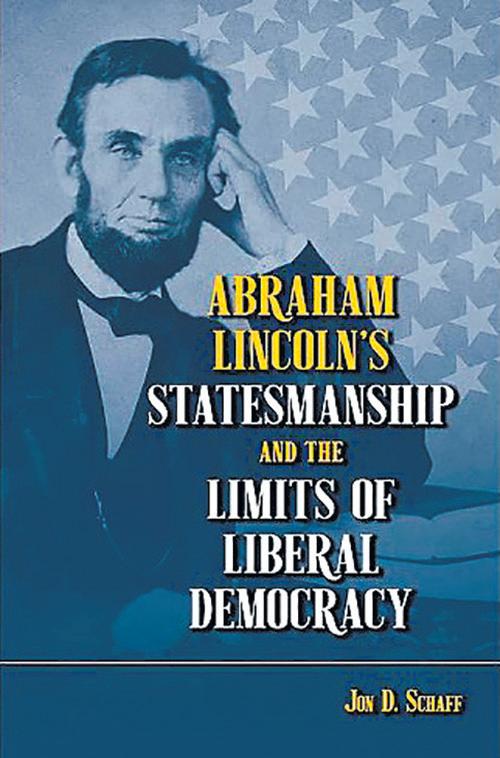
Reviewed by Meg Groeling
another angle. Even without the war, Lincoln firmly believed that Congress should make public policy, not executive whim. In the president’s opinion, the elected representatives of the people should not be lobbied in any way we would recognize today.
Americans whose vision of the founding ideas of a nation was already dimming. (5)



If you are a regular Civil War buff looking for a book to toss into the backpack and take to the beach, Jon D. Schaff’s Abraham Lincoln’s Statesmanship and the Limits of Liberal Democracy is not the book you are seeking. This intellectually demanding study looks at the presidency of Abraham Lincoln, defining the changes in government power, economic power, and executive power as they evolved beginning even earlier than 1860. Author Schaff brings the changes Lincoln brought to the office of the presidency up to present times and compares those changes from Lincoln to later executives, including Trump.
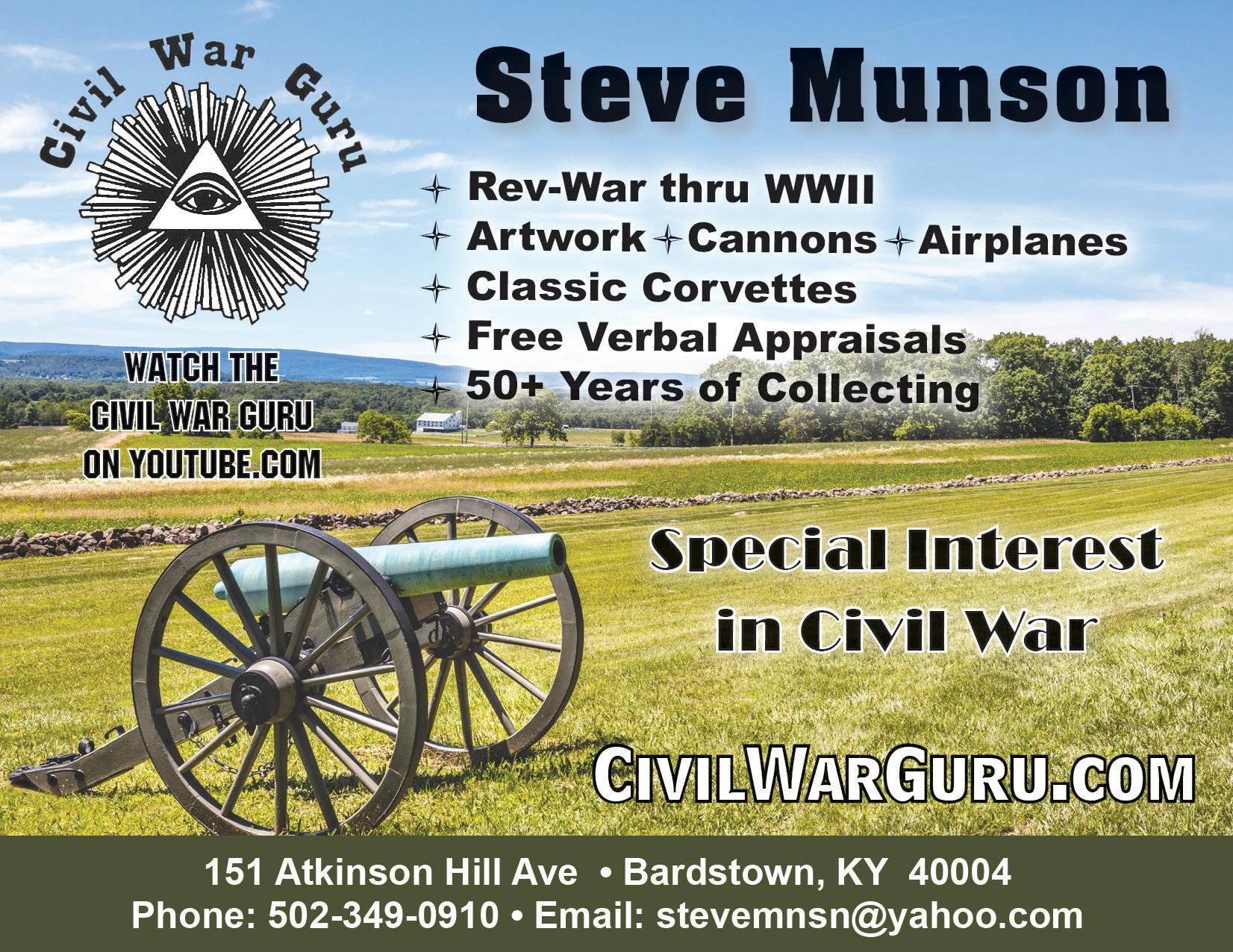
Usually remembered in connection with the Civil War, Lincoln’s presidency is known for the successful defense of the Union and a redefinition of Presidential wartime powers. This book looks at Lincoln’s presidency from
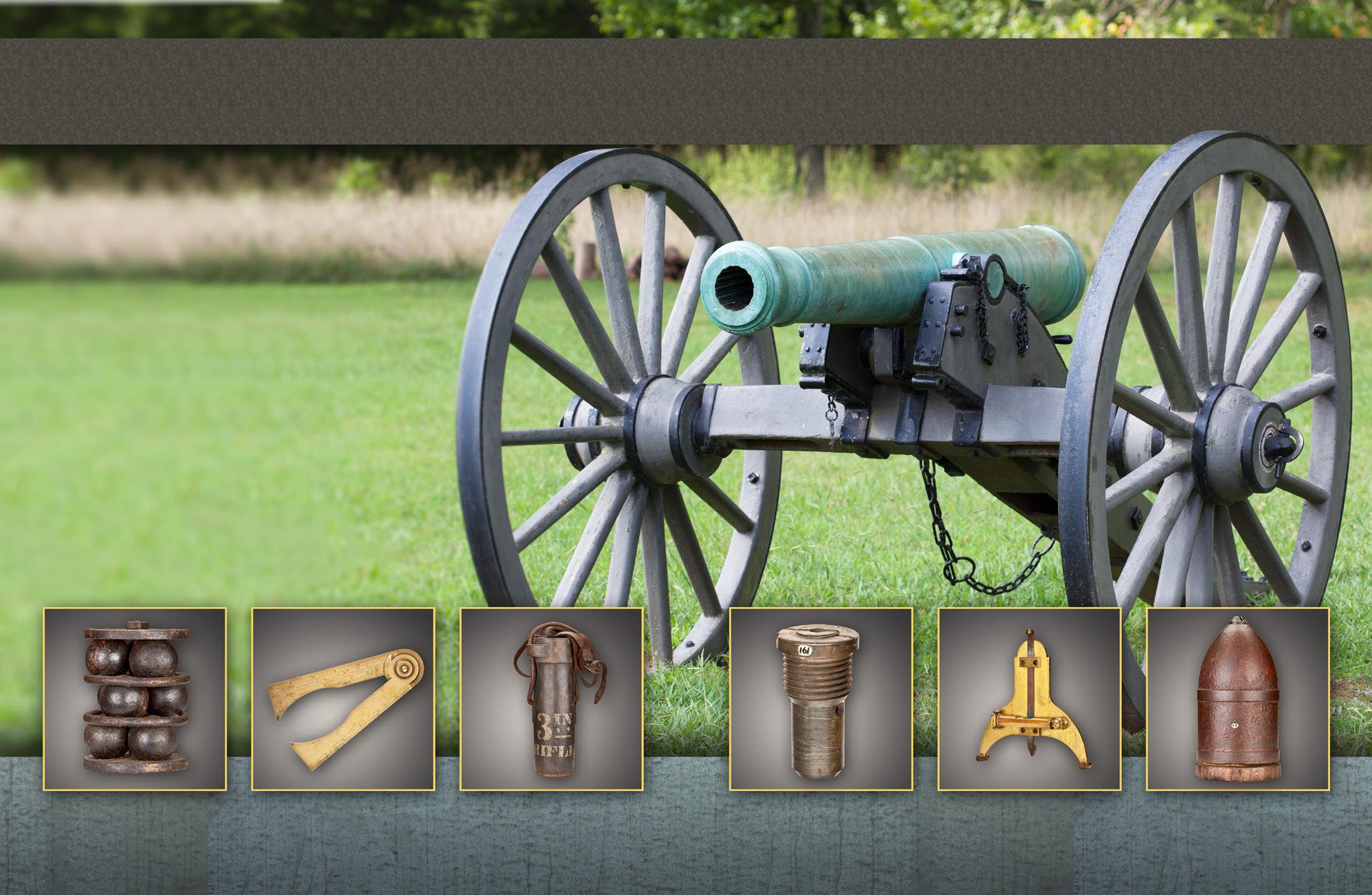
Schaff, a professor of political science at Northern State University in Aberdeen, S.D., highlights Lincoln’s significance in the development of American power institutions and social movement politics. He explains how Lincoln’s views on prudence, natural rights, and economics all contain the notion of limits. Were America to be a country ruled entirely by “the people,” then mob rule would take precedence over moderation; because wealth speaks loudest, the government must protect the natural rights of all citizens, especially those with limited means. Reining in presidential power and trusting in elected representation can go far in containing the scope of abuse.
Beginning with Lincoln’s earliest political utterances and actions, author Schaff builds his case that Lincoln stood for balance and statesmanship. Moderate, prudent policies would best serve an American democracy rather than overdependence on the will of the people and the power of institutions. Schaff goes toe-to-toe with previous historians’ views concerning Lincoln’s record. In essence, he quotes and argues with Harold Holzer, Richard Striner, James McPherson, Thomas Di Lorenzo, and James Randall. Abraham Lincoln’s Statesmanship and the Limits of Liberal Democracy discusses where Lincoln and Hamilton agree and disagree:
In Lincoln’s case, he needed to explain natural rights, the rule of law, and the role of the presidency to a new generation of
Lincoln was initially a member of the Whig party, created in its second iteration in the 1830s to oppose Democrat Andrew Jackson. The ideas of Henry Clay and Daniel Webster defined Lincoln’s initial view toward the powers of government. Lincoln’s personal opinions changed as he served a term in Congress as an Illinois representative (1847–49) and practiced law. In 1854 Lincoln reentered politics as a leader of the Illinois Republican Party. His ongoing arguments with senator Stephen Douglas and the speech at New York’s Cooper Union not only brought him to national attention but further defined his political personality. After clearly laying this groundwork, Schaff then compares Lincoln’s views on government to the defense of unlimited government by twentieth-century progressives. A “distributive” policy dominated the nineteenth century. It dealt mostly with rivers and harbors, defense procurement, research and development (think “patents!”), labor business, agriculture, and tariffs. The government distributed goods to client groups. Within this environment, patronage and pork flourished, although it may be considered a “win-win” situation. Schaff’s unique exploration falls between historians who consider Lincoln an early progressive and those who say his presidency foreshadowed industrial, corporate America.
As author Schaff works his way through convoluted mid-nineteenth-century political thought, he never loses sight of the

domestic policies that had little to do with the Civil War. Lincoln’s Congress gave America the Transcontinental Railroad, the Homestead Act (westward settlement), the Pacific Railroad Act, the Land-Grant College Act, the Legal Tender Act, and the National Bank Act. He quotes historian James Randall: “Lincoln believed in planting, cultivating, and harvesting, not in uprooting and destroying.” Schaff also never loses sight of Lincoln’s slavery politics. He puts them into context:
When the white man governs himself that is self-government; but when he governs himself and also governs another man, that is more than self-government-that is despotism. If the negro is a man, why then my ancient faith teaches me that “all men are created equal;” and that there can be no moral right in connection with one man’s making a slave of another. (62).
Schaff’s book, Abraham Lincoln’s Statesmanship and the Limits of Liberal Democracy rejects the idea that Lincoln was a revolutionary. It urges instead that Lincoln preferred limited presidential power, particularly compared to today’s definition. It is statesmanship that emerges as the guide to examining Lincoln the politician. America was at a crossroads just as Lincoln was elected. It was Lincoln’s political view and adherence to the values of the Declaration of Independence that helped a broken country navigate back to Union. Today Lincoln’s example could be used as a model for a better way of defining political roles
in a democracy. Jon Schaff’s book is not a quick or easy read, but it is one to which the reader can return time and again for guidance and clarification. Abraham Lincoln’s Statesmanship and the Limits of Liberal Democracy is not a relaxed or casual read. It is, however, worth the effort.
Meg Groeling received her Master’s Degree in Military History, with a Civil War emphasis, in 2016, from American Public University. Savas Beatie published her first book, The Aftermath of Battle: The Burial of the Civil War Dead, in the fall of 2015. Her biography, First Fallen: The Life of Colonel Elmer Ellsworth, the North’s First Civil War Hero. It will be published by Savas Beatie in 2020. She is a book reviewer for LSU, Civil War News, and a regular contributor to the blog Emerging Civil War. She lives in Hollister, California in a 1928 bungalow with her husband, her cats, and a lot of books and roses.
Want
43 September 2020 CWN Buying, Selling and Brokering Jack Melton 520 Folly Rd, Suite 25 PMB 379 Charleston, SC 29412 jack@jackmelton.com 843-696-6385 Let me help connect you with a buyer or seller. I specialize in cannon, projectiles, fuses and wrenches, implements, sights, gunner’s equipment, tools, and other artillery related equipment. From single items to collections. Finders Fees Paid. Purveyor of Original Artillery Items
News? Email us at ads@civilwarnews.com Call 800-777-1862 CW N Inside this issue: Day Remembrance Day, 2019, GettysburgThe world will little note, nor long remember what we say here, but can never forget what they did here. –----
To Advertise In Civil War
H Stuart
from page 39
their riders. The Virginias lost one man killed and eight captured along with their battle flag. The Eighth Illinois pursued the Twelfth Virginia to Barnesville where the Virginians were driven further west with the loss of one killed, eight captured, and several wounded.
On a different road to the north, another detachment of the Eighth Illinois under Captain George M. Kelly engaged a separate group of Rebels and drove them through Barnesville and two miles beyond. The Confederates lost five men wounded and fifteen captured.11
The same day, a squadron of the First New York Cavalry led by Major A.W. Adams charged into Hyattstown and drove out a detachment of Wade Hampton’s Brigade. Hampton’s men returned the next day with artillery support to reclaim the town but were driven off by the New Yorkers reinforced by the First U.S. Cavalry under Captain Marcus A. Reno.12
On Sept. 10, Captain William P. Sanders, Sixth U.S. Cavalry, supported by two guns from the horse artillery, attempted to reoccupy Sugar loaf Mountain and capture the Confederate signal station operating on its summit. Their advance struck an advanced position commanded by Captain Waller of the Ninth Virginia Cavalry and captured a ten man picket post. The Virginians fell back to the base of the mountain.13
General Fitzhugh Lee and the balance of the Ninth Virginia joined Captain Waller’s men and succeeded in turning back the Yankees. Captain Sanders then dismounted his troopers and renewed the battle on foot. Only one squadron of the Ninth Virginia was armed with carbines while the entire Union force was equipped with both carbines and side arms. Lee ordered the men with carbines to take positions on the wooded slope of the mountain while the remainder remained mounted and covered their flanks. Firing from behind rocks
and trees, the Southerners were able to hold on until darkness put an end to the fighting. That night Lee led the Ninth Virginia west towards Frederick.14
The morning of Sept. 10, Captain William P. Sanders attempted to drive Colonel Munford off Sugar Loaf Mountain but was repulsed with one man killed and four wounded. The next day Colonel Farnsworth led his brigade against Munford supported by Winfield Scott Hancock’s Brigade of infantry. This was the largest force thrown against Stuart’s line to date. McClellan’s advance was closing in on Lee’s army. The I Corps was at Triadelphia. The II and XII Corps were far as Clarksburg.
To defend his position Munford had only two depleted regiments, the Second and Twelfth Virginia and four guns from Chew’s battery, in all about 500 men. After skirmishing for several hours, Munford was forced to let the Yankees have their signal station back and withdrew to Urbana.15
The same morning, Daniel Harvey Hill’s Division left Monocacy Junction and marched through Frederick City following the rest of Lee’s army, who had departed the day before. By noon only Confederate cavalry remained south and east of the city. As the bulk of Stuart’s command shifted north and west, Hampton’s Brigade headed for Frederick City and Munford took up outpost duties at Hyattstown.
At 1:30 p.m. Major Adams with the First New York Cavalry and a squadron of regulars from the First US Cavalry commanded by Captain Marcus A. Reno charged into Hyattstown but were repulsed by Lieutenant Dan Shunk’s section of horse artillery and Munford’s undersized brigade. When the Union cavalry withdrew to Clarksburg, Munford fell back to the Monocacy where the wooden bridge for wagon and pedestrian traffic was still standing. Chew’s Battery covered the bridge supported by the cavalry on either side of the road. Munford remained there until ordered to take up a new position in the village of Jefferson in the
Civil War Artillery Book
New 392 page, full-color book, Civil War Artillery Projectiles –The Half Shell Book.

For more information and how to order visit the website www. ArtillerymanMagazine.com or call 800-777-1862.
$89.95 + $8 media mail for the standard edition.
nearby Catoctin Mountains on Sept. 12.16
Union infantry would soon be on the field in great numbers. The Kanawha Division formed the van of the IX Corps. It marched through Damascus and camped at Ridgeville. The rest of the corps could be found between there and Hyattstown. The II Corps was at Clarksburg; the Twelfth had stopped at Damascus. Fitzhugh Lee was forced to give up New Market on Sept. 11. As the day came to a close, Captain James Abraham’s Independent Company of West Virginia Cavalry entered the east side of New Market as the last Confederate videttes exited the western side.
When Fitzhugh Lee abandoned New Market, he retreated to Liberty and crossed the Monocacy River north of Frederick the next morning only to have Stuart order him back over the river to scout the Union Army’s right flank. He led his brigade as far north as Westminster where he charged into the town and captured the Provost Marshal. After damaging a bridge on the Western Maryland Railroad and throwing a first class scare into the mostly pro-Union residents, Lee retired across the Monocacy. His actions forced General Pleasanton to send one brigade as far north as Gettysburg to make sure the Confederates were not trying to make an end run around the Union right flank.17
The last action before the Confederates evacuated Frederick City occurred on Sept. 12. Wade Hampton formed the rear guard of the Cavalry Division and the Army of Northern Virginia. He wisely gave up New Market to the advancing IX Corps and fell back to the Monocacy. Here he made a stand with two guns covering the bridge with cavalry on both sides of the road. At this time Hampton had two squadrons south of the city guarding the pedestrian bridge where Munford’s Brigade was now in danger of being cut off. To help slow down the Union advance, he added one rifled gun supported by a squadron from the Second South Carolina to the force at the stone bridge. Kegs of power were placed on the bridge in hopes of blowing it up.
When Captain Abraham’s Company of West Virginia cavalry approached the bridge, the Confederate pickets retreated to the west side and set off the powder which made a great deal of smoke and noise but failed to damage the bridge. Two companies of Union cavalry then charged the bridge but were forced back by the Rebel artillery. At this point Simmonds’
Kentucky Battery arrived with two 20-pounder Parrott rifles and a 12-pounder Napoleon smoothbore. Lieutenant Abraham led his cavalry downstream and crossed so he could outflank the Confederate artillery. At the same time the two 20-pounders opened fire. With one gun out of action the Confederates retreated into the city. By 2 p.m. Cox’s Division was on the scene.18
A squadron of the Second South Carolina under Lieut. John Meighan skirmished with the advancing infantry losing two men before being ordered to fall back. Hampton withdrew his artillery and posted it to cover the road from Frederick to the Catoctin Mountains. Colonel August Moor’s Brigade, crossed the bridge and followed the Rebels into the city with a detachment from the Chicago Dragoons and one gun. Hampton ordered Meighan’s Squadron to charge the Yankees and sent them flying down East Patrick Street. Colonel Moor and seven men were captured. In attempting to escape, one trooper ran over an artilleryman who failed to release the lanyard and fired a round of canister at point blank range into his own men. Eight Yankee cavalrymen hit the ground in a heap. The gunners limbered up to avoid being captured only to overturn their gun. Unable to bring off the cannon, Stuart’s men shot the horses and retreated back into Frederick.
On the Union left, Farnsworth led his brigade supported by two batteries of horse artillery from Sugar Loaf Mountain toward Frederick City via Urbana. As Hampton and the last remnants of the Confederate Army exited Frederick, Colonel Augustus H. Coleman led his Eleventh Ohio Infantry into the city. The Rebels were gone, but they would be back in 1864.19
Endnotes:
1. D. Scott Hartwig, To Antietam Creek: The Maryland Campaign of September 1862, (Baltimore: 2012), p. 104
2. R.L.T. Beal, History of the Ninth Virginia Cavalry, (Richmond: 1899), p. 37; Ezra J. Warner, Generals in Blue, (Baton Rouge: 1972), p. 373.
3. OR’s, Vol. 19, Part 1, pp. 814815; Ezra Carman, The Maryland Campaign of September 1862, Edited by Thomas G. Clemens, (New York), Vol. 1, p. 92.
4. Paul & Rita Gordon, A Playground of the Civil War: Frederick Country, Maryland, (Frederick, MD: 1994), pp. 4548: OR’s, Vol. 19, Part 2, p. 568; Carmen, p. 132; Daniel Carroll Toomey, The War Came By Train: The Baltimore and Ohio
Railroad During the Civil War, ( Baltimore: 2013), p. 123.
5. OR’s, Vol. 19, Part 1, p. 815.
6. OR’s, pp. 117-118; J. Willard Brown, The Signal Corps, USA in the War of the Rebellion, (Boston: 1896), Butternut and Blue reprint, 1996, pp. 241, 242, 325; Carman, pp. 176-177.
7. OR’s, Vol. 19, Part 1, pp. 208209; Vol. 51, Part 1, pp. 136137; Carman, p. 165.
8. Carman, p. 169.
9. Abner Howard, M.D., History of the Eighth Cavalry Regiment Illinois Volunteers…, Morningside Bookshop reprint (Dayton: 1984), pp. 171-172; OR’s, Vol. 19, Part 1, pp. 208, 825.
10. Beal, p. 37; Hartwig, p. 174175; James A. Davis, “JEB Stuart’s Sabers & Roses Ball,” Catoctin History #10, p. 24.
11. OR’s, Vol. 19, Part 1, pp. 208209; Daniel Carroll Toomey, The Civil War in Maryland, (Baltimore: 1983), p. 49; Howard, p. 172
12. Carman, pp. 167-168.
13. OR’s, Vol. 19, Part 1, p. 209; Carman, pp. 176-177.
14. Beal, pp. 37-38, Carman, p. 176
15. Carman, pp. 177, 179; Harsh, p. 188; OR’s, Vol. I, p. 815.
16. Carman, 179; Harsh, p. 206.
17. Carman, pp. 187-188; OR’s, Vol. 19, pp. 815-816; Harsh, pp. 188, 205.
18. Carman, p. 186; OR’s, Vol. 19, Part 1, pp. 822-823.
19. Bradley T. Johnson, “address on the First Maryland Campaign” Southern Historical Society Papers, (Kraus Reprint Co.: 1977), Vol. 12, pp. 516-517; Carman, p. 187; OR’s, Vol. 19, Part 1, pp. 822-823.
Daniel Carroll Toomey, is a University of Maryland graduate. Mr. Toomey has authored several books on the Civil War including, The Civil War in Maryland, Marylanders at Gettysburg, and The Maryland Line Confederate Soldiers’ Home. He is also co-author of Baltimore During the Civil War, and Marylanders in Blue, all of which were published by Toomey Press. He has lectured for a number of historical organizations, as well as for the National Park Service and the Smithsonian Institution. He has also contributed to radio and television programs, and on two Civil War battle videos. Mr. Toomey is a member of the Surratt Society, the Maryland Arms Collectors Association and the Company of Military Historians, and was project historian for the Maryland Memorial erected at Gettysburg in 1994 and wrote the inscription for that monument.
44 CWN September 2020
. . . . . . . . .
.






The 2020 Civil War Dealers Directory is out. To view or download a free copy visit: www.civilwardealers.com/dealers.htm
The 2020 Civil War Dealers Directory is out. To view or download a free copy visit: www.civilwardealers.com/dealers.htm








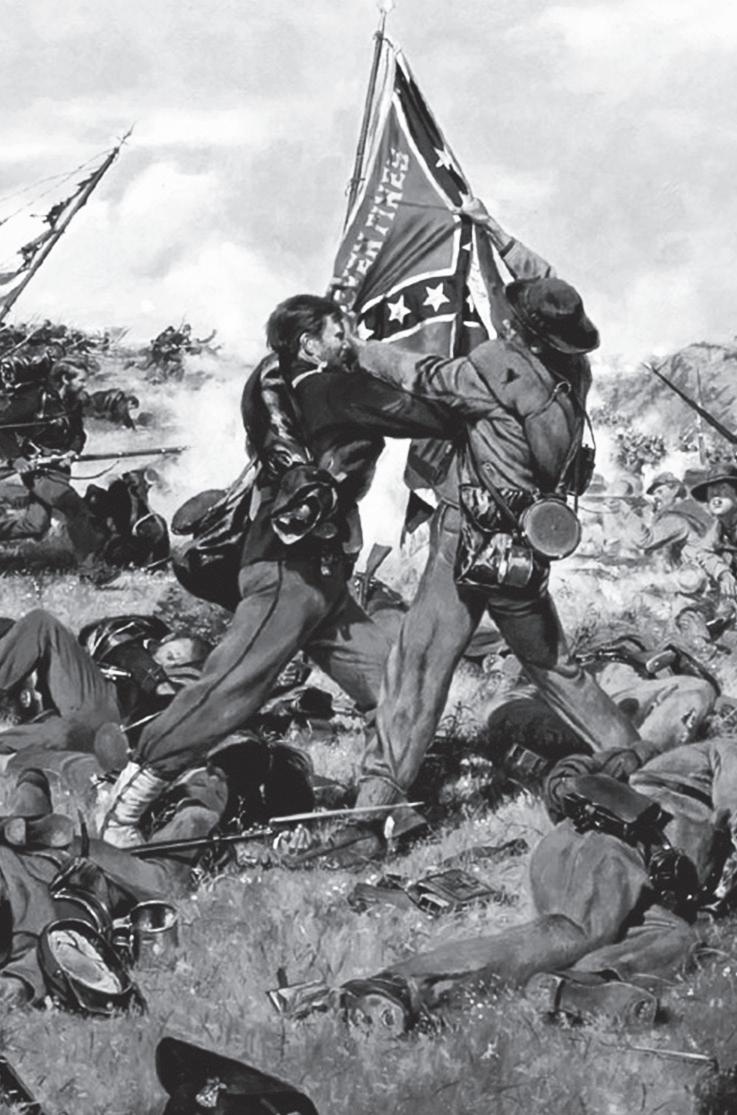



















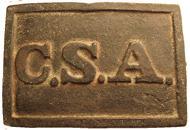

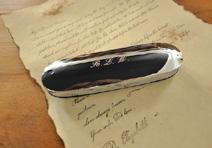


















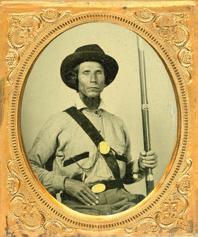



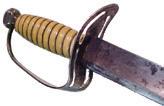









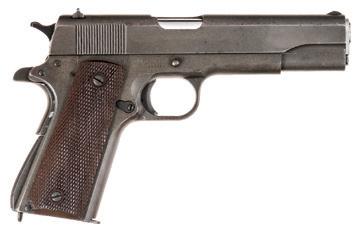



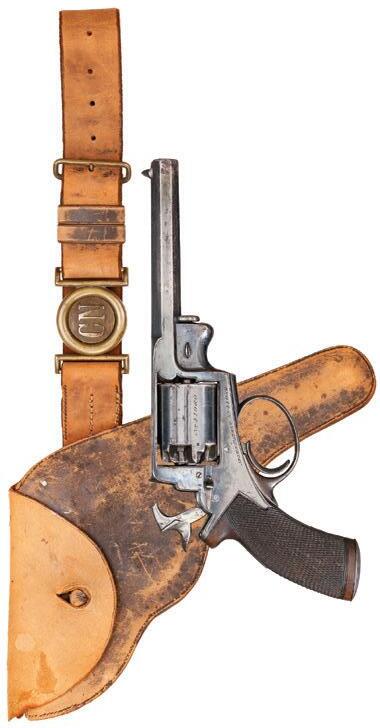


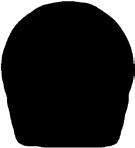








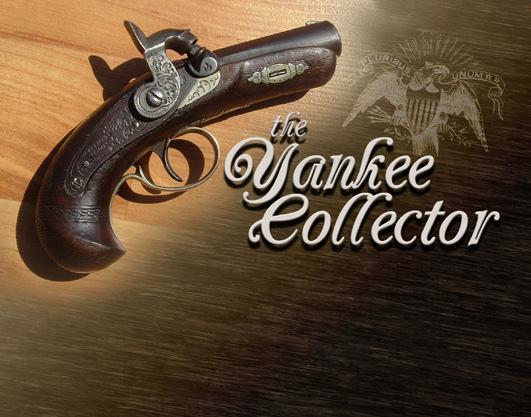



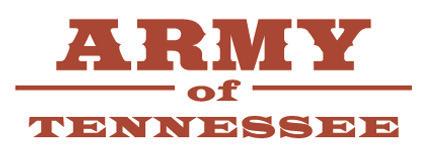















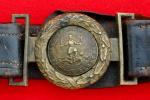
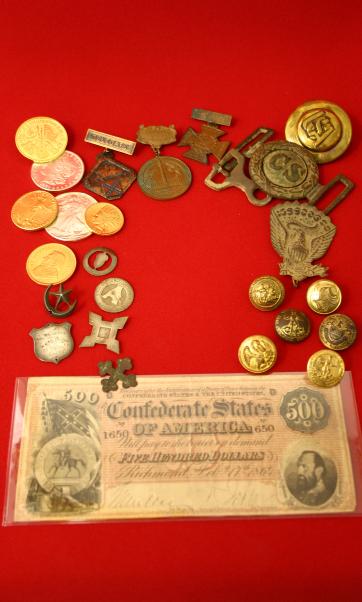
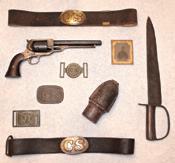

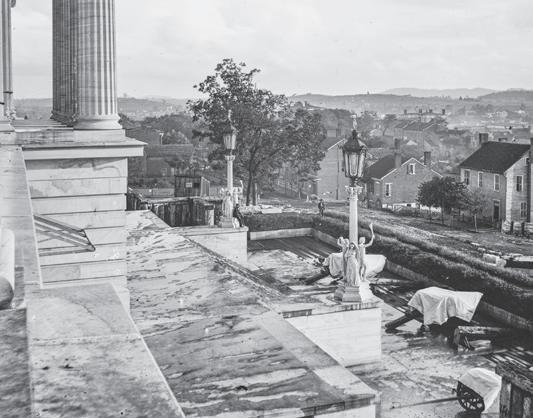




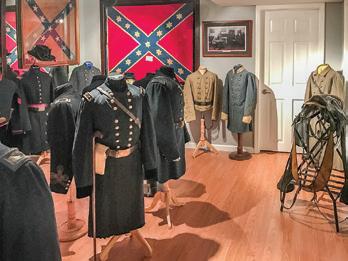



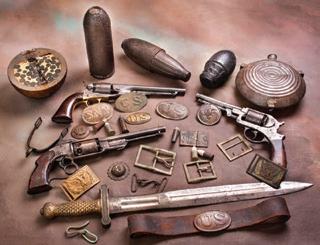











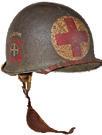

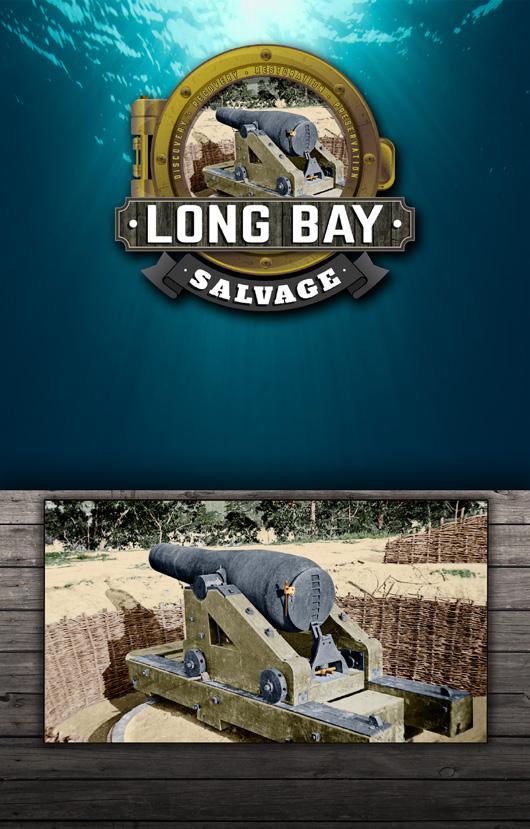



46 CWN September 2020 CivilWarShop.com Offering the Finest Investment Grade Military Memorabilia since 1981 Buy – Sell – Trade Certified Appraisal Services Life Member Company of Military Historians Lynn and Will Gorges, Proprietors 3910 US Hwy. 70 East New Bern, NC 28560 (252) 636-3039 • civilwarshop@gmail.com www.CivilWarShop.com Long Bay Salvage LLC specializes in the recovery and restoration of authentic Civil War Cannon with an emphasis on 10-Inch Columbiads, what has become a rare piece of Civil War history. Long Bay Salvage also works with historical entities (government and private) to recover and conserve large historical artifacts with a specialty in large field and naval artillery pieces. Glenn Dutton 770-351-7565 Rufus Perdue Perdue 843-315-9818 PLEASE CONTACT US FOR MORE INFORMATION www.LongBaySalvage.com Promoters of Quality Shows for Shooters, Collectors, Civil War and Militaria Enthusiasts Military Collectible & Gun & Knife Shows Presents The Finest Mike Kent and Associates, LLC • PO Box 685 • Monroe, GA 30655 (770) 630-7296 • Mike@MKShows.com • www.MKShows.com Northwest Georgia Trade Center 2211 Dug Gap Battle Road Dalton, GA 30720 February 1 & 2, 2020 Chickamauga (Dalton) Civil War Show Williamson County Ag Expo Park 4215 Long Lane Franklin, TN 37064 December 5 & 6, 2020 Middle TN (Franklin) Civil War Show l Shiloh Buying & Selling Authentic Civil War Artifacts 2405 Oak Grove Road Savannah, TN 38372 731-438-3541 ShilohRelics.com History@shilohrelics.com owner Rafael Eledge .com Dealing in the Finest Authentic Militaria Since 1995 with an Emphasis on the American Civil War Pistols, Muskets, Carbines, Rifles, Bayonets, Swords, Uniforms, Headgear, Belt Buckles, Cannon, Buttons, Bullets, Artillery Implements Etc. MidWestCivilWarRelics.com Bowie Knifes, Civil War Swords, Confederate D-guards, Antique Firearms, Dug Relics, Buckles & Belts, Identified Relics, Letters, Documents, Images, Currency, Uniforms, Head Gear & Flags. 3500 Shacklett Rd • Murfreesboro, TN 37129 tom@stonesrivertrading.com • (615) 336-2188 StonesRiverTrading.com Tom Hays Proprietor We carry all types of relics, dug & non-dug, Confederate & Federal. 100% Guaranteed. A strong emphasis on dug relics, but also a full line of non-dug relics of all types. Over 30 years experience with a full time, online store since 1997. We also have a shop located five miles from Stones River National Battlefield that is open by appointment. www.CollegeHillArsenal.com Tim Prince College Hill Arsenal PO Box 178204 Nashville, TN 37217 615-972-2418 Mid West Civil War Relics MidWestCivilWarRelics.com Allen Wandling Phone: 618-789-5751 Email: awandling1@gmail.com Museum Quality Civil War Union & Confederate Artifacts! We handle the Best Antique Bowie Knifes, Civil War Swords, Confederate D-guards, Antique Firearms, Dug Relics, Buckles & Belts, Identified Relics, Letters, Documents, Images, Currency, Uniforms, Head Gear & Flags. Preston Bain Nashville, TN (615) 397-5186 www.NashvilleRelics.com Nashville Civil War Relics “Old times there are not forgotten” Coles Civil War Shop.com Come by and see me at the shop or place an order online. email hmcole2@comcast.net Mac Cole 13119 River’s Bend Blvd. Chester, Va 23836 wk - 804-681-0945 cell-804-314-9940 Hours Mon - Fri 10-5 Sat - 10-3 P.O. Box 342 Thompsons Station, TN 37179 615-585-0115 Email: brubon2@bellsouth.net Franklin Relics www.AmericanRelics.net Allen Phillips 1014 Reservoir St., Suite B Harrisonburg, VA 22801 A P.O. Box 342 Thompsons Station, TN 37179 Email: brubon2@bellsouth.net Franklin Relics Specializing in Accoutrements, Edged Weapons, Firearms and Uniforms FranklinRelics.com Bruce Hohler Proprietor Specializing in Buttons, Buckles, Currency, Hat Devices and other Military Artifacts. www.AmericanRelics.net Allen Phillips 1014 Reservoir St., Suite B Harrisonburg, VA 22801 American Relics Phone: 540-476-1969 Email: americanrelicsnet@gmail.com www.CivilWarBadges.com Everitt Bowles, Owner • 770.926.1132 1036 Washington Avenue Woodstock, Georgia 30188 The Largest Selection of GAR & UCV Hundreds of Memorabilia Items from Rev War through Vietnam Secure & Easy Guaranteed Authenticity of Every Item 8895 Town and Country Circle • Knoxville, TN 37923 Phone: 865-693-3007 info@armyoftennesseerelics.com Civil War Artifacts Nick Periut Proprietor ArmyofTennesseeRelics.com Buying and Selling High Quality Images, Belt Buckles and Plates, Artillery Shells, rare Bullets and Buttons! Richard Gersten (708) 786-8630 PO BOX 31113, CHICAGO, ILLINOIS 60631 www.YankeeCollector.com Specializing in Early Americana, Civil War American Indian, Old West, WW I & II Guns, Swords & Memorabilia www.uniondb.com 34 York St Gettysburg, PA 17325 Phone: 717-334-2350 • Email: bsynnamon@gmail.com Specializing in Authentic Civil War Artifacts The Union DrUmmer Boy A Museum Where You Can Shop! Contact Glenn Dutton at: glennjdutton@aol.com or 770-351-7565 BUYING & SELLING Field & Heavy Artillery Cannon, Shells, Fuses & Etc. Rare Accoutrements Michael Simens HistoricalArms.com Tel: 440-744-9088 mail@HistoricalArms.net The Only Complete Beaumont-Adams CS Naval Rig Michael Simens HistoricalArms.com Tel: 440-744-9088 • mail@HistoricalArms.net Magnificent Swords Georgia Presentation To William J. Hardee. Later Confederate Lieut. General. We Buy, Sell, Authentic And Appraise World-Class Historical Artifacts Fine Antiques & Militaria Military Items 1650-1945 Armor Swords Firearms Bayonets Equipment Accoutrements www.csarms.com PO Box 602 9150 John S. Mosby Hwy. Upperville, Virginia 20185 Shop Phone: 540-592-7273 Email: sophiacsarms@aol.com C.S. Arms, Inc. Specialize in U.S. & British Militaria www.OldSouthAntiques.com Old South Antiques, THE CONFEDERATE Old South Antiques, LLC Hickory Hill Mansion, 9222 Wickham Manor Way, Ashland, VA 23005 CARSON SQUEEGIE JENKINS 321.505.7524 WWW.SQUEEGIE.NET DESIGN SERVICES PRINT MEDIA ILLUSTRATIONS CORPORATE BRANDING PRINT & MAGAZINE ADS LOGO DESIGN TEXTILE/ T-SHIRTS EVENT POSTERS BUSINESS CARDS 3D RENDERINGS MARKETING NEW BUSINESS START-UP PACKAGES AVAILABLE The Historical Shop Margaret & Cary Delery Box 73244 Metairie, LA 70033 Phone: 504-467-2532 c.j.delery@att.net www.historicalshop.com Since 1978 selling rare Americana Historical Shop The e Early American items through the Civil War artifacts, autographs, photography, currency, bonds, historical displays, military items, and more…… P.O. Box 160 • Kingston, TN 37763 Phone: 803-431-1798 Email: vann@veteransattic.com www.VeteransAttic.com Vann Martin United Confederate Veterans, Grand Army of the Republic, Civil War Photographs and other Civil War items. David K. Parks Military Antiques PO Box 180674 Utica, MI 48318-0674 Phone: 586-871-6462 Email: dkpma@comcast.net Offering a large selection of Civil War and Historical Memorabilia ranging from the Revolutionary War to World War (emphasis on the American Civil War). On line catalog regularly offers over 700 items from nearly every category of collecting. www.RelicsOfHistory.com Civil War Military Longarms a Specialty ConfederateArmsCompany.com 1209 Victor II Blvd., Morgan City, La. 70380 Cell: 985-518-1802 • Email: leegray@LHprinting.com Lee Gray Confederate Arms Company PO Box 129 Dover, TN 37058 Buying & Selling: Images Artillery Firearms Dug Relics Edged Weapons Non-dug Artifacts John & Nikki Walsh Fort Donelson Relics FortDonelsonRelics.com Full Line Civil War Artifact Dealer Email: john@fortdonelsonrelics.com vann@veteransattic.com www.VeteransAttic.com United Confederate Veterans, Army of Republic, Civil War Photographs other Civil items. War and Historical Revolutionary War American Civil offers over 700 of collecting. www.RelicsOfHistory.com “Reproduction Antique Spectacles to suit all sights” Authentic reproduction Civil War era eyeglasses to fit your lifestyle. Historically accurate, ophthalmic quality eyeglass frames suitable for reading, distance, bifocals, progressive lenses, sunglasses & nonprescription tinted lenses. Made for full time wear. “Spectacles are most overlooked, most obvious way to spoil an otherwise fine impression.” Thomas Valenza, Optician When you are ready to complete your impression, visit us online for detailed information about our spectacles: www.HistoricEyeWearCompany.com Prices start at $139.95 862.812.4737 Left: Unidentified Union soldier wearing oblong spectacles (Library of Congress) Above Right: First Lieutenant Adam J. Slemmer, defender of Fort Pickens (U.S. Army Heritage & Education Center) The Best Civil War Era Spectacles Buying and Selling original Civil War Confederate & Union Buttons, Belt Buckles, and Accoutrements. NCCivilWarRelics.com PO Box 2122 Morehead City, NC 28557 Phone: 252-671-7770 Email: sales@nccivilwarrelics.com or AGaskins1@ec.rr.com Allen Gaskins North Carolina Civil War Relics Robert Jones • 119 Frances Ave. • Stanhope, NJ 07874 Phone: 973-810-2976 • Email: Bob33rd@optonline.net We sell original Civil War artifacts, both excavated and non-excavated. There is also a selection of mid-19th century antiques. Yankee Rebel Antiques www.YankeeRebelAntiques.com Proprietor, Robert Jones, is the author of seven books on Civil War subjects: The Civil War Canteen Civil War Artillery – A Pictorial Introduction Children at the Battle of Gettysburg –Their Unforgettable Summer The Civil War Canteen Second Edition, Battle of Gettysburg –The Relics, Artifacts & Souvenirs, The Civil War Soldier – His Personal Items, War Canteen – Third Edition He has also written articles for North/South Trader Civil War magazine. Order his books online at http://www.lulu.com/spotlight/civilwarbooks Promoters of Quality Shows for Shooters, Collectors, Civil War and Militaria Enthusiasts Military Collectible & Gun & Knife Shows Mike Kent and Associates, LLC • PO Box 685 Monroe, GA 30655 (770) 630-7296 • Mike@MKShows.com • www.MKShows.com February 1 & 2, 2020 Chickamauga (Dalton) Civil War Show November 14 & 15, 2020 Capital of the Confederacy Civil War Show December 5 & 6, 2020 Middle TN (Franklin) Civil War Show l l Firearms & Militaria Auctioneers or Better! On Expensive Items and Valuable %0 Seller’s Commission The Tradition Continues - New Facility, Same Family and Great Location We are pleased to announce the purchase of the former Auction Facility of World-Renowned Hall-of-Fame Auctioneer James Julia. compounds in the industry with nearly 50,000 square feet of climate controlled and secured space dedicated to the promotion, presentation and handling of fine firearms collections. Our Fall 2019 Firearm Auction generated nearly $5.5 Million in sales for our consignors - Our largest to date! Call our offices to be part of our next Premier Firearms Auction Consignments Now Being Accepted 199 Skowhegan Rd Fairfield, ME 04937 207-453-2114 civilwar@poulinauctions.com Website: poulinauctions.com Stephen Poulin, ME Lic 1115 Presentation Sword of Gettysburg Hero General Alpheus Williams (est. $20,000 30,000) Sold $41,125 Sold $41,125 Rigdon & Ansley Confederate Revolver Carried By Captain Luther M. Clements, Co. F, 41st Alabama (Est. $25,000-35,000) Unique 1864 Sold $7,635 Sold $41,710 Sold $36,425 Confederate Keen-Walker Brass Frame Breech Loading Percussion Carbine (Est. $20,000-30,000) Sold $23,500 Sold $23,500 Fine Cook & Brother Athens Georgia Confederate Percussion Carbine (Est. $20,000-25,000) ROCK ISLAND AUCTION COMPANY REAL ART REAL HISTORY REAL IRON Street West, Rock Island, IL 61201 Exceptional Springfield Armory Rare and Exceptional Double Cased Pair of Early Squareback Factory Engraved Colt 1860 Army Patriotic Lady Liberty Carved Grip, Case and
THE FINEST HISTORICAL ANTIQUE MILITARIA Wallace Markert info@csacquisitions.com 16905 Nash Road • Dewitt, Virginia 23840 804-536-6413 • 804-469-7362 www.csacquisitions.com
$38.50 - 1 year USA Print $48.50 - 1 year USA Print & Digital
- 2 year USA Print $86 - 2 year USA Print & Digital
- 1 year Digital only
Payment Enclosed
Terms and Conditions
The following terms and conditions shall be incorporated by reference into all placement and order for placement of any advertisements in Civil War News by Advertiser and any Agency acting on Advertiser’s behalf. By submitting an order for placement of an advertisement and/or by placing an advertisement, Advertiser and Agency, and each of them, agree to be bound by all of the following terms and conditions:
1. All advertisements are subject to acceptance by Publisher who has the right to refuse any ad submitted for any reason.
2. The advertiser and/or their agency warrant that they have permission and rights to anything contained within the advertisement as to copyrights, trademarks or registrations. Any infringement will be the responsibility of the advertiser or their agency and the advertiser will hold harmless the Publisher for any claims or damages from publishing their advertisement. This includes all attorney fees and judgments.
3. The Publisher will not be held responsible for incorrect placement of the advertisement and will not be responsible for any loss of income or potential profit lost.
4. All orders to place advertisements in the publication are subject to the rate card charges, space units and specifications then in effect, all of which are subject to change and shall be made a part of these terms and conditions.
5. Photographs or images sent for publication must be high resolution, unedited and full size. Phone photographs are discouraged.
6. At the discretion of Civil War News any and all articles will be edited for accuracy, clarity, grammar and punctuation per our style guide.
7. Articles can be emailed as a Word Doc attachment or emailed in the body of the message. Microsoft Word format is preferred. Email articles and photographs: mail@civilwarnews.com
47 September 2020 CWN Advertisers In This Issue: 100 Significant Civil War Photographs: Atlanta 14, 39 100 Significant Civil War Photographs: Charleston 13, 39 American Battlefield Trust 11 American Digger Magazine 13 Ace Pyro LLC 35 Artilleryman Magazine 27 Brian & Maria Green 2 Carolina Antique Arms 16 Casteel Sculptures 8 Civil War Guru 43 C.S. Acquisitions 27 CS Arms 17 Civil War Artillery – The Half Shell Book 35 CWMedals.com, Civil War Recreations 19 Civil War Navy Magazine 25 Civil War News 26 Civil War Shop – Will Gorges 33 College Hill Arsenal – Tim Prince 28 Dell’s Leather Works 7 Dixie Gun Works Inc. 27 Fugawee.com 16 Georgia’s Confederate Monuments – Book 32 Gettysburg Foundation 21 Greg Ton Currency 5 Gunsight Antiques 17 Harpers Ferry Civil War Guns 7 The Horse Soldier 9 James Country Mercantile 21 Jeweler’s Daughter 21 Le Juneau Gallery 5 Mike Brackin 4 Military Images Magazine 25 National Museum of Civil War Medicine 25 North South Skirmish Association 35 Owens and Ramsey Booksellers 40 Panther Lodges 19 The Regimental Quartermaster 16, 22 Richard LaPosta Civil War Books 41 Suppliers to the Confederacy – Book, Craig Barry 18 Terry Seltz 22 Trail Rock Ordnance 23 Ulysses S. Grant impersonator – Curt Fields 7, 42 University of Tennessee Press 20 Events: Baltimore Antique Arms Show 2021 23 MKShows, Mike Kent 3, 37 Morphy’s Auctions 15 Poulin Auctions 48 Rock Island Auctions 45
c c c c c c
NAME ADDRESS ADDRESS CITY STATE ZIP CODE EMAIL
Charge my: Discover MasterCard Visa
$66
$29.95
Card
Security Code Name
New Renewal c
c c c c
War News –
Issues
Year
for digital subscription) USA Subscriptions Only No Canada or International Mail to: Historical Publications LLC 520 Folly Road, Suite 25 PMB 379, Charleston, SC 29412
for Advertising or Editorial Submissions is the 20th of each month. Email to ads@civilwarnews.com Subscribe online www.CivilWarNews.com Publishers:
Civil
520
PHONE Required 800-777-1862
Check #
# Exp. Date
on Card
Make checks payable to Historical Publications LLC.
Civil
12
Per
(required
Deadlines
Please send your book(s) for review to:
War News
Folly Road, Suite 25 PMB 379 Charleston, SC 29412 Email cover image to bookreviews@civilwarnews.com Civil War News cannot assure that unsolicited books will be assigned for review.






















































































 by Joe Bilby
by Joe Bilby



































































































 by Shannon Pritchard
by Shannon Pritchard





































 by William Sweeney
by William Sweeney








 by Abigail Lang
by Abigail Lang























 Reviewed by David Marshall
Reviewed by David Marshall























































































































































